
- Inhibitors
- By product type
- Natural Products
- Inducing Agents
- Peptides
- Antibiotics
- Antibody-drug Conjugates(ADC)
- PROTAC
- Hydrotropic Agents
- Dyes
- By Signaling Pathways
- PI3K/Akt/mTOR
- Epigenetics
- Methylation
- Immunology & Inflammation
- Protein Tyrosine Kinase
- Angiogenesis
- Apoptosis
By research - Antibodies
- Compound Libraries
- Popular Compound Libraries
- Customize Library
- Clinical and FDA-approved Related
- Bioactive Compound Libraries
- Inhibitor Related
- Natural Product Related
- Metabolism Related
- Cell Death Related
- By Signaling Pathway
- By Disease
- Anti-infection and Antiviral Related
- Neuronal and Immunology Related
- Fragment and Covalent Related
- FDA-approved Drug Library
- FDA-approved & Passed Phase I Drug Library
- Preclinical/Clinical Compound Library
- Bioactive Compound Library-I
- Bioactive Compound Library-II
- Kinase Inhibitor Library
- Express-Pick Library
- Natural Product Library
- Human Endogenous Metabolite Compound Library
- Alkaloid Compound LibraryNew
- Angiogenesis Related compound Library
- Anti-Aging Compound Library
- Anti-alzheimer Disease Compound Library
- Antibiotics compound Library
- Anti-cancer Compound Library
- Anti-cancer Compound Library-Ⅱ
- Anti-cancer Metabolism Compound Library
- Anti-Cardiovascular Disease Compound Library
- Anti-diabetic Compound Library
- Anti-infection Compound Library
- Antioxidant Compound Library
- Anti-parasitic Compound Library
- Antiviral Compound Library
- Apoptosis Compound Library
- Autophagy Compound Library
- Calcium Channel Blocker LibraryNew
- Cambridge Cancer Compound Library
- Carbohydrate Metabolism Compound LibraryNew
- Cell Cycle compound library
- CNS-Penetrant Compound Library
- Covalent Inhibitor Library
- Cytokine Inhibitor LibraryNew
- Cytoskeletal Signaling Pathway Compound Library
- DNA Damage/DNA Repair compound Library
- Drug-like Compound Library
- Endoplasmic Reticulum Stress Compound Library
- Epigenetics Compound Library
- Exosome Secretion Related Compound LibraryNew
- FDA-approved Anticancer Drug LibraryNew
- Ferroptosis Compound Library
- Flavonoid Compound Library
- Fragment Library
- Glutamine Metabolism Compound Library
- Glycolysis Compound Library
- GPCR Compound Library
- Gut Microbial Metabolite Library
- HIF-1 Signaling Pathway Compound Library
- Highly Selective Inhibitor Library
- Histone modification compound library
- HTS Library for Drug Discovery
- Human Hormone Related Compound LibraryNew
- Human Transcription Factor Compound LibraryNew
- Immunology/Inflammation Compound Library
- Inhibitor Library
- Ion Channel Ligand Library
- JAK/STAT compound library
- Lipid Metabolism Compound LibraryNew
- Macrocyclic Compound Library
- MAPK Inhibitor Library
- Medicine Food Homology Compound Library
- Metabolism Compound Library
- Methylation Compound Library
- Mouse Metabolite Compound LibraryNew
- Natural Organic Compound Library
- Neuronal Signaling Compound Library
- NF-κB Signaling Compound Library
- Nucleoside Analogue Library
- Obesity Compound Library
- Oxidative Stress Compound LibraryNew
- Plant Extract Library
- Phenotypic Screening Library
- PI3K/Akt Inhibitor Library
- Protease Inhibitor Library
- Protein-protein Interaction Inhibitor Library
- Pyroptosis Compound Library
- Small Molecule Immuno-Oncology Compound Library
- Mitochondria-Targeted Compound LibraryNew
- Stem Cell Differentiation Compound LibraryNew
- Stem Cell Signaling Compound Library
- Natural Phenol Compound LibraryNew
- Natural Terpenoid Compound LibraryNew
- TGF-beta/Smad compound library
- Traditional Chinese Medicine Library
- Tyrosine Kinase Inhibitor Library
- Ubiquitination Compound Library
-
Cherry Picking
You can personalize your library with chemicals from within Selleck's inventory. Build the right library for your research endeavors by choosing from compounds in all of our available libraries.
Please contact us at info@selleckchem.com to customize your library.
You could select:
- Bioreagents
- qPCR
- 2x SYBR Green qPCR Master Mix
- 2x SYBR Green qPCR Master Mix(Low ROX)
- 2x SYBR Green qPCR Master Mix(High ROX)
- Protein Assay
- Protein A/G Magnetic Beads for IP
- Anti-DYKDDDDK Tag magnetic beads
- Anti-DYKDDDDK Tag Affinity Gel
- Anti-Myc magnetic beads
- Anti-HA magnetic beads
- Poly DYKDDDDK Tag Peptide lyophilized powder
- Protease Inhibitor Cocktail
- Protease Inhibitor Cocktail (EDTA-Free, 100X in DMSO)
- Phosphatase Inhibitor Cocktail (2 Tubes, 100X)
- Cell Biology
- Cell Counting Kit-8 (CCK-8)
- Animal Experiment
- Mouse Direct PCR Kit (For Genotyping)
- Featured Products
- MRTX1133
- Nab-Paclitaxel
- KP-457
- IAG933
- RMC-6236 (Daraxonrasib)
- RMC-7977
- Zoldonrasib (RMC-9805)
- GsMTx4
- Navitoclax (ABT-263)
- TSA (Trichostatin A)
- Y-27632 Dihydrochloride
- SB431542
- SB202190
- MK-2206 Dihydrochloride
- LY294002
- Alisertib (MLN8237)
- XAV-939
- CHIR-99021 (Laduviglusib)
- Bafilomycin A1 (Baf-A1)
- Thiazovivin (TZV)
- CP-673451
- Verteporfin
- DAPT
- Galunisertib (LY2157299)
- MG132
- SBE-β-CD
- Tween 80
- Bavdegalutamide (ARV-110)
- Z-VAD-FMK
- Wnt-C59 (C59)
- IWR-1-endo
- (+)-JQ1
- 3-Deazaneplanocin A (DZNep) Hydrochloride
- RepSox (E-616452)
- Erastin
- Q-VD-Oph
- Puromycin Dihydrochloride
- Cycloheximide
- Telaglenastat (CB-839)
- A-83-01
- Ceralasertib (AZD6738)
- Liproxstatin-1
- Emricasan (IDN-6556)
- PMA (Phorbol 12-myristate 13-acetate)
- Dibutyryl cAMP (Bucladesine) sodium
- Nedisertib (M3814)
- PLX5622
- IKE (Imidazole Ketone Erastin)
- STM2457
- Saruparib (AZD5305)
- New Products
- Contact Us
Apoptosis related
Apoptosis
DPP
Aminopeptidase
Procollagen C Proteinase
P450 (e.g. CYP17)
Phospholipase (e.g. PLA)
Factor Xa
PDE
DHFR
Carbonic Anhydrase
Hydroxylase
Liver X Receptor
FAAH
Acyltransferase
Dehydrogenase
Phosphorylase
PPAR
CYP17
CETP
FXR
HMG-CoA Reductase
Transferase
IDO/TDO
Retinoid Receptor
Casein Kinase
NAMPT
phosphatase
Lipase
Lipoxygenase
Thioredoxin
Decarboxylase
Vitamin
Serine/threonin kinase
LDL
Fatty Acid Synthase
FOX
Glycogen synthesis
PKM
Glycolysis
HDL
Carbohydrate Metabolism
ATP-citrate lyase
Acetyl-CoA carboxylase
CYP450
PCSK9
Leukotriene
PDHK
PGC-1α
ROR
FABP
Peroxidases
Aldose Reductase
Xanthine Oxidase
THR
Epoxide Hydrolase
PEP
GTPCH
FAO
PAI-1
LDH
SCD
CPSase
Mannosidase
Thioredoxin Reductase
SGK
FTase
γGCS
CPT
SREBP
Mitochondrial Metabolism
PARG
Glucosylceramide Synthase
Catalase
3-MST
Serine hydrolase
CAR
glucocerebrosidase
Mitochondrial pyruvate carrier
GOT
SHIP
SOD
LCN
Endogenous Metabolite
ATGL
NMT
Aconitase
AGEs
Amino Acids and Derivatives
Amylase
Drug Metabolite
Glucokinase
Glucosidase
glycosidase
GSNOR
GST
Hexokinase
Isocitrate Dehydrogenase (IDH)
Lipid
Liposome
LPL Receptor
MAGL
NEDD4-1
NPC1L1
PGK1
Reductase
stilbene oxidase
UGT
- All (410)
- Apoptosis related Inhibitors (47)
- Apoptosis related Activators (311)
- Apoptosis related Modulators (7)
- New Apoptosis related Products
| Cat.No. | Product Name | Information | Product Use Citations | Product Validations |
|---|---|---|---|---|
| S8446 | Importazole | Importazole is a small molecule inhibitor of the transport receptor importin-β (Karyopherin beta) specifically blocking importin-β-mediated nuclear import. Importazole induces apoptosis and inhibits tumor growth. |

|
|
| S2412 | Genipin | Genipin((+)-Genipin) is an active aglycone derived from an iridoid glycoside called geniposide, which is found in the fruit of Gardenia jasminoides Ellis. |
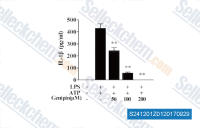
|
|
| S9670 | Pitstop 2 | Pitstop 2 is an inhibitor of the interaction of amphiphysin with the amino terminal domain of clathrin that inhibits both clathrin-dependent endocytosis (CDE) and clathrin independent endocytosis (CIE). | ||
| S4777 | Plumbagin | Plumbagin (Plumbagine, Plumbaein, Plumbagone), a quinoid constituent isolated from the root of the medicinal plant Plumbago zeylanica L, exerts anticancer and antiproliferative activities in animal models and in cell culture. | ||
| S3836 | 6-Gingerol | 6-Gingerol is the active constituent of fresh ginger known to exhibit a variety of biological activities including anticancer, anti-inflammation, and anti-oxidation. | ||
| S4758 | Crocin | Crocin (Alpha-Crocin, Gardenia Yellow) is a water-soluble carotenoid pigment of saffron (Crocus sativus L.). It has been used as a spice for flavoring and coloring food preparations, and in Chinese traditional medicine as an anodyne or tranquilizer. | ||
| E2631 | Colcemid | Colcemid (Demecolcine), a derivative of colchicine, is a potent mitotic inhibitor which can incuces cell apoptosis and can be used for cancer research. | ||
| S9279 | Euphorbia factor L3 | Euphorbia factor L3 (5,15-Diacetyl-3-benzoyllathyrol), belonging to the lathyrane diterpenoids isolated from Caper Euphorbia Seed, shows potent cytotoxicity and induces apoptosis via the mitochondrial pathway in A549 cells. | ||
| S3895 | Sophoridine | Sophoridine (5-Epidihydrosophocarpine, Dihydro-5-episophocarpine), a natural product obtained from medicinal plants, has a variety of pharmacological effects, including anti-cancer and anti-arrhythmia, and affects the immune and central nervous systems. | ||
| S9562 | Pomolic acid | Pomolic acid is a pentacyclic triterpene isolated from Euscaphis japonica, and is highly effective in inhibiting cell growth and induces apoptosis. | ||
| S3967 | Flavone | Flavone (2-Phenylchromone, 2-Phenyl-4-chromone, 2-Phenyl-4-benzopyron), a class of flavonoids, mainly found in spices and red or purple plant foods with antioxidant, anti-proliferative, anti-tumor, anti-microbial, estrogenic, acetyl cholinesterase, anti-inflammatory activities and are also used in cancer, cardiovascular disease, neurodegenerative disorders etc. | ||
| S3975 | Protocatechuic acid | Protocatechuic acid (PCA, 3,4-Dihydroxybenzoic acid, Protocatechuate), a dihydroxybenzoic acid, is a type of widely distributed naturally occurring phenolic acid. | ||
| S3938 | Bisdemethoxycurcumin (BDMC) | Bisdemethoxycurcumin (BDMC), a natural demethoxy derivative of curcumin, possesses several biological activities, such as anti-inflammation and anti-cancer activities. | ||
| E0213 | Bruceine D |
Bruceine D, isolated from Brucea javanica (L.) Merr. (Simaroubaceae), shows antineoplastic properties in various human cancers including pancreas, breast, lung, blood, bone, and liver. This compound induces apoptosis in human chronic myeloid leukemia K562 cells via mitochondrial pathway. |
||
| E3523 | Antrodia cinnamomea Extract | Antrodia Cinnamomea Extract is extracted from Antrodia Cinnamomea, which is a novel anticancer agent in tamoxifen-resistant breast cancer management. | ||
| S0913 | 4',5,7-Trimethoxyflavone | 4',5,7-Trimethoxyflavone (5,7,4'-Trimethoxyflavone, TMF) is a flavonoid isolated from Kaempferia parviflora (KP) that induces apoptosis. This compound increases sub-G1 phase, DNA fragmentation, annexin-V/PI staining and Bax/Bcl-xL ratio, activates caspase-3 and degrades poly (ADP-ribose) polymerase (PARP) protein. | ||
| E1223 | RGX-202 | RGX-202 is an SLC6A8 transporter inhibitor which suppress the colon cancer tumor. In addition to significantly reducing intracellular phosphocreatine and ATP levels and inducing tumour apoptosis, this compound also inhibits creatine import both in vitro and in vivo. | ||
| E4022 | Sodium propionate | Sodium propionate (sodium propanoate), a short chain fatty acid, is a white crystalline salt derived from propionic acid with anti-inflammatory properties. This compound is used as a supplement in transgalactic-oligosaccharides (TOS) medium for the isolation of bifidobacteria and as a supplement in the SCFA (short-chain fatty acid) diet prepared for mice. | ||
| E3535 | Japanese ardisia Extract | Japanese Ardisia Extract is extracted from Ardisia japonica, which induces apoptosis and inhibits proliferation in human pancreatic cancer cells. | ||
| E3536 | Pleurotus ostreatus Extract | Pleurotus ostreatus Extract is extracted from Pleurotus ostreatus, which decreases the proliferation of leukaemia cells through apoptosis. | ||
| E0808 | BI-6C9 | BI-6C9 is a highly specific BH3 interacting domain (Bid) inhibitor, which prevents mitochondrial outer membrane potential (MOMP) and mitochondrial fission, and protects the cells from mitochondrial apoptosis inducing factor (AIF) release and caspase-independent cell death in neurons. | ||
| S3267 | Nicotiflorin (Kaempferol-3-O-rutinoside) | Nicotiflorin (Kaempferol-3-O-rutinoside), a flavonoid extracted from Carthamus tinctorius, alters the shape and structure of injured neurons, decreases the number of apoptotic cells, down-regulates expression of p-JAK2, p-STAT3, caspase-3, and Bax and decreases Bax immunoredactivity, and increases Bcl-2 protein expression and immunoreactivity. | ||
| S3271 | Caudatin | Caudatin (Cauldatin), one species of C‑21 steroidal from Cynanchum auriculatum (C. auriculatum), effectively inhibits human glioma growth in vitro and in vivo through triggering cell cycle arrest and apoptosis. | ||
| S0931 | Jaceosidin | Jaceosidin, a flavonoid isolated from Artemisia vestita, possesses anti-tumor and anti-proliferative activities in many cancer cells. This compound induces apoptosis, activates Bax and down-regulates Mcl-1 and c-FLIP expression. It also inhibits COX-2 expression and NF-κB activation. | ||
| E3844 | Polygonatum Odoratum Extract | Polygonatum Odoratum Extract is extracted from Polygonatum odoratum, which inhibits high glucose-induced tubular epithelial cell apoptosis and reduces oxidative stress. | ||
| E3848 | Hypericum Sampsonii Extract | Hypericum Sampsonii Extract is extracted from Hypericum sampsonii, which induces apoptosis of cancer cells by modulating the subcellular localization of RXRalpha. | ||
| S3814 | Tubeimoside I | Tubeimoside I (Lobatoside H, TBMS1), a triterpenoid saponin, isolated from the tubers of Bolbostemma paniculatum, shows potent antitumor and antitumor-promoting effects. | ||
| E4831 | L-Arginine (L-glutamate) | L-Arginine (L-glutamate), also known as arginine glutamate, is a mixture of amino acids that induces apoptosis via hypertonic stress. It also promotes gastric relaxation by providing L-arginine for nitric oxide production, thereby benefiting gastrointestinal motility and conditions associated with vagus nerve dysfunction. | ||
| E3095 | Pyrethrum Extract | Pyrethrum Extract is extracted from Pyrethrum, which can induce apoptosis in HCT cells, and therefore, it can be used as a novel therapeutic for colorectal cancer treatment. | ||
| S0307 | BTR-1 | BTR-1 induces cytotoxicity in a time- and concentration-dependent manner on leukemia cell line CEM. This compound affects DNA replication by inducing a block at S phase and leads to activation of apoptosis to induce cell death. | ||
| S3829 | Isoalantolactone | Isoalantolactone, one of the major sesquiterpene lactone compounds, is isolated from the roots of Anula helenium and possesses multiple biological activities including antifungal, anthelmintic, antimicrobial, anti-inflammatory, antitrypanosomal activities and antiproliferative effects on several cancer cell lines, such as colon, melanoma, ovary, prostate, lung, and leukemia. This compound is an apoptosis inducer, which also acts as an alkylating agent. | ||
| E3884 | Galium Aparine Extract | Galium Aparine Extract is extracted from Galium aparine, which may have a potential anti-cancer effect against breast cancer cells without impairing normal breast epithelial cells. | ||
| E3685 | Ampelopsis grossedentata Extract | Ampelopsis Grossedentata Extract is extracted from Ampelopsis Grossedentata, which can induce apoptosis in cancer cells. | ||
| E3266 | Black Carrot Extract | Black Carrot Extract is extrcated from Daucus carota ssp. sativus var. atrorubens, which is a neuroprotective agent. | ||
| E7084 | C6 Ceramide | C6 Ceramide (C6-Cer, N-Hexanoylsphingosine) is a short-chain, cell-permeable ceramide with anticancer properties, including cell cycle arrest, apoptosis, and tumor growth inhibition. It enhances chemotherapy efficacy in drug-resistant cancers by promoting miR-29b expression, which suppresses endothelial cell proliferation, migration, and angiogenesis through the Akt signaling pathway. In combination with Trichostatin A, this compound disrupts the HDAC6/PP1/tubulin complex, leading to AKT dephosphorylation. | ||
| E1560 | Raptinal | Raptinal is a pro-apoptotic compound that induces apoptosis by promoting the release of cytochrome c from the mitochondria, thereby activating the intrinsic apoptotic pathway. It also inhibits the activity of caspase-activated Pannexin 1 (PANX1), a ubiquitously expressed transmembrane channel involved in regulating various cell death-associated processes. | ||
| S3336 | Heptadecanoic acid |
Heptadecanoic acid (C17:0), an odd chain saturated fatty acid, significantly inhibits cell proliferation, and migration, while promoting apoptosis in PC‑9 and PC‑9/GR cells. This compound is associated with several diseases, including the incidence of coronary heart disease, prediabetes and type 2 diabetes as well as multiple sclerosis. |
||
| E4789 | Bleomycin hydrochloride | Bleomycin hydrochloride is a natural antibiotic, an inhibitor of DNA synthesis. It binds to nuclear DNA, targeting and killing dividing cells in G2 and M phases. It exhibits anticancer activity, showing efficacy against squamous cell carcinoma (SCC) with an IC50 of 4.0 nM in the UT-SCC-19A cell line. | ||
| S6957 | β-Elemene |
β-Elemene ((-)-β-Elemene, Levo-β-elemene) is a sesquiterpene compound extracted from the herb Curcuma Rhizoma with antitumor activities. β-elemene can inhibit cell proliferation, arrest the cell cycle, and induce cell apoptosis or autophagy. |
||
| E3348 | Capsella bursa-pastoris Extract | Capsella Bursa-Pastoris Extract is extracted from Capsella Bursa-Pastoris, which aids in fever, improving eyesight and calming the liver. | ||
| E3376 | Saw palmetto Extract | Saw Palmetto Extract is extrcated from Serenoa repens, which has anti-androgenic, pro-apoptotic, and anti-inflammatory effects. | ||
| E7116 | Deoxynivalenol | Deoxynivalenol (Vomitoxin) is an orally active trichothecene mycotoxin produced by Fusarium fungi, commonly contaminating cereal grains such as wheat, barley, and corn. It disrupts protein synthesis, impairs gut integrity, and triggers immune dysregulation, leading to vomiting, growth suppression, and inflammation in humans and animals. It also induces p38-mediated gene expression and apoptosis in leukocytes, promoting systemic release of interleukin-6 (IL-6) and other proinflammatory cytokines. | ||
| S3357 | Elaidic acid |
Elaidic acid is a major trans fatty acid that inhibits cell viability, elevates cell apoptosis by enhancing oxidative stress. This compound can be used as a pharmaceutical solvent. |
||
| E7972 | Isosilybin A | Isosilybin A is a flavonolignan isolated from silymarin that exhibits anti-prostate cancer (PCA) efficacy with an IC50 of 32 μM in DU145 cells. It induces growth inhibition, G1 arrest, and apoptosis in PCA cells by targeting the Akt-NF-κB-AR axis, highlighting its potential as a therapeutic agent in clinical prostate cancer (PCA) management. | ||
| S5045 | Nomilin | Nomilin is a triterpenoid present in common edible citrus fruits with putative anticancer properties. | ||
| S9410 | Euphorbia factor L1 | Euphorbia factor L1, a diterpenoid isolated from Euphorbia lathyris, inhibits osteoclastogenesis and induces osteoclast apoptosis. | ||
| E3436 | Liquidambar formosana Extract | Liquidambar Formosana Extract is extracted from the dried and mature fruits of Liquidambar Formosana, which can inhibit sarcoma cancer cells by inducing apoptosis. | ||
| E3148 | Euphorbiae Humifusae Herba Extract | Euphorbiae Humifusae Herba Extract is extracted from Euphorbiae Humifusae, which induces apoptosis in Hep3B hepatocarcinoma cells and can be a treatment for hepatocellular carcinoma. | ||
| E1327 | CWI1-2 hydrochloride | CWI1-2 hydrochloride is an inhibitor of IGF2BP2 that binds IGF2BP2 and inhibits its interaction with m6A-modified target transcripts, induces apoptosis and differentiation, and shows promising anti-leukemic effects. | ||
| E3455 | Puff-ball Extract | Puff-Ball Extract is extracted from Calvatia, which has inhibitory effects on the proliferation of breast cancer cells through apoptosis. | ||
| E7174 | D-α-Tocopherol Succinate | D-α-tocopherol succinate (Vitamin E succinate) is an antioxidant tocopherol and a salt form of vitamin E that significantly reduces the cisplatin-induced increase of ROS and decreases cellular necrosis and late apoptosis, thereby inhibiting cisplatin-induced cytotoxicity in HEIOC1 cells. It also exhibits an anti-apoptotic effect. | ||
| S3857 | 4-Hydroxybenzyl alcohol | 4-hydroxybenzyl alcohol (P-Methylolphenol, 4-Methylolphenol), an important phenolic constituent of Gastrodia elata Blume (GEB), has been shown to have many beneficial effects in different animal models of neurological disorders, such as, headaches, convulsive behavior, dizziness, and vertigo. | ||
| E7531 | Necrostatin 2 | Necrostatin-2 is a potent inhibitor of necroptosis with an EC50 of 50 nM in FADD-deficient Jurkat T cells treated with TNF-α. | ||
| E0222 | Glaucocalyxin A |
Glaucocalyxin A is a biologically active ent-kauranoid diterpenoid isolated from Rabdosia japonica var. glaucocalyx with antitumor and anti-inflammatory activity. This compound induces G2/M cell cycle arrest and apoptosis through the PI3K/Akt pathway in human bladder cancer cells. |
||
| E0225 | Licochalcone B |
Licochalcone B (Lico B), extracted from Glycyrrhiza uralensis Fisch, induces the cell cycle arrest and apoptosis in human hepatoma cell HepG2. This compound specifically inhibits the NLRP3 inflammasome by disrupting NEK7‐NLRP3 interaction. |
||
| E3796 | Flaxseed Extract | Flaxseed Extract is drawed from Linum usitatissimum, which can regulate the growth of MCF-7 cells and induce apoptosis. | ||
| E7199 | Transferrins | Transferrin is a glycoprotein that plays a crucial role in iron transport in the bloodstream. It binds ferric ions (Fe³⁺), forming a stable complex that is transported to cells through transferrin receptors (CD71) on the cell membrane. By maintaining cellular iron balance, transferrin helps protect against apoptosis, especially during iron deficiency. Transferrin levels and receptor expression serves as a key biomarkers for evaluating iron status, diagnosing anemia, and assessing cancer prognosis. | ||
| E1232 | Concanavalin A | Concanavalin A is a potential anti-neoplastic agent targeting apoptosis, autophagy and anti-angiogenesis for cancer therapeutics. | ||
| S9182 | Crebanine | Crebanine, an aporphine alkaloid isolated from the crude hexane extract of the dried tuber of Stephania venosa, exhibits anti-cancer effects. | ||
| S1078 | MK-2206 Dihydrochloride | MK-2206 2HCl is a highly selective inhibitor of Akt1/2/3 with IC50 of 8 nM/12 nM/65 nM in cell-free assays, respectively; no inhibitory activities against 250 other protein kinases observed. This compound induces autophagy and apoptosis in cancer cells. Phase 2. |
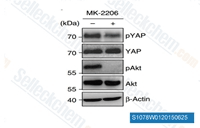
|
|
| S1105 | LY294002 | LY294002 (SF 1101, NSC 697286) is the first synthetic molecule known to inhibit PI3Kα/δ/β with IC50 of 0.5 μM/0.57 μM/0.97 μM, respectively; more stable in solution than Wortmannin, and also blocks autophagosome formation. It not only binds to class I PI3Ks and other PI3K-related kinases, but also to novel targets seemingly unrelated to the PI3K family. This compound also inhibits CK2 with IC50 of 98 nM. It is a non-specific DNA-PKcs inhibitor and activates autophagy and apoptosis. |
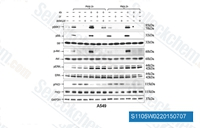
|
|
| S2673 | Trametinib (GSK1120212) | Trametinib (GSK1120212, JTP-74057) is a highly specific and potent MEK1/2 inhibitor with IC50 of 0.92 nM/1.8 nM in cell-free assays, and it does not inhibit the kinase activities of c-Raf, B-Raf, ERK1/2. This compound activates autophagy and induces apoptosis. |
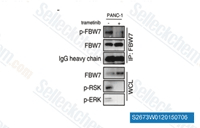
|
|
| S1460 | SP600125 | SP600125 (Nsc75890) is a broad-spectrum JNK inhibitor for JNK1, JNK2 and JNK3 with IC50 of 40 nM, 40 nM and 90 nM in cell-free assays, respectively; 10-fold greater selectivity against MKK4, 25-fold greater selectivity against MKK3, MKK6, PKB, and PKCα, and 100-fold selectivity against ERK2, p38, Chk1, EGFR etc. This compound is also a broad‐spectrum inhibitor of serine/threonine kinases including Aurora kinase A,FLT3 and TRKA with of IC50 of 60 nM, 90 nM and 70 nM. It inhibits autophagy and activates apoptosis. |
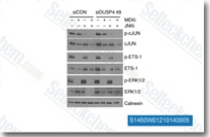
|
|
| S1208 | Doxorubicin (Adriamycin) Hydrochloride | Doxorubicin (DOX) HCl is an antibiotic agent that inhibits human DNA topoisomerase II with IC50 of 2.67 μM. Doxorubicin reduces basal phosphorylation of AMPK. Doxorubicin is used in the concomitant treatment of HIV-infected patients but is found to be at high risk of HBV reactivation.This product may precipitate when dissolved in PBS solution. It is recommended to prepare the stock solution in pure water and dilute with either pure water or saline to obtain the working solution.Doxorubicin (Adriamycin) HCl can be used to induce animal models of kidney disease. |
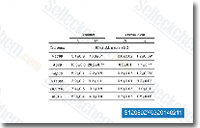
|
|
| S1120 | Everolimus (RAD001) | Everolimus is an mTOR inhibitor of FKBP12 with IC50 of 1.6-2.4 nM in a cell-free assay. Everolimus induces cell apoptosis and autophagy and inhibits tumor cells proliferation. |
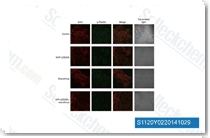
|
|
| S1008 | Selumetinib (AZD6244) | Selumetinib (AZD6244, ARRY-142886) is a potent, highly selective MEK inhibitor with IC50 of 14 nM for MEK1 and Kd value of 530 nM for MEK2. It also inhibits ERK1/2 phosphorylation with IC50 of 10 nM, with no inhibition to p38α, MKK6, EGFR, ErbB2, ERK2, B-Raf, etc. This compound suppresses cell proliferation, migration and trigger apoptosis. Phase 3. |
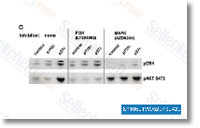
|
|
| S1025 | Gefitinib (ZD1839) | Gefitinib is an EGFR inhibitor for Tyr1173, Tyr992, Tyr1173 and Tyr992 in the NR6wtEGFR and NR6W cells with IC50 of 37 nM, 37nM, 26 nM and 57 nM, respectively. This compound promotes autophagy and apoptosis of lung cancer cells via blockade of the PI3K/AKT/mTOR pathway. |
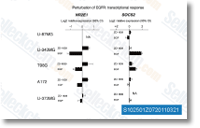
|
|
| S1378 | Ruxolitinib (INCB18424) | Ruxolitinib (INCB18424) is the first potent, selective JAK1/2 inhibitor to enter the clinic with IC50 of 3.3 nM/2.8 nM in cell-free assays, >130-fold selectivity for JAK1/2 versus JAK3. This compound kills tumor cells through toxic mitophagy. It induces autophagy and enhances apoptosis. |
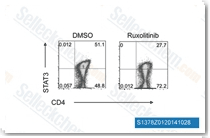
|
|
| S1021 | Dasatinib | Dasatinib is a novel, potent and multi-targeted inhibitor that targets Abl, Src and c-Kit, with IC50 of <1 nM, 0.8 nM and 79 nM in cell-free assays, respectively. Dasatinib induces autophagy and apoptosis with anti-tumor activity. |
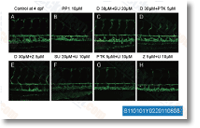
|
|
| S7397 | Sorafenib (BAY 43-9006) | Sorafenib is a multikinase inhibitor of Raf-1 and B-Raf with IC50 of 6 nM and 22 nM in cell-free assays, respectively. Sorafenib inhibits VEGFR-2, VEGFR-3, PDGFR-β, Flt-3 and c-KIT with IC50 of 90 nM, 20 nM, 57 nM, 59 nM and 68 nM, respectively. Sorafenib induces autophagy and apoptosis and activates ferroptosis with anti-tumor activity. |
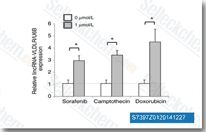
|
|
| S1065 | Pictilisib (GDC-0941) | Pictilisib (GDC-0941, RG7321) is a potent inhibitor of PI3Kα/δ with IC50 of 3 nM in cell-free assays, with modest selectivity against p110β (11-fold) and p110γ (25-fold). Pictilisib (GDC-0941) induces autophagy and apoptosis. Phase 2. |
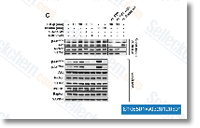
|
|
| S1053 | Entinostat (MS-275) | Entinostat (MS-275, SNDX-275) strongly inhibits HDAC1 and HDAC3 with IC50 of 0.51 μM and 1.7 μM in cell-free assays, compared with HDACs 4, 6, 8, and 10. This compound induces autophagy and apoptosis. Phase 3. |
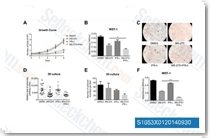
|
|
| S1413 | Bafilomycin A1 (Baf-A1) | Bafilomycin A1 (Baf-A1) is a vacuolar H+-ATPase inhibitor with IC50 of 0.44 nM, and it is found to inhibit autophagy while inducing apoptosis. |
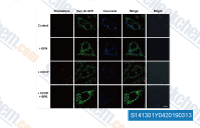
|
|
| S1030 | Panobinostat (LBH589) | Panobinostat (LBH589, NVP-LBH589) is a novel broad-spectrum HDAC inhibitor with IC50 of 5 nM in a cell-free assay. It induces autophagy and apoptosis, and effectively disrupts HIV latency in vivo. Phase 3. |
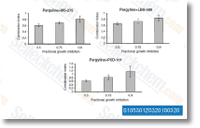
|
|
| S2215 | DAPT | DAPT is a novel γ-secretase inhibitor, which inhibits Aβ production with IC50 of 20 nM in HEK 293 cells. DAPT enhances the apoptosis of human tongue carcinoma cells and regulates autophagy. |
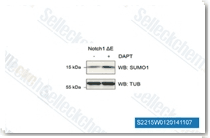
|
|
| S1133 | Alisertib (MLN8237) | Alisertib (MLN8237) is a selective Aurora A inhibitor with IC50 of 1.2 nM in a cell-free assay, and it has >200-fold higher selectivity for Aurora A than Aurora B. This compound induces cell cycle arrest, apoptosis and autophagy. Phase 3. |
-S113303W0120130926.gif)
|
|
| S1002 | ABT-737 | ABT-737 is a BH3 mimetic inhibitor of Bcl-xL, Bcl-2 and Bcl-w with EC50 of 78.7 nM, 30.3 nM and 197.8 nM in cell-free assays, respectively; no inhibition observed against Mcl-1, Bcl-B or Bfl-1. ABT-737 induces mitochondrial pathway apoptosis and mitophagy. Phase 2. |
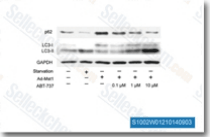
|
|
| S2913 | BAY 11-7082 (BAY 11-7821) | BAY 11-7082 (BAY 11-7821) is a NF-κB inhibitor, inhibits TNFα-induced IκBα phosphorylation with IC50 of 10 μM in tumor cells. BAY 11-7082 inhibits ubiquitin-specific protease USP7 and USP21 with IC50 of 0.19 μM and 0.96 μM, respectively. BAY 11-7082 induces apoptosis and S phase arrest in gastric cancer cells. |
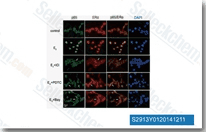
|
|
| S1225 | Etoposide | Etoposide is a semisynthetic derivative of podophyllotoxin, which inhibits DNA synthesis via topoisomerase II inhibition activity which enhances double-strand and single-strand cleavage of DNA and reversibly inhibits repair by topoisomerase II binding. Etoposide induces autophagy, mitophagy and apoptosis. |
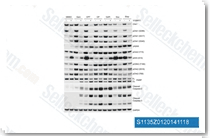
|
|
| S1109 | BI 2536 | BI-2536 is a potent Plk1 inhibitor with IC50 of 0.83 nM in a cell-free assay. BI-2536 inhibits Bromodomain 4 (BRD4) with Kd of 37 nM and potently suppresses c-Myc expression. BI-2536 induces apoptosis and attenuates autophagy. Phase 2. |
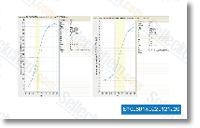
|
|
| S2247 | Buparlisib (BKM120) | Buparlisib (BKM120, NVP-BKM120) is a selective PI3K inhibitor of p110α/β/δ/γ with IC50 of 52 nM/166 nM/116 nM/262 nM in cell-free assays, respectively. Reduced potency against VPS34, mTOR, DNAPK, with little activity to PI4Kβ. Buparlisib induces apoptosis. Phase 2. |
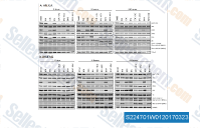
|
|
| S1040 | Sorafenib tosylate | Sorafenib tosylate is a multikinase inhibitor of Raf-1 and B-Raf with IC50 of 6 nM and 22 nM in cell-free assays, respectively. This compound inhibits VEGFR-2, VEGFR-3, PDGFR-β, Flt-3 and c-KIT with IC50 of 90 nM, 20 nM, 57 nM, 59 nM and 68 nM, respectively. It induces autophagy and apoptosis and activates ferroptosis with anti-tumor activity. |
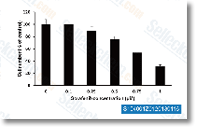
|
|
| S1555 | AZD8055 | AZD8055 is a novel ATP-competitive mTOR inhibitor with IC50 of 0.8 nM in MDA-MB-468 cells with excellent selectivity (∼1,000-fold) against PI3K isoforms and ATM/DNA-PK. This compound induces caspase-dependent apoptosis and also induces autophagy. Phase 1. |
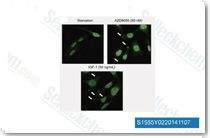
|
|
| S7024 | Stattic | Stattic, the first nonpeptidic small molecule, potently inhibits STAT3 activation and nuclear translocation with IC50 of 5.1 μM in cell-free assays, highly selectivity over STAT1. Stattic induces apoptosis. |
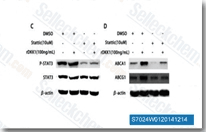
|
|
| S1714 | Gemcitabine | Gemcitabine, a nucleic acid synthesis inhibitor, is a very potent and specific deoxycytidine analogue, used as chemotherapy. Gemcitabine induces a potent p53-dependent apoptosis. |
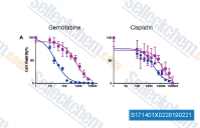
|
|
| S1004 | Veliparib (ABT-888) | Veliparib (ABT-888, NSC 737664) is a potent inhibitor of PARP1 and PARP2 with Ki of 5.2 nM and 2.9 nM in cell-free assays, respectively. This compound is inactive to SIRT2 and increases autophagy and apoptosis. Phase 3. |
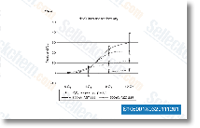
|
|
| S8037 | Necrostatin-1 (Nec-1) | Necrostatin-1 (Nec-1) is a specific RIP1 (RIPK1) inhibitor and inhibits TNF-α-induced necroptosis with EC50 of 490 nM in 293T cells. Necrostatin-1 also blocks IDO and suppresses autophagy and apoptosis. |
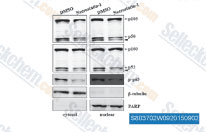
|
|
| S7781 | Sunitinib (SU-11248) | Sunitinib is a multi-targeted RTK inhibitor targeting VEGFR2 (Flk-1) and PDGFRβ with IC50 of 80 nM and 2 nM, and also inhibits c-Kit. Sunitinib is also a dose-dependent inhibitor of the autophosphorylation activity of IRE1α. Sunitinib induces autophagy and apoptosis. |
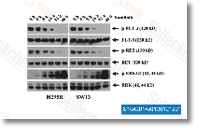
|
|
| S1209 | 5-Fluorouracil (5-FU) | 5-FU (5-Fluorouracil) is a DNA/RNA synthesis inhibitor, which interrupts nucleotide synthetic by inhibiting thymidylate synthase (TS) in tumor cells. Fluorouracil induces apoptosis and can be used in the treatment of HIV. |
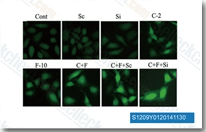
|
|
| S3020 | Romidepsin (FK228) | Romidepsin (FK228, Depsipeptide, FR 901228, NSC 630176) is a potent HDAC1 and HDAC2 inhibitor with IC50 of 36 nM and 47 nM in cell-free assays, respectively. This compound controls growth and induces apoptosis in neuroblastoma tumor cells. |
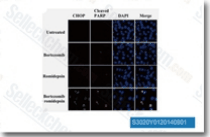
|
|
| S2853 | Carfilzomib (PR-171) | Carfilzomib (PR-171) is an irreversible proteasome inhibitor with IC50 of <5 nM in ANBL-6 cells. It displays preferential in vitro inhibitory potency against the ChT-L activity in the β5 subunit, but has little or no effect on the PGPH and T-L activities. This compound activates prosurvival autophagy and induces cell apoptosis. |
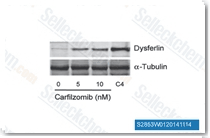
|
|
| S1237 | TMZ(Temozolomide) | Temozolomide (TMZ) is a monofunctional SN-1 alkylating agent that can modify nitrogen atoms in the DNA ring and the extracyclic oxygen group, chemically converted to MTIC and degrades to methyldiazonium cation, which transfers methyl groups to DNA at physiologic pH. It is a DNA damage inducer in L-1210 and L-1210/BCNU cells. This compound induces apoptosis and exhibits antitumor activity. |
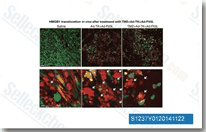
|
|
| S5243 | Ruxolitinib (INCB18424) Phosphate | Ruxolitinib Phosphate (INCB018424, INC424) is the phosphate salt form of Ruxolitinib. Ruxolitinib is the first potent, selective, JAK1/2 inhibitor to enter the clinic with IC50 of 3.3 nM/2.8 nM in cell-free assays, >130-fold selectivity for JAK1/2 versus JAK3. Ruxolitinib kills tumor cells through toxic mitophagy. Ruxolitinib induces autophagy and enhances apoptosis. | ||
| S2662 | ICG-001 | ICG-001 antagonizes Wnt/β-catenin/TCF-mediated transcription and specifically binds to CREB-binding protein (CBP) with IC50 of 3 μM, but is not the related transcriptional coactivator p300. ICG-001 induces apoptosis. |
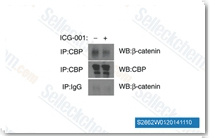
|
|
| S1200 | Decitabine (5-Aza-2'-Deoxycytidine) | Decitabine is a DNA methyltransferase inhibitor, incorporating into DNA and resulting in hypomethylation of DNA and intra-S-phase arrest of DNA replication. It is used to treat myelodysplastic syndrome (MDS). This compound induces cell cycle arrest and apoptosis in various cancer cell lines. |
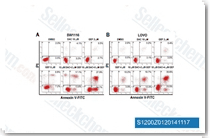
|
|
| S1491 | Fludarabine | Fludarabine is a STAT1 activation inhibitor which causes a specific depletion of STAT1 protein (and mRNA) but not of other STATs. Also a DNA synthesis inhibitor in vascular smooth muscle cells. Fludarabine induces apoptosis. |
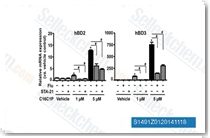
|
|
| S1077 | SB202190 | SB202190 is a potent p38 MAPK inhibitor targeting p38α/β with IC50 of 50 nM/100 nM in cell-free assays, sometimes used instead of SB 203580 to investigate potential roles for SAPK2a/p38 in vivo. This compound inhibits endothelial cell apoptosis via induction of autophagy and heme oxygenase-1. It significantly suppresses Erastin‐dependent ferroptosis. |
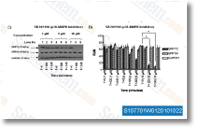
|
|
| S1623 | Acetylcysteine (N-Acetylcysteine, NAC) | Acetylcysteine (N-acetyl-l-cysteine, NAC, N-acetylcysteine) is a ROS(reactive oxygen species) inhibitor that antagonizes the activity of proteasome inhibitors. It is also a tumor necrosis factor production inhibitor, suppresses TNF-induced NF-κB activation through inhibition of IκB kinases, induces apoptosis via the mitochondria-dependent pathway, and inhibits ferroptosis and virus replication.Solutions are unstable and should be fresh-prepared. |
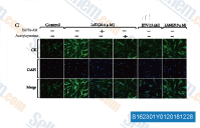
|
|
| S2235 | Volasertib (BI6727) | Volasertib is a highly potent Plk1 inhibitor with IC50 of 0.87 nM in a cell-free assay. It shows 6- and 65-fold greater selectivity against Plk2 and Plk3. Volasertib induces cell cycle arrest and apoptosis in various cancer cells. Phase 3. |
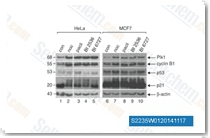
|
|
| S1042 | Sunitinib malate | Sunitinib malate is a multi-targeted RTK inhibitor targeting VEGFR2 (Flk-1) and PDGFRβ with IC50 of 80 nM and 2 nM in cell-free assays, and also inhibits c-Kit. Sunitinib Malate effectively inhibits autophosphorylation of Ire1α. Sunitinib Malate increases both death receptor and mitochondrial-dependent apoptosis. |
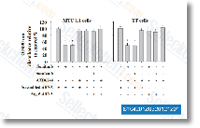
|
|
| S2789 | Tofacitinib (CP-690550) | Tofacitinib is a novel inhibitor of JAK3 with IC50 of 1 nM in cell-free assays, 20- to 100-fold less potent against JAK2 and JAK1. This compound inhibits the expression of antiapoptotic BCL-A1 and BCL-XL in human plasmacytoid dendritic cells (PDC) and induced PDC apoptosis. |
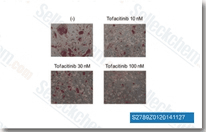
|
|
| S1029 | Lenalidomide (CC-5013) | Lenalidomide is a TNF-α secretion inhibitor with IC50 of 13 nM in PBMCs. Lenalidomide (CC-5013) is a ligand of ubiquitin E3 ligase cereblon (CRBN), and it causes selective ubiquitination and degradation of two lymphoid transcription factors, IKZF1 and IKZF3, by the CRBN-CRL4 ubiquitin ligase. Lenalidomide promotes cleaved caspase-3 expression and inhibit VEGF expression and induces apoptosis. |
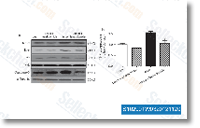
|
|
| S1119 | Cabozantinib (XL184) | A potent VEGFR2 inhibitor with IC50 of 0.035 nM, Cabozantinib (XL184) also inhibits c-Met, Ret, Kit, Flt-1/3/4, Tie2, and AXL with IC50 of 1.3 nM, 4 nM, 4.6 nM, 12 nM/11.3 nM/6 nM, 14.3 nM and 7 nM in cell-free assays, respectively. It induces PUMA-dependent apoptosis in colon cancer cells via AKT/GSK-3β/NF-κB signaling pathway. |
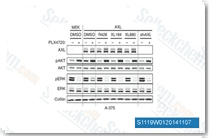
|
|
| S1191 | Fulvestrant (ICI-182780) | Fulvestrant is an estrogen receptor (ER) antagonist with IC50 of 0.94 nM in a cell-free assay. Fulvestrant also induces autophagy and apoptosis and has antitumor activity. |
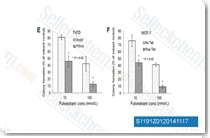
|
|
| S1526 | Quizartinib (AC220) | Quizartinib (AC220) is a second-generation FLT3 inhibitor for Flt3(ITD/WT) with IC50 of 1.1 nM/4.2 nM in MV4-11 and RS4;11 cells, respectively, 10-fold more selective for Flt3 than KIT, PDGFRα, PDGFRβ, RET, and CSF-1R. Quizartinib (AC220) induces apoptosis of tumor cells. Phase 3. |
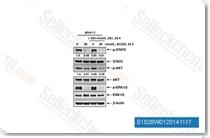
|
|
| S1288 | Camptothecin (CPT) | Camptothecin (CPT) is a specific inhibitor of DNA topoisomerase I (Topo I) with IC50 of 0.68 μM in a cell-free assay. Camptothecin induces apoptosis in cancer cells via microRNA-125b-mediated mitochondrial pathways. Phase 2. |
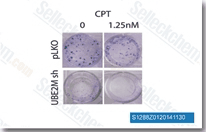
|
|
| S7747 | Ro-3306 | RO-3306 is an ATP-competitive, and selective CDK1 inhibitor with Ki of 20 nM, >15-fold selectivity against a diverse panel of human kinases. RO-3306 enhances p53-mediated Bax activation and mitochondrial apoptosis. |
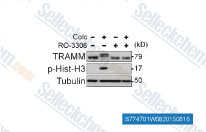
|
|
| S2248 | Silmitasertib (CX-4945) | Silmitasertib (CX-4945) is a potent and selective inhibitor of CK2 (casein kinase 2) with IC50 of 1 nM in a cell-free assay, although it is less potent against Flt3, Pim1 and CDK1 (inactive in cell-based assay). This compound induces autophagy and promotes apoptosis. Phase 1/2. |
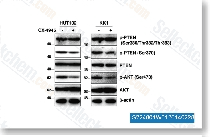
|
|
| S1141 | Tanespimycin (17-AAG) | Tanespimycin (17-AAG, CP127374, NSC-330507, KOS 953) is a potent HSP90 inhibitor with IC50 of 5 nM in a cell-free assay, having a 100-fold higher binding affinity for HSP90 derived from tumour cells than HSP90 from normal cells. Tanespimycin (17-AAG) induces apoptosis, necrosis, autophagy and mitophagy. Phase 3. |
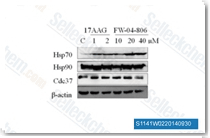
|
|
| S1020 | PD184352 (CI-1040) | PD184352 (CI-1040) is an ATP non-competitive MEK1/2 inhibitor with IC50 of 17 nM in cell-based assays, 100-fold more selective for MEK1/2 than MEK5. This compound selectively induces apoptosis. |
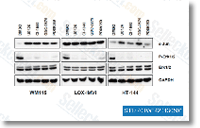
|
|
| S1786 | Verteporfin | Verteporfin is a small molecule that inhibits TEAD–YAP association and YAP-induced liver overgrowth. It is also a potent second-generation photosensitizing agent derived from porphyrin. Verteporfin is an autophagy inhibitor. Verteporfin inhibits cell proliferation and induces apoptosis. |
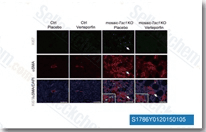
|
|
| S2704 | LY2109761 | LY2109761 is a novel selective TGF-β receptor type I/II (TβRI/II) dual inhibitor with Ki of 38 nM and 300 nM in a cell-free assay, respectively; shown to negatively affect the phosphorylation of Smad2. This compound blocks autophagy and induces apoptosis. |
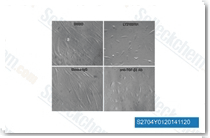
|
|
| S1264 | PD173074 | PD173074 is a potent FGFR1 inhibitor with IC50 of ~25 nM and also inhibits VEGFR2 with IC50 of 100-200 nM in cell-free assays, ~1000-fold selective for FGFR1 than PDGFR and c-Src. PD173074 reduces proliferation and promotes apoptosis in gastric cancer cells. |
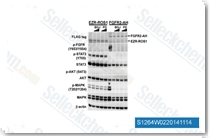
|
|
| S1241 | Vincristine sulfate | Vincristine sulfate is an inhibitor of polymerization of microtubules by binding to tubulin with IC50 of 32 μM in a cell-free assay. Vincristine sulfate induces apoptosis. |
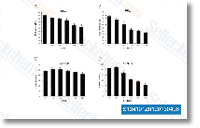
|
|
| S1046 | Vandetanib | Vandetanib is a potent inhibitor of VEGFR2 with IC50 of 40 nM in a cell-free assay. It also inhibits VEGFR3 and EGFR with IC50 of 110 nM and 500 nM, respectively. Not sensitive to PDGFRβ, Flt1, Tie-2 and FGFR1 with IC50 of 1.1-3.6 μM. No activity against MEK, CDK2, c-Kit, erbB2, FAK, PDK1, Akt and IGF-1R with IC50 above 10 μM. This compound increases apoptosis and induces autophagy by increasing the level of reactive oxygen species (ROS). |
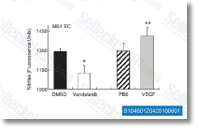
|
|
| S2194 | R406 | R406(R406 besylate) is a potent Syk inhibitor with IC50 of 41 nM in cell-free assays, strongly inhibits Syk but not Lyn, 5-fold less potent to Flt3. R406 induces apoptosis. Phase 1. |
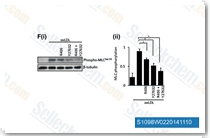
|
|
| S1122 | Mocetinostat (MGCD0103) | Mocetinostat (MGCD0103, MG0103) is a potent HDAC inhibitor with most potency for HDAC1 with IC50 of 0.15 μM in a cell-free assay, 2- to 10- fold selectivity against HDAC2, 3, and 11, and no activity to HDAC4, 5, 6, 7, and 8. It induces apoptosis and autophagy, and is in Phase 2. |
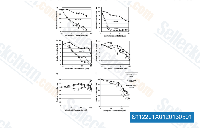
|
|
| S1069 | Luminespib (NVP-AUY922) | Luminespib (AUY-922, NVP-AUY922, VER-52296) is a highly potent HSP90 inhibitor for HSP90α/β with IC50 of 13 nM /21 nM in cell-free assays, exhibits weaker potency against the HSP90 family members GRP94 and TRAP-1, and demonstrates the tightest binding of any small-molecule HSP90 ligand. It effectively downregulates and destabilizes the IGF-1Rβ protein, resulting in growth inhibition, autophagy and apoptosis. Phase 2. |
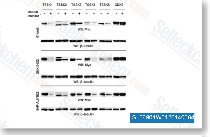
|
|
| S8146 | Mitomycin C | Mitomycin C (Ametycine) is an antineoplastic antibiotic by inhibiting DNA synthesis, used to treat different cancers. Mitomycin C induces apoptosis in a caspases-dependent and Fas/CD95-independent manner.This product is a hazardous chemical (acute toxicity/flammable/skin corrosive). Please use it while wearing a protective face mask, gloves, and clothing. |
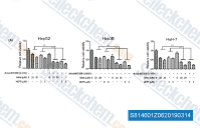
|
|
| S1038 | PI-103 | PI-103 is a multi-targeted PI3K inhibitor for p110α/β/δ/γ with IC50 of 2 nM/3 nM/3 nM/15 nM in cell-free assays, less potent to mTOR/DNA-PK with IC50 of 30 nM/23 nM. This compound induces apoptosis in murine T-cell Lymphoma. |
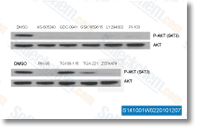
|
|
| S2775 | Nocodazole | Nocodazole is a rapidly-reversible inhibitor of microtubule polymerization, also inhibits Abl, Abl(E255K) and Abl(T315I) with IC50 of 0.21 μM, 0.53 μM and 0.64 μM in cell-free assays, respectively. Nocodazole induces apoptosis. |
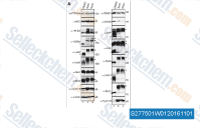
|
|
| S1567 | Pomalidomide (CC-4047) | Pomalidomide inhibits LPS-induced TNF-α release with IC50 of 13 nM in PBMCs. Pomalidomide can be utilized in PROTAC as a ligand for targeting E3 ligase and inhibiting the E3 ligase protein cereblon (CRBN). Pomalidomide promotes apoptosis and cell cycle arrest. |
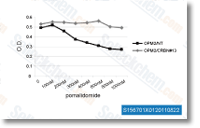
|
|
| S1533 | R406 (free base) | R406 (free base) is a potent Syk inhibitor with IC50 of 41 nM in a cell-free assay, strongly inhibits Syk but not Lyn, 5-fold less potent to Flt3. This compound triggers apoptosis. Phase 1. |
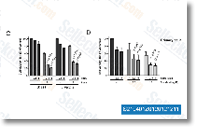
|
|
| S4001 | Cabozantinib malate | Cabozantinib malate (XL184) is the malate of Cabozantinib, a potent VEGFR2 inhibitor with IC50 of 0.035 nM and also inhibits c-Met, Ret (c-Ret), Kit (c-Kit), Flt-1/3/4, Tie2, and AXL with IC50 of 1.3 nM, 4 nM, 4.6 nM, 12 nM/11.3 nM/6 nM, 14.3 nM and 7 nM in cell-free assays, respectively. This compound induces apoptosis. |

|
|
| S1052 | Elesclomol (STA-4783) | Elesclomol (STA-4783) is a novel potent oxidative stress inducer that elicits pro-apoptosis events among tumor cells. Phase 3.Elesclomol specifically binds ferredoxin 1 (FDX1) α2/α3 helices and β5 strand and inhibits FDX1-mediated Fe-S cluster biosynthesis.Elesclomol (STA-4783) is a potent copper ionophore and can be used in the research of copper-dependent cell death (cuproptosis). |
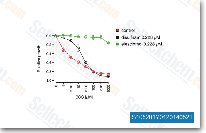
|
|
| S7818 | Pexidartinib (PLX3397) | Pexidartinib (PLX3397) is an oral, potent multi-targeted receptor tyrosine kinase inhibitor of CSF-1R, Kit (c-Kit), and FLT3 with IC50 of 20 nM, 10 nM and 160 nM, respectively. This compound induces apoptosis and necrosis with antitumor activity. Phase 3. |
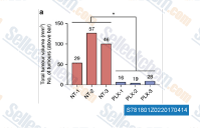
|
|
| S7153 | 10058-F4 | 10058-F4 is a c-Myc inhibitor that specificallly inhibits the c-Myc-Max interaction and prevents transactivation of c-Myc target gene expression. 10058-F4 promotes a caspase-3-dependent apoptosis and modulates autophagy. |
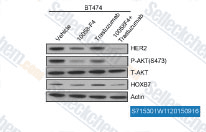
|
|
| S1044 | Temsirolimus | Temsirolimus is a specific mTOR inhibitor with IC50 of 1.76 μM in a cell-free assay. This compound induces autophagy and apoptosis. |

|
|
| S2218 | Torkinib (PP242) | Torkinib (PP242) is a selective mTOR inhibitor with IC50 of 8 nM in cell-free assays; this compound targets both mTOR complexes with >10- and 100-fold selectivity for mTOR than PI3Kδ or PI3Kα/β/γ, respectively. It induces mitophagy and apoptosis. |
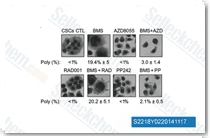
|
|
| S7152 | C646 | C646 is an inhibitor for histone acetyltransferase, and inhibits p300 with a Ki of 400 nM in a cell-free assay. Preferentially selective for p300 versus other acetyltransferases. C646 induces cell cycle arrest, apoptosis and autophagy. |
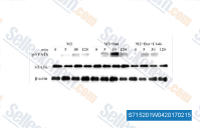
|
|
| S8041 | Cobimetinib (GDC-0973) | Cobimetinib (GDC-0973, RG7420) is a potent and highly selective MEK1 inhibitor with IC50 of 4.2 nM, showing no significant inhibition when tested against a panel of more than 100 serine-threonine and tyrosine kinases. This compound induces apoptosis. Phase 3. |
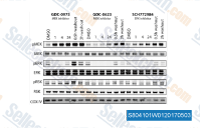
|
|
| S8075 | GANT61 | GANT61 (NSC 136476) is an inhibitor for GLI1 as well as GLI2-induced transcription, inhibits hedgehog with IC50 of 5 μM in GLI1 expressing HEK293T cell, displays selectivity over other pathways, such as TNF and glucocorticoid receptor gene transactivation. This compound induces apoptosis and activates protective autophagy in LX-2 cells. |
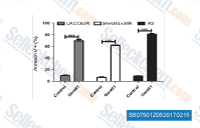
|
|
| S8049 | Tubastatin A | Tububastatin A is a potent and selective HDAC6 inhibitor with IC50 of 15 nM in a cell-free assay. It is selective against all the other isozymes (1000-fold) except HDAC8 (57-fold). This compound promotes autophagy and increases apoptosis. |
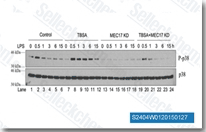
|
|
| S2727 | Dacomitinib | Dacomitinib is a potent, irreversible pan-ErbB inhibitor, mostly to EGFR with IC50 of 6 nM in a cell-free assay. This compound inhibits ERBB2 and ERBB4 with IC50 of 45.7 nM and 73.7 nM, respectively. It is effective against NSCLCs with EGFR or ERBB2 mutations as well as those harboring the EGFR T790M mutation. This chemical inhibits cell growth and induces apoptosis. Phase 2. |
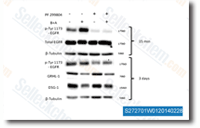
|
|
| S7007 | Binimetinib (MEK162) | Binimetinib (MEK162, ARRY-162, ARRY-438162) is a potent inhibitor of MEK1/2 with IC50 of 12 nM in a cell-free assay. It induces G1 cell cycle arrest and apoptosis in human NSCLC cell lines and also triggers autophagy. Phase 3. |
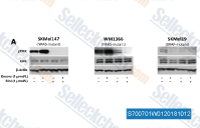
|
|
| S2783 | Vistusertib (AZD2014) | Vistusertib (AZD2014) is a novel mTOR inhibitor with IC50 of 2.8 nM in a cell-free assay, and is highly selective against multiple PI3K isoforms (α/β/γ/δ). It showed no or weak binding to the majority of kinases when tested at 1 μM. This compound induces proliferation suppression, apoptosis, cell cycle arrest, and autophagy in HCC cells with antitumor activity. |
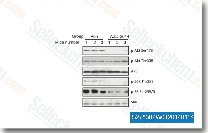
|
|
| S1108 | TAE684 (NVP-TAE684) | TAE684 (NVP-TAE684) is a potent and selective ALK inhibitor which blocked the growth of ALCL-derived and ALK-dependent cell lines with IC50 values between 2 and 10 nM, 100-fold more sensitive for ALK than InsR. This compound induces cell cycle arrest and apoptosis. |
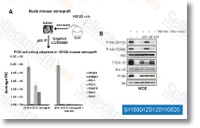
|
|
| S2626 | Rabusertib (LY2603618) | Rabusertib (LY2603618, IC-83) is a highly selective Chk1 inhibitor with potential anti-tumor activity in a cell-free assay. IC50=7 nM, showing approximately 100-fold more potent against Chk1 than against any of the other protein kinases evaluated. Rabusertib (LY2603618) induces cell cycle arrest, DNA damage response and autophagy in cancer cells. Rabusertib (LY2603618) induces bak-dependent apoptosis in AML cell lines. |
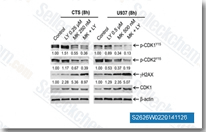
|
|
| S1648 | Cytarabine | Cytarabine is an antimetabolic agent and DNA synthesis inhibitor with IC50 of 16 nM in wild-type CCRF-CEM cells. Cytarabine induces autophagy and apoptosis. |
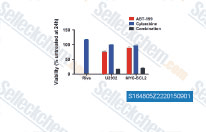
|
|
| S2736 | Fedratinib (TG101348) | Fedratinib (SAR302503, TG101348) is a selective inhibitor of JAK2 with IC50 of 3 nM in cell-free assays, 35- and 334-fold more selective for JAK2 versus JAK1 and JAK3. Fedratinib also inhibits FMS-like tyrosine kinase 3 (FLT3) and RET (c-RET) with IC50 of 15 nM and 48 nM, respectively. Fedratinib has potential antineoplastic activity. Fedratinib inhibits proliferation and induces apoptosis. Phase 2. |

|
|
| S7307 | GSK2606414 | GSK2606414 is an orally available, potent, and selective PERK inhibitor with IC50 of 0.4 nM, displaying at least 100-fold selectivity over the other EIF2AKs assayed. This compound impairs GANT-61 induced autophagy in NB cells with MYCN amplification. It exacerbates ER stress-induced apoptosis in HCT116 cells while reduces the apoptosis in SIL1 KD HeLa cells. |
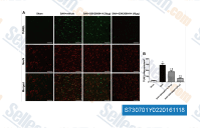
|
|
| S2013 | PF-573228 | PF-573228 is an ATP-competitive inhibitor of FAK with IC50 of 4 nM in a cell-free assay, ~50- to 250-fold selective for FAK than Pyk2, CDK1/7 and GSK-3β. This compound induces apoptosis. |
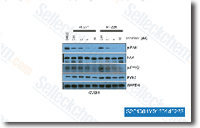
|
|
| S1233 | 2-Methoxyestradiol (2-MeOE2) | 2-Methoxyestradiol (2-MeOE2, NSC 659853, 2-ME2) depolymerizes microtubules and blocks HIF-1α nuclear accumulation and HIF-transcriptional activity. This compound also induces both autophagy and apoptosis in various carcinogenic cell lines. |
-S123306W0220150907.gif)
|
|
| S8059 | Nutlin-3a | Nutlin-3a ((-)-Nutlin-3), the active enantiomer of Nutlin-3, inhibits the p53/MDM2 interaction with IC50 of 90 nM in a cell-free assay. Nutlin-3a induces autophagy and apoptosis in a p53-dependent manner. |

|
|
| S2741 | Niraparib (MK-4827) | Niraparib (MK-4827) is a selective inhibitor of PARP1/2 with IC50 of 3.8 nM/2.1 nM, with great activity in cancer cells with mutant BRCA-1 and BRCA-2. It is >330-fold selective against PARP3, V-PARP and Tank1. This compound can form PARP–DNA complexes resulting in DNA damage, apoptosis, and cell death. Phase 3. |
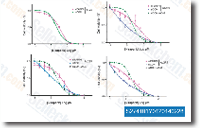
|
|
| S1494 | Ralimetinib (LY2228820) dimesylate | Ralimetinib (LY2228820) dimesylate is a novel and potent inhibitor of p38 MAPK with IC50 of 7 nM in a cell-free assay, does not alter p38 MAPK activation. Phase 1/2. |
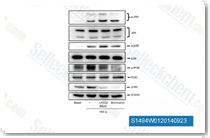
|
|
| S2788 | Capmatinib (INC280) | Capmatinib is a novel, ATP-competitive inhibitor of c-MET with IC50 of 0.13 nM in a cell-free assay, inactive against RONβ, as well as EGFR and HER-3. Capmatinib (INCB28060) inhibits Wnt/β-catenin and EMT signaling pathways and induces apoptosis in diffuse gastric cancer positive for c-MET amplification. Phase 1. |
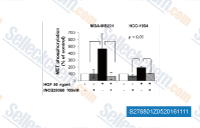
|
|
| S1145 | SNS-032 (BMS-387032) | SNS-032 (BMS-387032) has firstly been described as a selective inhibitor of CDK2 with IC50 of 48 nM in cell-free assays and is 10- and 20-fold selective over CDK1/CDK4. It is also found to be sensitive to CDK7/9 with IC50 of 62 nM/4 nM, with little effect on CDK6. This compound induces apoptosis. |
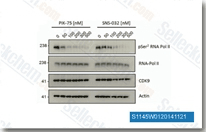
|
|
| S7015 | Birinapant (TL32711) | Birinapant is a SMAC mimetic antagonist, mostly to cIAP1 with Kd of <1 nM in a cell-free assay, less potent to XIAP. This compound helps to induce apoptosis in latent HIV-1-infected cells. Phase 2. |
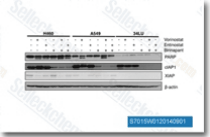
|
|
| S7162 | Mdivi-1 | Mdivi-1 (Mitochondrial division inhibitor 1) is a selective cell-permeable inhibitor of mitochondrial division DRP1 (dynamin-related GTPase) and mitochondrial division Dynamin I (Dnm1) with IC50 of 1-10 μM. Mdivi-1 attenuates mitophagy and enhances apoptosis. |
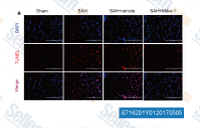
|
|
| S2796 | WP1066 | WP1066 is a novel inhibitor of JAK2 and STAT3 with IC50 of 2.30 μM and 2.43 μM in HEL cells; shows activity to JAK2, STAT3, STAT5, and ERK1/2 not JAK1 and JAK3. WP1066 induces apoptosis. Phase 1. |
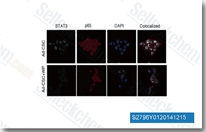
|
|
| S7612 | PX-478 Dihydrochloride | PX-478 2HCl is an orally active, and selective hypoxia-inducible factor-1α (HIF-1α) inhibitor. PX-478 2HCl induces apoptosis and has anti-tumor activity. Phase 1. |
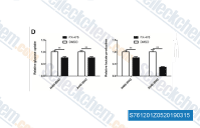
|
|
| S1159 | Ganetespib (STA-9090) | Ganetespib (STA-9090) is an HSP90 inhibitor with IC50 of 4 nM in OSA 8 cells, induces apoptosis of OSA cells while normal osteoblasts are not affected; active metabolite of STA-1474. Phase 3. |
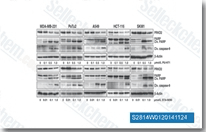
|
|
| S1396 | Resveratrol (trans-Resveratrol) | Resveratrol has a wide spectrum of targets including cyclooxygenases(i.e. COX, IC50=1.1 μM), lipooxygenases(LOX, IC50=2.7 μM), kinases, sirtuins and other proteins. It has anti-cancer, anti-inflammatory, blood-sugar-lowering and other beneficial cardiovascular effects. Resveratrol induces mitophagy/autophagy and autophagy-dependent apoptosis. |
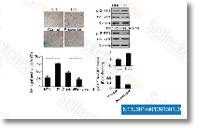
|
|
| S7046 | Brefeldin A (BFA) | Brefeldin A (BFA) is a lactone antibiotic and ATPase inhibitor for protein transport with IC50 of 0.2 μM in HCT 116 cells, induces cancer cell differentiation and apoptosis. It could also improve the HDR(homology-directed repair) efficiency and be an enhancer of CRISPR-mediated HDR. Brefeldin A is also an inhibitor of autophagy and mitophagy. |
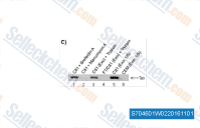
|
|
| S2285 | Cryptotanshinone (Tanshinone C) | Cryptotanshinone (Tanshinone C) is a STAT3 inhibitor with IC50 of 4.6 μM in a cell-free assay, strongly inhibiting phosphorylation of STAT3 Tyr705 with a small effect on STAT3 Ser727, but none against STAT1 nor STAT5. It also induces ROS-dependent autophagy and mitochondria-mediated apoptosis. |
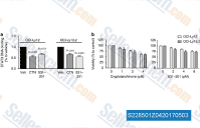
|
|
| S3035 | Daunorubicin HCl | Daunorubicin HCl inhibits both DNA and RNA synthesis and inhibits DNA synthesis with Ki of 0.02 μM in a cell-free assay. Daunorubicin is a topoisomerase II inhibitor that induces apoptosis.Daunorubicin (RP 13057) HCl can be used to induce animal models of Kidney Disease. |
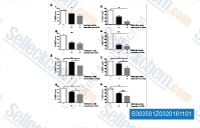
|
|
| S2817 | Torin 2 | Torin 2 is a potent and selective mTOR inhibitor with IC50 of 0.25 nM in p53−/− MEFs cell line; 800-fold greater selectivity for mTOR than PI3K and improved pharmacokinetic properties. This compound inhibits ATM/ATR/DNA-PK with EC50 of 28 nM/35 nM/118 nM,in PC3 cell lines respectively. It decreases cell viability and induces autophagy and apoptosis. |
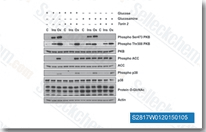
|
|
| S1792 | Simvastatin | Simvastatin is a competitive inhibitor of HMG-CoA reductase with Ki of 0.1-0.2 nM in cell-free assays. Simvastatin induces ferroptosis, mitophagy, autophagy and apoptosis. |
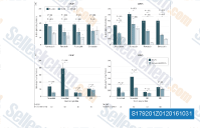
|
|
| S8001 | Ricolinostat (ACY-1215) | Ricolinostat (ACY-1215, Rocilinostat) is a selective HDAC6 inhibitor with IC50 of 5 nM in a cell-free assay. It is >10-fold more selective for HDAC6 than HDAC1/2/3 (class I HDACs) with slight activity against HDAC8, minimal activity against HDAC4/5/7/9/11, Sirtuin1, and Sirtuin2. Ricolinostat (ACY-1215) suppresses cell proliferation and promotes apoptosis. Phase 2. |
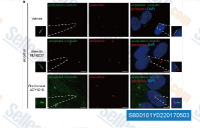
|
|
| S1080 | SU11274 | SU11274 (PKI-SU11274) is a selective Met (c-Met) inhibitor with IC50 of 10 nM in cell-free assays, no effects on PGDFRβ, EGFR or Tie2. This compound induces autophagy, apoptosis and cell cycle arrest. |
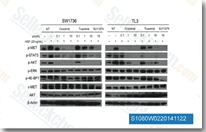
|
|
| S7536 | Lorlatinib (PF-6463922) | Lorlatinib (PF-6463922) is a potent, dual ALK/ROS1 inhibitor with Ki of <0.02 nM, <0.07 nM, and 0.7 nM for ROS1, ALK (WT), and ALK (L1196M), respectively. PF-06463922 induces apoptosis. Phase 1. |
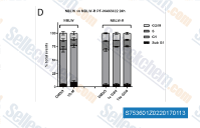
|
|
| S2824 | TPCA-1 | TPCA-1 (GW683965) is an inhibitor of IKK-2 with IC50 of 17.9 nM in a cell-free assay, inhibits NF-κB pathway, exhibits 22-fold selectivity over IKK-1. TPCA-1 is also an inhibitor of STAT3 and enhances apoptosis. |
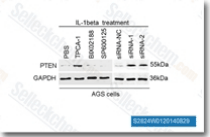
|
|
| S4701 | 2-Deoxy-D-glucose (2-DG) | An analog of glucose, 2-Deoxy-D-glucose (2-DG) is a glycolytic inhibitor with antiviral activity. It induces apoptosis and inhibits Herpes Simplex Virus type-1 (HSV-1) receptor expression. |
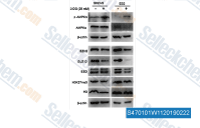
|
|
| S2893 | NU7026 | NU7026 (LY293646) is a potent DNA-PK inhibitor with IC50 of 0.23 μM in cell-free assays, 60-fold selective for DNA-PK than PI3K and inactive against both ATM and ATR. This compound enhances G2/M cell arrest and apoptosis. |
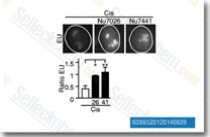
|
|
| S1229 | Fludarabine (NSC 118218) Phosphate | Fludarabine Phosphate is an analogue of adenosine and deoxyadenosine, which is able to compete with dATP for incorporation into DNA and inhibit DNA synthesis. |
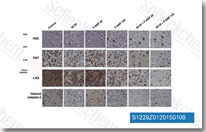
|
|
| S1238 | Tamoxifen | Tamoxifen is an orally active, selective estrogen receptor modulator (SERM) which exhibits both estrogenic agonist and antagonist effects. It blocks estrogen action in breast cells and can activate estrogen activity in other cells, such as bone, liver, and uterine cells. Tamoxifen is a potent Hsp90 activator and enhances the Hsp90 molecular chaperone ATPase activity. |
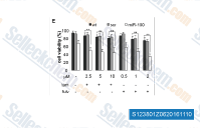
|
|
| S1314 | Zoledronic acid (Zoledronate) | Zoledronic acid (Zoledronate), a potent osteoclast inhibitor, induces apoptosis in osteoclasts by inhibiting enzymes of the mevalonate pathway and preventing the isoprenylation of small GTP-binding proteins such as Ras and Rho. It also induces autophagy. |
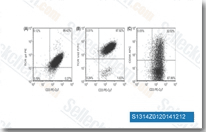
|
|
| S1524 | AT7519 | AT7519 is a multi-CDK inhibitor for CDK1, 2, 4, 6 and 9 with IC50 of 10-210 nM. It is less potent to CDK3 and little active to CDK7. This compound also decrease GSK3β phosphorylation. It induces apoptosis. Phase 2. |
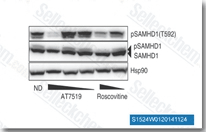
|
|
| S2743 | PF-04691502 | PF-04691502 (PF4691502) is an ATP-competitive PI3K(α/β/δ/γ)/mTOR dual inhibitor with Ki of 1.8 nM/2.1 nM/1.6 nM/1.9 nM and 16 nM in cell-free assays, little activity against either Vps34, AKT, PDK1, p70S6K, MEK, ERK, p38, or JNK. This compound induces apoptosis. Phase 2. |
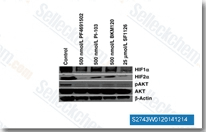
|
|
| S2753 | Tivantinib | Tivantinib is the first non-ATP-competitive c-Met inhibitor with Ki of 0.355 μM in a cell-free assay, little activity to Ron, and no inhibition to EGFR, InsR, PDGFRα or FGFR1/4. This compound induces a G2/M arrest and apoptosis. |
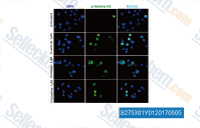
|
|
| S1231 | Topotecan HCl | Topotecan HCl is a topoisomerase I inhibitor for MCF-7 Luc cells and DU-145 Luc cells with IC50 of 13 nM and 2 nM in cell-free assays, respectively. This compound induces autophagy and apoptosis. |
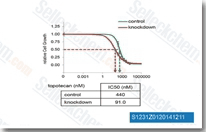
|
|
| S2485 | Mitoxantrone 2HCl | Mitoxantrone 2HCl is a dihydrochloride salt of Mitoxantrone. Mitoxantrone is an inhibitor of type II topoisomerase and protein kinase C (PKC) with IC50 of 8.5 μM for PKC. Mitoxantrone inhibits cell proliferative growth of MCF-7/wt cells with IC50 of 0.42 μM. Mitoxantrone also induces apoptosis. |
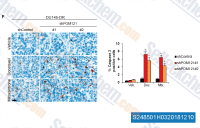
|
|
| S2219 | Momelotinib (CYT387) | Momelotinib (CYT387, LM-1149, CYT11387) is an ATP-competitive inhibitor of JAK1/JAK2 with IC50 of 11 nM/18 nM, ~10-fold selectivity versus JAK3. This compound induces apoptosis and autophagy. Phase 3. |
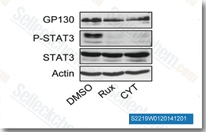
|
|
| S2012 | PCI-34051 | PCI-34051 is a potent and specific HDAC8 inhibitor with IC50 of 10 nM in a cell-free assay. It has greater than 200-fold selectivity over HDAC1 and 6, more than 1000-fold selectivity over HDAC2, 3, and 10. This compound induces caspase-dependent apoptosis. |
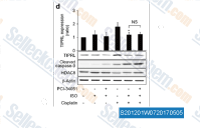
|
|
| S1107 | Danusertib (PHA-739358) | Danusertib (PHA-739358) is an Aurora kinase inhibitor for Aurora A/B/C with IC50 of 13 nM/79 nM/61 nM in cell-free assays, modestly potent to Abl, TrkA, c-RET and FGFR1, and less potent to Lck, VEGFR2/3, c-Kit, CDK2, etc. It induces apoptosis, cell cycle arrest, and autophagy. This compound is in Phase 2. |
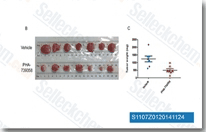
|
|
| S2198 | SGI-1776 free base | SGI-1776 free base is a novel ATP competitive inhibitor of Pim1 with IC50 of 7 nM in a cell-free assay, 50- and 10-fold selective versus Pim2 and Pim3, also potent to Flt3 and haspin. SGI-1776 induces apoptosis and autophagy. |
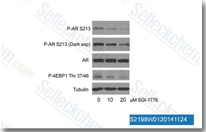
|
|
| S2243 | Degrasyn (WP1130) | Degrasyn (WP1130) is a selective deubiquitinase (DUB: USP5, UCH-L1, USP9x, USP14, and UCH37) inhibitor and also suppresses Bcr/Abl, also a JAK2 transducer (without affecting 20S proteasome) and activator of transcription (STAT). This compound induces apoptosis and blocks autophagy. |
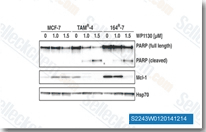
|
|
| S7668 | Picropodophyllin (AXL1717) | Picropodophyllin (PPP, AXL1717) is a IGF-1R inhibitor with IC50 of 1 nM. It displays selectivity for IGF-1R and does not coinhibit tyrosine phosphorylation the IR, or of a selected panel of receptors less related to IGF-IR(FGF-R, PDGF-R, OR EGF-R). Picropodophyllin (PPP) induces apoptosis with antineoplastic activity. |
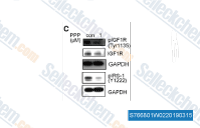
|
|
| S1135 | Pemetrexed disodium | Pemetrexed disodium is a novel antifolate and antimetabolite for TS, DHFR and GARFT with Ki of 1.3 nM, 7.2 nM and 65 nM in cell-free assays, respectively. This compound induces autophagy and apoptosis. |
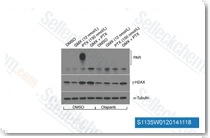
|
|
| S2746 | AZ 628 | AZ628 is a new pan-Raf inhibitor for BRAF, BRAFV600E, and c-Raf-1 with IC50 of 105 nM, 34 nM and 29 nM in cell-free assays, also inhibits VEGFR2, DDR2, Lyn, Flt1, FMS, etc. AZ628 induces apoptosis. |
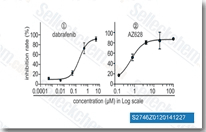
|
|
| S1848 | Curcumin | Curcumin (Diferuloylmethane, Natural Yellow 3, Turmeric yellow) is the principal curcuminoid of the popular Indian spice turmeric, which is a member of the ginger family (Zingiberaceae). It is an inhibitor of p300 histone acetylatransferase(IC50~25 μM)and Histone deacetylase (HDAC); activates Nrf2 pathway and supresses the activation of NF-κB. This compound induces mitophagy, autophagy, apoptosis, and cell cycle arrest with antitumor activity. It reduces renal damage associated with rhabdomyolysis by decreasing ferroptosis-mediated cell death. This chemical exhibits anti-infective properties against various human pathogens like the influenza virus, hepatitis C virus, HIV and so on. |
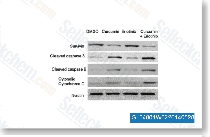
|
|
| S7033 | GSK2656157 | GSK2656157 is an ATP-competitive and highly selective inhibitor of PERK with IC50 of 0.9 nM in a cell-free assay, 500-fold greater against a panel of 300 kinases. This compound decreases apoptosis and inhibits excessive autophagy. |
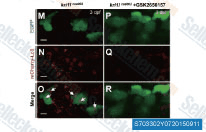
|
|
| S1185 | Ritonavir | Ritonavir is a Cytochrome P450 3A and Protease Inhibitor; Also inhibits Cytochrome P450 2D6, P-Glycoprotein and induces Cytochrome P450 2C19, Cytochrome P450 1A2, Cytochrome P450 2C9, Cytochrome P450 2B6 and UDP Glucuronosyltransferases. This compound induces apoptosis. |
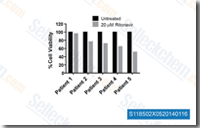
|
|
| S1896 | Hydroxyurea | Hydroxyurea is an antineoplastic agent that inhibits DNA synthesis through the inhibition of ribonucleoside diphosphate reductase. Hydroxyurea activates apoptosis and autophagy. Hydroxyurea is used to treat HIV infection. |
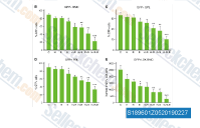
|
|
| S8244 | Etomoxir sodium salt | Etomoxir sodium salt ((R)-(+)-Etomoxir sodium salt) is an irreversible inhibitor of carnitine palmitoyltransferase-1 (CPT-1) on the outer face of the inner mitochondrial membrane. Etomoxir enhances palmitate-induced cell apoptosis. |
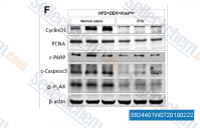
|
|
| S7888 | Spautin-1 | Spautin-1 is a potent and specific autophagy inhibitor, and inhibits the deubiquitinating activity of USP10 and USP13 with IC50 of ∼0.6-0.7 μM. This compound enhances apoptosis. |
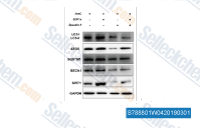
|
|
| S8341 | TAK-243 (MLN7243) | TAK-243 (MLN7243) is a potent, mechanism-based small-molecule inhibitor of the ubiquitin activating enzyme (UAE) with an IC50 of 1 ± 0.2 nM in the UBCH10 E2 thioester assay. It has minimal inhibitory activity in a panel of kinase and receptor assays, as well as on human carbonic anhydrase type I and type II. TAK-243 (MLN7243) induces ER stress, abrogates NFκB pathway activation and promotes apoptosis. | ||
| S4505 | Vinblastine sulfate | Vinblastine sulfate inhibits microtubule formation and suppresses nAChR activity with IC50 of 8.9 μM in a cell-free assay, used to treat certain kinds of cancer. This compound induces autophagy and apoptosis. | ||
| S7653 | VS-4718 (PND-1186) | VS-4718 (PND-1186) is a reversible and selective FAK inhibitor with IC50 of 1.5 nM, which selectively promotes tumor cell apoptosis. Phase 1. |
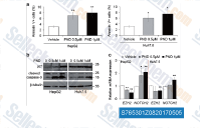
|
|
| S1680 | Disulfiram (Tetraethylthiuram disulfide) | Disulfiram is a specific inhibitor of aldehyde-dehydrogenase (ALDH) with IC50 of 0.15 μM and 1.45 μM for hALDH1 and hALDH2, respectively. Disulfiram is used for the treatment of chronic alcoholism by producing an acute sensitivity to alcohol. Disulfiram induces apoptosis. Disulfiram is also an inhibitor of pore formation by gasdermin D (GSDMD). |
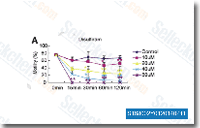
|
|
| S7625 | Niraparib tosylate | Niraparib tosylate is a selective inhibitor of PARP1/PARP2 with IC50 of 3.8 nM/2.1 nM. Niraparib increases formation of PARP-DNA complexes resulting in DNA damage, apoptosis, and cell death. |
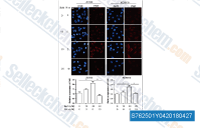
|
|
| S4269 | Vinorelbine ditartrate | Vinorelbine ditartrate is a semi-synthetic vinca alkaloid, and inhibits mitosis through interaction with tubulin. Vinorelbine Tartrate exhibits anti-tumor activities via inducing the mitotic apoptosis, autophagy and inflammation. |
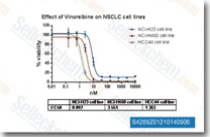
|
|
| S1223 | Epirubicin HCl | Epirubicin HCl, a semisynthetic L-arabino derivative of doxorubicin, is an antineoplastic agent by inhibiting Topoisomerase. Epirubicin induces apoptosis. |
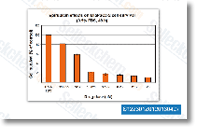
|
|
| S7104 | AZD1208 | AZD1208 is a potent, and orally available Pim kinase inhibitor with IC50 of 0.4 nM, 5 nM, and 1.9 nM for Pim1, Pim2, and Pim3 in cell-free assays, respectively. This compound induces autophagy, cell cycle arrest and apoptosis. Phase 1. |
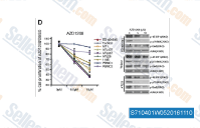
|
|
| S1451 | TCS7010 (Aurora A Inhibitor I) | TCS7010 (Aurora A Inhibitor I) is a novel, potent, and selective inhibitor of Aurora A with IC50 of 3.4 nM in a cell-free assay. It is 1000-fold more selective for Aurora A than Aurora B, and triggers apoptosis through the ROS-mediated UPR signaling pathway. |
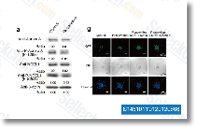
|
|
| S2759 | Fimepinostat (CUDC-907) | Fimepinostat (CUDC-907) is a dual PI3K and HDAC inhibitor targeting PI3Kα and HDAC1/2/3/10 with IC50 values of 19 nM and 1.7 nM/5 nM/1.8 nM/2.8 nM, respectively. This compound induces cell cycle arrest and apoptosis in breast cancer cells. Phase 1. |
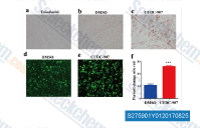
|
|
| S7198 | BIO | BIO (GSK-3 Inhibitor IX, 6-bromoindirubin-3-oxime, 6-Bromoindirubin-3'-oxime, MLS 2052) is a specific inhibitor of GSK-3 with IC50 of 5 nM for GSK-3α/β in a cell-free assay, shows >16-fold selectivity over CDK5, also a pan-JAK inhibitor with IC50 of 30 nM for Tyk2. This compound induces apoptosis in human melanoma cells. |
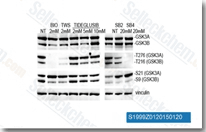
|
|
| S7885 | SBI-0206965 | SBI-0206965 is a highly selective autophagy kinase ULK1 inhibitor with IC50 of 108 nM, about 7-fold selectivity over ULK2. This compound inhibits autophagy and enhances apoptosis in human glioblastoma and lung cancer cells. |
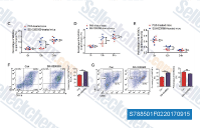
|
|
| S8401 | Erdafitinib (JNJ-42756493) | Erdafitinib is a potent and selective orally bioavailable, pan fibroblast growth factor receptor (FGFR) inhibitor with potential antineoplastic activity. This compound also binds to RET (c-RET), CSF-1R, PDGFR-α/PDGFR-β, FLT4, Kit (c-Kit) and VEGFR-2 and induces cellular apoptosis. |
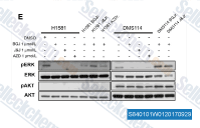
|
|
| S7785 | Pemetrexed Disodium Hydrate | Pemetrexed Disodium Hydrate (LY-231514) is a novel antifolate and antimetabolite for TS, DHFR and GARFT with Ki of 1.3 nM, 7.2 nM and 65 nM, respectively. This compound stimulates autophagy and apoptosis. |

|
|
| S1362 | Rigosertib (ON-01910) | Rigosertib (ON-01910) is a non-ATP-competitive inhibitor of PLK1 with IC50 of 9 nM in a cell-free assay, showing 30-fold greater selectivity against Plk2 and no activity to Plk3. It inhibits the PI3K/Akt pathway, activates oxidative stress signals, and induces apoptosis in various cancer cells. This compound is in Phase 3. |
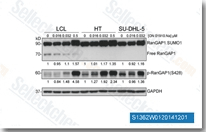
|
|
| S2714 | LY411575 | LY411575 is a potent γ-secretase inhibitor with IC50 of 0.078 nM/0.082 nM (membrane/cell-based), also inhibits Notch cleavage with IC50 of 0.39 nM in APP or NΔE expressing HEK293 cells. LY411575 induces apoptosis. |
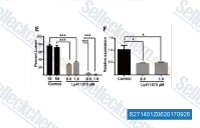
|
|
| S1003 | Linifanib (ABT-869) | Linifanib (ABT-869, AL39324, RG3635) is a novel, potent ATP-competitive VEGFR/PDGFR inhibitor for KDR, CSF-1R, Flt-1/3 and PDGFRβ with IC50 of 4 nM, 3 nM, 3 nM/4 nM and 66 nM respectively, mostly effective in mutant kinase-dependent cancer cells (i.e. FLT3). This compound induces autophagy and apoptosis, and is in Phase 3. |
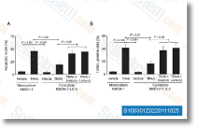
|
|
| S2696 | Apitolisib (GDC-0980) | Apitolisib (GDC-0980, RG7422, GNE 390) is a potent, class I PI3K inhibitor for PI3Kα/β/δ/γ with IC50 of 5 nM/27 nM/7 nM/14 nM in cell-free assays, respectively. It also acts as a mTOR inhibitor with Ki of 17 nM in a cell-free assay, and is highly selective versus other PIKK family kinases. This compound activates autophagy and apoptosis simultaneously in pancreatic cancer cells. Phase 2. |
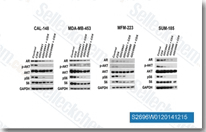
|
|
| S2635 | CCT128930 | CCT128930 is a potent, ATP-competitive and selective inhibitor of Akt2 with IC50 of 6 nM in a cell-free assay, 28-fold greater selectivity for Akt2 than the closely related PKA kinase. This compound induces cell cycle arrest, DNA damage, and autophagy independent of Akt inhibition. High dose of this chemical triggers cell apoptosis in HepG2 cells. |
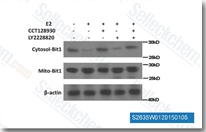
|
|
| S1204 | Melatonin | Melatonin is a MT receptor agonist, used as a dietary supplement. This compound is a selective ATF-6 inhibitor and downregulates COX-2. It enhances mitophagy and regulates the homeostasis of apoptosis and autophagy. |
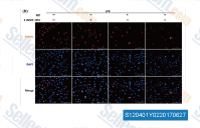
|
|
| S2310 | Honokiol | Honokiol is the active principle of magnolia extract that inhibits Akt-phosphorylation and promotes ERK1/2 phosphorylation. This compound causes G0/G1 phase arrest, induces apoptosis, and autophagy via the ROS/ERK1/2 signaling pathway. It inhibits hepatitis C virus (HCV) infection. Phase 3. |
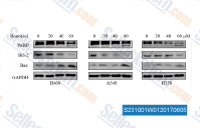
|
|
| S7129 | PYR-41 | PYR-41 is the first cell-permeable inhibitor of ubiquitin-activating enzyme E1, with no activity at E2. This compound induces apoptosis. |

|
|
| S7358 | Poziotinib (HM781-36B) | Poziotinib is an irreversible pan-HER inhibitor with IC50 of 3.2 nM, 5.3 nM and 23.5 nM for HER1, HER2, and HER4, respectively. Poziotinib also induces apoptosis and G1 cell cycle arrest. Phase 2. | ||
| S7353 | EPZ004777 | EPZ004777 is a potent, selective DOT1L inhibitor with IC50 of 0.4 nM in a cell-free assay and demonstrates >1,200-fold selectivity for DOT1L over all other tested PMTs. EPZ004777 induces apoptosis. |
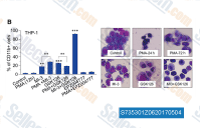
|
|
| S8375 | AZD0156 | AZD0156 is a potent and selective inhibitors of ATM kinase, with potential chemo-/radio-sensitizing and antineoplastic activities. AZD0156 prevents DNA damage checkpoint activation, disrupts DNA damage repair, induces tumor cell apoptosis, and leads to cell death of ATM-overexpressing tumor cells. | ||
| S7090 | GSK923295 | GSK923295 is a first-in-class, specific allosteric inhibitor of CENP-E kinesin motor ATPase with Ki of 3.2 nM, and less potent to mutant I182 and T183. This compound induces post-mitotic apoptosis. Phase 1. |
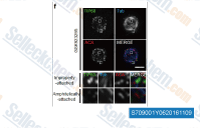
|
|
| S7094 | PF-3758309 | PF-03758309 (PF-03758309) is a potent, ATP-competitive, pyrrolopyrazole inhibitor of PAK4 with Kd of 2.7 nM. This compound is antiproliferative and induces apoptosis in a HCT116 tumor model. |
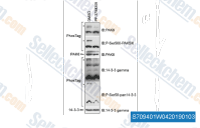
|
|
| S8078 | Bardoxolone Methyl | Bardoxolone Methyl (RTA 402, TP-155, NSC 713200, CDDO Methyl Ester, CDDO-Me) is an IKK inhibitor, showing potent proapoptotic and anti-inflammatory activities; Also a potent Nrf2 activator and nuclear factor-κB (NF-κB) inhibitor. Bardoxolone Methyl abrogates ferroptosis. Bardoxolone methyl induces apoptosis and autophagy in cancer cells. |
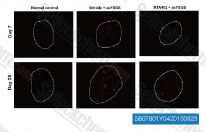
|
|
| S7686 | ML141 | ML141 (CID-2950007) is demonstrated to be a potent, selective and reversible non-competitive inhibitor of Cdc42 GTPase suitable for in vitro assays, with IC50 of 200 nM and selectivity against other members of the Rho family of GTPases (Rac1, Rab2, Rab7). This compound is associated with an increase in p38 activation and may induce p38-dependent apoptosis/senescence. It also protects neuroblastoma cells from metformin-induced apoptosis. |
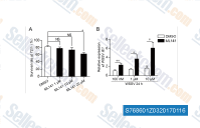
|
|
| S1186 | BIBR 1532 | BIBR 1532 is a potent, selective, non-competitive telomerase inhibitor with IC50 of 100 nM in a cell-free assay. No inhibition of DNA and RNA polymerases, including HIV reverse transcriptase are observed at concentrations vastly exceeding the IC50 for telomerase. This compound induces apoptosis in cancer cells. |
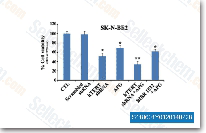
|
|
| S2161 | RAF265 (CHIR-265) | RAF265 (CHIR-265) is a potent selective inhibitor of C-Raf/B-Raf/B-Raf V600E with IC50 of 3-60 nM, and exhibits potent inhibition on VEGFR2 phosphorylation with EC50 of 30 nM in cell-free assays. This compound induces cell cycle arrest and apoptosis. Phase 2. |
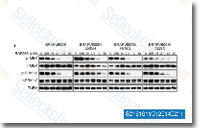
|
|
| S1452 | Ispinesib (SB-715992) | Ispinesib (SB-715992, CK0238273) is a potent, specific and reversible inhibitor of kinesin spindle protein (KSP) with Ki app of 1.7 nM in a cell-free assay, showing no inhibition to CENP-E, RabK6, MCAK, MKLP1, KHC or Kif1A. This compound induces mitotic arrest and apoptotic cell death. |
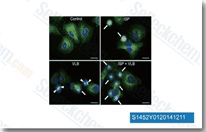
|
|
| S2872 | GW5074 | GW5074 is a potent and selective c-Raf inhibitor with IC50 of 9 nM, no effect on the activities of JNK1/2/3, MEK1, MKK6/7, CDK1/2, c-Src, p38 MAP, VEGFR2 or c-Fms is noted. This compound inhibits LK-induced apoptosis. |
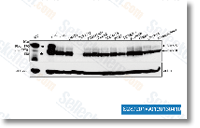
|
|
| S1999 | Sodium butyrate | Sodium butyrate (NaB, Butanoic acid sodium salt), sodium salt of butyric acid, is a histone deacetylase inhibitor and competitively binds to the zinc sites of class I and II histone deacetylases (HDACs). This compound inhibits cell cycle progression, promotes differentiation, and induces apoptosis and autophagy in several types of cancer cells. |
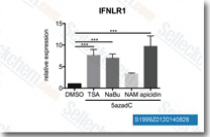
|
|
| S7165 | UNC1999 | UNC1999 is a potent, orally bioavailable and selective inhibitor of EZH2 and EZH1 with IC50 of 2 nM and 45 nM in cell-free assays, respectively, showing >1000-fold selectivity over a broad range of epigenetic and non-epigenetic targets. This compound is a potent autophagy inducer. It specifically suppresses H3K27me3/2 and induces a range of anti-leukemia effects including anti-proliferation, differentiation, and apoptosis. |
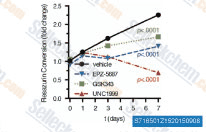
|
|
| S7177 | PF-543 hydrochloride | PF-543 hydrochloride, a novel sphingosine-competitive inhibitor of SphK1, inhibits SphK1 with IC50 and Ki of 2.0 nM and 3.6 nM, exhibits >100-fold selectivity over the SphK2 isoform. This compound induces apoptosis, necrosis, and autophagy. |
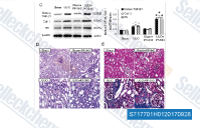
|
|
| S2290 | DHA (Dihydroartemisinin) | Dihydroartemisinin (DHA), a semi-synthetic derivative of artemisinin, is isolated from the traditional Chinese herb Artemisia annua. It induces autophagy and apoptosis by suppressing NF-κB activation. |
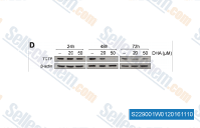
|
|
| S7680 | SP2509 | SP2509 (HCI-2509) is a selective histone demethylase LSD1 inhibitor with IC50 of 13 nM, showing no activity against MAO-A, MAO-B, lactate dehydrogenase and glucose oxidase. This compound induces apoptosis and promotes autophagy. |
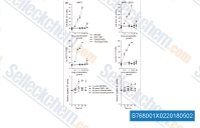
|
|
| S2606 | Mifepristone (RU486) | Mifepristone is a remarkably active antagonist of progesterone receptor and glucocorticoid receptor with IC50 of 0.2 nM and 2.6 nM, respectively. Mifepristone promotes cell autophagy and apoptosis, decreases Bcl-2 level and increases Beclin1 level, accompanied by weakened interaction between Bcl-2 and Beclin1.Mifepristone (RU486) can be used to induce animal models of Spontaneous Abortion. |
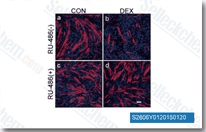
|
|
| S7396 | Calpeptin | Calpeptin is a potent, cell-permeable calpain inhibitor with ID50 of 52 nM, 34 nM, 138 nM, and 40 nM for Calpain I (porcine erythrocytes), Calpain II (porcine kidney), Papainb, and Calpain I (human platelets), respectively. This compound attenuates apoptosis and intracellular inflammatory changes in muscle cells. |
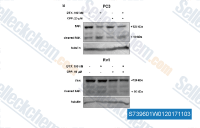
|
|
| S1515 | Pracinostat (SB939) | Pracinostat (SB939) is a potent pan-HDAC inhibitor with IC50 of 40-140 nM with exception for HDAC6. It has no activity against the class III isoenzyme SIRT I. This compound induces apoptosis in tumor cells. Phase 2. |
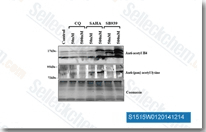
|
|
| S1156 | Capecitabine | Capecitabine is a tumor-selective fluoropyrimidine carbamate, which achieves higher intratumoral 5-FU level with lower toxicity than 5-FU. This compound treatment of HCT-15 cells causes condensation of DNA and induces apoptosis. |
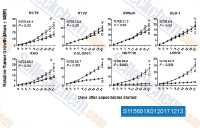
|
|
| S2776 | Devimistat (CPI-613) | Devimistat (CPI-613), a lipoate analog, inhibits mitochondrial enzymes pyruvate dehydrogenase (PDH) and α-ketoglutarate dehydrogenase in NCI-H460 cell line, disrupts tumor cell mitochondrial metabolism. CPI-613 induces apoptosis in pancreatic cancer cells. Phase 2. | ||
| S2820 | TAE226 (NVP-TAE226) | TAE226 (NVP-TAE226) is a potent FAK inhibitor with IC50 of 5.5 nM and modestly potent to Pyk2, ~10- to 100-fold less potent against InsR, IGF-1R, ALK, and c-Met. This compound induces apoptosis. |
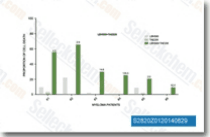
|
|
| S7369 | 4EGI-1 | 4EGI-1 is a competitive eIF4E/eIF4G interaction inhibitor by binding to eIF4E with KD of 25 μM. This compound specifically inhibits the function of mTOR by blocking the activation of 4E-BP1. It induces apoptosis. |
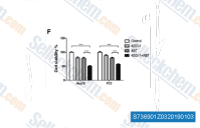
|
|
| S7038 | Epoxomicin (BU-4061T) | Epoxomicin (BU-4061T, Aids010837) is a selective proteasome inhibitor with anti-inflammatory activity, which primarily inhibits the CH-L activity of the 20S proteasome, while T-L and PGPH catalytic activities are also inhibited at 100- and 1000-fold reduced rate. This compound promotes apoptosis and can be used to induce animal models of Parkinson's Disease. |
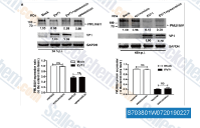
|
|
| S5971 | Pemetrexed | Pemetrexed (LY231514) is a novel antifolate and antimetabolite for thymidylate synthase (TS), dihydrofolate reductase (DHFR) and glycinamide ribonucleotide formyltransferase (GARFT) with Ki of 1.3 nM, 7.2 nM and 65 nM in cell-free assays, respectively. This compound induces autophagy and apoptosis. | ||
| S8141 | Cl-amidine | Cl-amidine is an irreversible pan-peptidylarginine deiminase (PAD) inhibitor with IC50 values of 5.9 ± 0.3 μM, 0.8 ± 0.3 μM, 6.2 ± 1.0 μM for PAD4, PAD1 and PAD3, respectively. Cl-amidine induces apoptosis. | ||
| S7501 | HO-3867 | HO-3867, an analog of curcumin, is a selective STAT3 inhibitor that inhibits its phosphorylation, transcription, and DNA binding without affecting the expression of other active STATs. This compound induces apoptosis. |
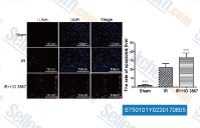
|
|
| S5248 | Apatinib | Apatinib (Rivoceranib, YN968D1) is a potent inhibitor of the VEGF signaling pathway with IC50 values of 1 nM, 13 nM, 429 nM and 530 nM for VEGFR-2, Ret (c-Ret), c-Kit and c-Src, respectively. Apatinib induces both autophagy and apoptosis. | ||
| S7215 | Losmapimod | Losmapimod is a selective, potent, and orally active p38 MAPK inhibitor with pKi of 8.1 and 7.6 for p38α and p38β, respectively. P38 MAPKs are involved in cell differentiation, apoptosis and autophagy. Phase 3. |
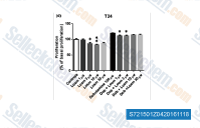
|
|
| S7960 | Larotrectinib sulfate | Larotrectinib sulfate is an oral potent and selective ATP-competitive inhibitor of tropomyosin receptor kinases (TRK). Larotrectinib inhibition of TRKs induces cellular apoptosis and G1 cell-cycle arrest. |
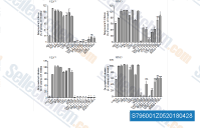
|
|
| S2729 | SB415286 | SB415286 is a potent GSK3α inhibitor with IC50/Ki of 78 nM/31 nM with equally effective inhibition of GSK-3β. This compound causes MM cell growth arrest and apoptosis. |
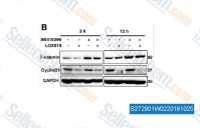
|
|
| S1290 | Celastrol | Celastrol is a potent proteasome inhibitor for the chymotrypsin-like activity of a purified 20S proteasome with IC50 of 2.5 μM. This compound induces apoptosis and autophagy via the ROS/JNK signaling pathway. It inhibits dopaminergic neuronal death of Parkinson's disease through activating mitophagy. |
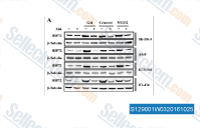
|
|
| S7776 | Akti-1/2 | Akti-1/2 (Akt Inhibitor VIII) is a highly selective Akt1/Akt2 inhibitor with IC50 of 58 nM/210 nM, respectively, about 36-fold selectivity for Akt1 over Akt3. This compound induces apoptosis. |
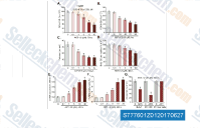
|
|
| S1759 | Pitavastatin calcium | Pitavastatin calcium, a novel member of the medication class of statins, is a calcium salt formulation of pitavastatin which is a highly effective HMG-CoA reductase inhibitor. Pitavastatin Calcium attenuates AGEs-induced mitophagy via inhibition of ROS generation. Pitavastatin Calcium induces autophagy and apoptosis. |
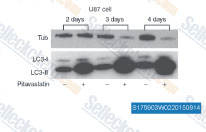
|
|
| S1218 | Clofarabine | Clofarabine (Clolar) inhibits the enzymatic activities of ribonucleotide reductase (RNR) (IC50 = 65 nM) and DNA polymerase. This compound induces autophagy and apoptosis. |
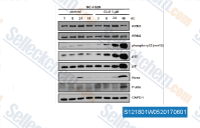
|
|
| S2891 | GW441756 | GW441756 is a potent, selective inhibitor of TrkA with IC50 of 2 nM, with very little activity to c-Raf1 and CDK2. This compound produces a relevant increase of caspase-3 that leads to apoptosis. |
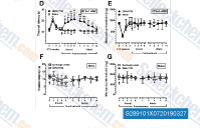
|
|
| S7281 | JIB-04 | JIB-04 (NSC 693627) is a pan-selective Jumonji histone demethylase inhibitor with IC50 of 230, 340, 855, 445, 435, 1100, and 290 nM for JARID1A, JMJD2E, JMJD3, JMJD2A, JMJD2B, JMJD2C, and JMJD2D in cell-free assays, respectively. This compound also induces cell apoptosis. |
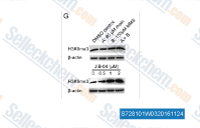
|
|
| S8018 | Nirogacestat (PF-03084014) | Nirogacestat (PF-03084014, PF-3084014) is a selective gamma-secretase inhibitor with IC50 of 6.2 nM in a cell-free assay, and it induces apoptosis. Phase 2. |
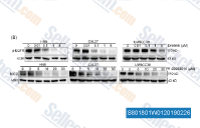
|
|
| S1244 | Amuvatinib (MP-470) | Amuvatinib (MP-470, HPK 56) is a potent and multi-targeted inhibitor of c-Kit, PDGFRα and Flt3 with IC50 of 10 nM, 40 nM and 81 nM, respectively. It suppresses c-MET and c-RET, and is also active as a DNA repair protein Rad51 inhibitor with antineoplastic activity. Phase 2. |
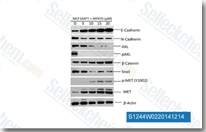
|
|
| S1972 | Tamoxifen Citrate | Tamoxifen Citrate is a selective estrogen receptor modulator (SERM). This compound is also a potent Hsp90 activator and enhances the Hsp90 molecular chaperone ATPase activity. It induces apoptosis and autophagy. |
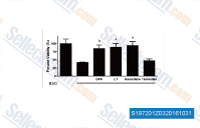
|
|
| S1312 | Streptozotocin (STZ) | Streptozotocin (STZ) is a glucosamine-nitrosourea compound derived from Streptomyces achromogenes, which is a DNA-methylating, carcinogenic, antibiotic and diabetes inducing agent. It induces autophagy and apoptosis. This compound can be used to induce animal models of diabetes. Solutions are unstable and should be fresh-prepared. |
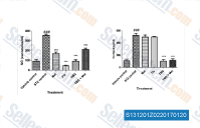
|
|
| S1692 | Busulfan | Busulfan is a cell cycle non-specific alkylating antineoplastic agent. It causes DNA damage by cross-linking DNAs and DNA and proteins. Busulfan inhibits thioredoxin reductase activity. It also induces apoptosis. It is an immunosuppressive and myeloablative chemotherapeutic agent.Busulfan (NSC-750) can be used to induce animal models of Anemia. | ||
| S7076 | T0901317 | T0901317 is a potent and selective agonist for both LXR and FXR, with EC50 of 20nM for LXRα and 5 μM for FXR, respectively. This compound is a dual inverse agonist of RORα and RORγ with Ki of 132 nM and 51 nM, respectively. It significantly suppresses cell proliferation and induces apoptosis. |
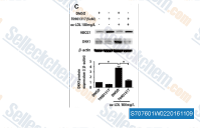
|
|
| S7724 | Eprenetapopt (APR-246) | Eprenetapopt (APR-246, PRIMA-1MET) is a small organic molecule that has been shown to restore tumour-suppressor function primarily to mutant p53 and also to induce cell death in various cancer types. It induces apoptosis and autophagy. | ||
| S8523 | GSK2256098 | GSK2256098 is a potent, selective, reversible, and ATP competitive FAK kinase inhibitor with apparent Ki of 0.4 nM. This compound inhibits cancer cell growth and induces apoptosis. | ||
| S8246 | RK-33 | RK-33 is a first-in-class small molecule inhibitor of DDX3 (a RNA helicase) and causes G1 cell cycle arrest, induces apoptosis, and promotes radiation sensitization in DDX3-overexpressing cells. | ||
| S2812 | (R)-(-)-Gossypol (AT-101) acetic acid | (R)-(-)-Gossypol (AT-101) acetic acid, the R-(-) enantiomer of Gossypol acetic acid, binds with Bcl-2, Bcl-xL and Mcl-1 with Ki of 0.32 μM, 0.48 μM and 0.18 μM in cell-free assays; does not inhibit BIR3 domain and BID. AT-101 simultaneously triggers apoptosis and a cytoprotective type of autophagy. Phase 2. |
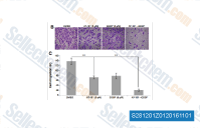
|
|
| S7379 | E-64 | E-64 is an irreversible and selective cysteine protease inhibitor, and also inhibits papain, calpain, and cathepsins B and H, but not serine proteases or aspartic proteases. The IC50 for papain is 9 nM. This compound induces oxidative stress and apoptosis in Filarial Parasite. | ||
| S1576 | Sulfasalazine | Sulfasalazine is a sulfa derivative of mesalazine, used as an anti-inflammatory agent to treat bowel disease and rheumatoid arthritis. This compound is a potent and specific inhibitor of nuclear factor kappa B (NF-κB), TGF-β and COX-2. It induces ferroptosis, apoptosis and autophagy. | ||
| S7846 | Dubermatinib(TP-0903) | Dubermatinib (TP-0903) is a potent and selective AXL Inhibitor with IC50 of 27 nM, and it is highly effective in inducing apoptosis. |

|
|
| S7793 | Purvalanol A | Purvalanol A is a potent, and cell-permeable CDK inhibitor with IC50 of 4 nM, 70 nM, 35 nM, and 850 nM for cdc2-cyclin B, cdk2-cyclin A, cdk2-cyclin E, and cdk4-cyclin D1, respectively. This compound induces endoplasmic reticulum stress-mediated apoptosis and autophagy. |
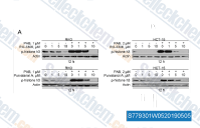
|
|
| S7985 | PIM447 (LGH447) Hydrochloride | PIM447 (LGH447) Hydrochloride is a novel pan-PIM kinase inhibitor with Ki values of 6 pM, 18 pM, 9 pM for PIM1, PIM2, PIM3 respectively. It also inhibits GSK3β, PKN1, and PKCτ, but at a significantly lower potency with IC50 between 1 and 5 μM (>105-fold differential relative to the Ki on PIMs). PIM447 induces apoptosis. |
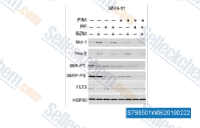
|
|
| S1807 | Acyclovir (Aciclovir) | Acyclovir (Aciclovir) is a synthetic nucleoside analogue active against herpesviruses, and it induces cell cycle perturbation and apoptosis in Jurkat leukemia cells. |
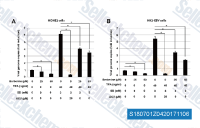
|
|
| S1497 | Pralatrexate | Pralatrexate is an antifolate, and structurally a folate analog. Its IC50 is < 300 nM in some cell lines. This compound induces tumor cell apoptosis. |
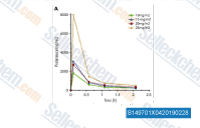
|
|
| S1386 | Nafamostat mesilate (FUT-175) | Nafamostat mesilate (FUT-175) is a synthetic serine protease inhibitor used as an anticoagulant during hemodialysis. It blocks activation of SARS-CoV-2 and is investigated as a new treatment option for COVID-19. This compound also attenuates inflammation and apoptosis. |
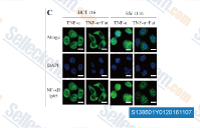
|
|
| S7362 | AZD5582 | AZD5582, a novel small-molecule IAP inhibitor, binds potently to the BIR3 domains of cIAP1, cIAP2, and XIAP with IC50 values of 15, 21, and 15 | ||
| S1629 | Orlistat | Orlistat is a general lipase inhibitor with IC50 of 122 ng/ml for PL from human duodenal juice. This compound treatment reduces proliferation, induces apoptosis and arrests cell cycle. | ||
| S8024 | Tyrphostin AG 1296 | Tyrphostin AG 1296 is an inhibitor of PDGFR with IC50 of 0.3-0.5 μM, no activity to EGFR. Tyrphostin AG1296 inhibits FGFR and c-Kit with IC50 of 12.3 μM and 1.8 μM in Swiss 3T3 cells. Tyrphostin AG1296 induces dramatic apoptosis in A375R cells. |
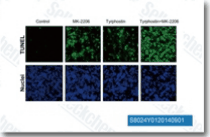
|
|
| S7006 | BAY 61-3606 dihydrochloride | BAY 61-3606 dihydrochloride is a potent and selective inhibitor of Syk kinase (Ki = 7.5 nM). BAY-61-3606 induces cell cycle arrest and apoptosis. | ||
| S1487 | PHA-793887 | PHA-793887 is a novel and potent inhibitor of CDK2, CDK5 and CDK7 with IC50 of 8 nM, 5 nM and 10 nM. It is greater than 6-fold more selective for CDK2, 5, and 7 than CDK1, 4, and 9. This compound induces cell-cycle arrest and apoptosis. Phase 1. |
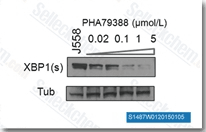
|
|
| S7204 | Fosbretabulin (Combretastatin A4 Phosphate) Disodium | Fosbretabulin (Combretastatin A4 Phosphate) Disodium is the water-soluble prodrug of Combretastatin A4 (CA4), which is a microtubule-targeting agent that binds β-tubulin with Kd of 0.4 μM in a cell-free assay. Fosbretabulin Disodium inhibits the polymerization of tubulin with IC50 of 2.4 μM, and also disrupts tumor vasculature. Fosbretabulin disodium induces mitotic arrest and apoptosis in endothelial cells. Phase 3. |

|
|
| S7276 | SGI-1027 | SGI-1027 (DNA Methyltransferase Inhibitor II) is a DNMT inhibitor with IC50 of 6, 8, 7.5 μM for DNMT1, DNMT3A, and DNMT3B in cell-free assays, respectively. This compound induces apoptosis. |
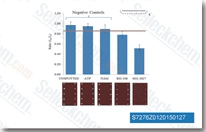
|
|
| S4732 | MPTP Hydrochloride | MPTP hydrochloride is a dopaminergic neurotoxin and cause selective destruction of dopaminergic neurons in animal models of parkinsonism. MPTP hydrochloride induces apoptosis.MPTP hydrochloride can be used to induce animal models of Parkinson’s disease. | ||
| S8402 | KRIBB11 | KRIBB11 abolishes the heat shock-induced luciferase activity with an IC50 of 1.2 μM. It is an inhibitor of the transcription factor Heat Shock Factor 1 (HSF1). This compound induces growth arrest and apoptosis. | ||
| S8632 | BML-277 (Chk2 Inhibitor II) | BML-277 (Chk2 Inhibitor II) is an ATP-competitive inhibitor of Chk2 with IC50 of 15 nM, and it is 1000-fold more selective toward Chk2 serine/threonine kinase than for Chk1 and Cdk1/B kinases. This compound dose dependently protects human CD4(+) and CD8(+) T-cells from apoptosis due to ionizing radiation. | ||
| S1118 | XL147 analogue | XL147 analogue (SAR245408) is a selective and reversible class I PI3K inhibitor for PI3Kα/δ/γ with IC50 of 39 nM/36 nM/23 nM in cell-free assays, less potent to PI3Kβ. This compound induces apoptosis. Phase 1/2. |
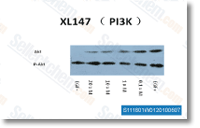
|
|
| S8808 | DC661 | DC661 is capable of deacidifying the lysosome and inhibiting autophagy significantly better than HCQ. This compound induces apoptosis. | ||
| S8615 | Sodium Dichloroacetate (DCA) | DCA (Sodium dichloroacetate), a specific inhibitor of pyruvate dehydrogenase kinase (PDK) with IC50 values of 183 and 80 μM for PDK2 and PDK4 respectively, has been shown to derepress Na+-K+-2Cl- cotransporter and a mitochondrial potassium-ion channel axis. This compound increases reactive oxygen species (ROS) generation, triggers apoptosis in cancer cells, and inhibits tumor growth. | ||
| S1501 | Mycophenolate mofetil | Mycophenolate mofetil is a non-competitive, selective and reversible inhibitor of inosine monophosphate dehydrogenase I/II with IC50 of 39 nM and 27 nM, respectively. This compound induces caspase-dependent apoptosis and cell cycle inhibition in multiple myeloma cells. |
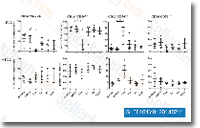
|
|
| S1299 | Floxuridine (FUDR) | Floxuridine (FUDR), a prodrug that is rapidly catabolized to 5-fluorouracil in vivo, is used to treat various cancers, particularly metastases to the liver. It inhibits Poly(ADP-Ribose) polymerase and induces DNA damage and apoptosis. This compound also has antiviral effects against HSV and CMV. | ||
| S7652 | OTS514 hydrochloride | OTS514 is a highly potent TOPK(T-LAK cell-originated protein kinase) inhibitor with an IC50 value of 2.6 nM. OTS514 induces cell cycle arrest and apoptosis. | ||
| S8400 | Mivebresib (ABBV-075) | Mivebresib (ABBV-075) is a novel BET family bromodomain inhibitor. It binds bromodomains of BRD2/4/T with similar affinities (Ki of 1-2.2 nM) and highly selective for 18 bromodomain proteins tested (Kd > 1 μM; more than 600-fold selectivity vs. BRD4), but exhibits roughly 10-fold weaker potency towards BRD3 (Ki of 12.2 nM) and has moderate activity towards CREBBP (Kd = 87 μM; 54-fold selectivity vs. BRD4). Mivebresib(ABBV-075) efficiently triggers apoptosis in various tumor cell. | ||
| S7097 | HSP990 (NVP-HSP990) | HSP990 (NVP-HSP990) is a novel, potent and selective HSP90 inhibitor for HSP90α/β with IC50 of 0.6 nM/0.8 nM, and it induces cell cycle arrest and apoptosis. |
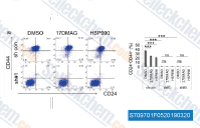
|
|
| S1181 | ENMD-2076 | ENMD-2076 has selective activity against Aurora A and Flt3 with IC50 of 14 nM and 1.86 nM, 25-fold selective for Aurora A than over Aurora B and less potent to RET, SRC, NTRK1/TRKA, CSF1R/FMS, VEGFR2/KDR, FGFR and PDGFRα. This compound inhibits the growth of a wide range of human solid tumor and hematopoietic cancer cell lines with IC50 from 0.025 to 0.7 μM, which induces apoptosis and G2/M phase arrest. Phase 2. |
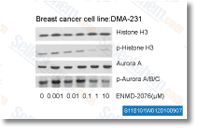
|
|
| S2077 | Atorvastatin Calcium (CI-981) | Atorvastatin Calcium is an inhibitor of HMG-CoA reductase used as a cholesterol-lowering medication that blocks the production of cholesterol. Atorvastatin Calcium induces apoptosis and autophagy. |
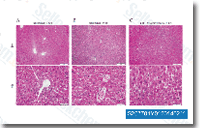
|
|
| S8762 | dBET6 | dBET6 is a highly cell-permeable PROTAC degrader of BET bromodomains with an IC50 of 14 nM for BRD4 binding. dBET6 also induces c-MYC downregulation and apoptosis. | ||
| S7889 | Xanthohumol | Xanthohumol, a prenylated chalcone from hop, inhibits COX-1 and COX-2 activity and shows chemopreventive effects. This compound inhibits diacylglycerol acyltransferase 1 (DGAT1) and DGAT2 with both IC50 of 40 μM. It is also a potent antiviral agent against a series of DNA and RNA viruses. This chemical induces growth inhibition and apoptosis in cancer cells. Phase 1. | ||
| S7465 | FTI 277 HCl | FTI 277 HCl is a potent and selective farnesyltransferase (FTase) inhibitor with IC50 of 500 pM, about 100-fold selectivity over the closely related GGTase I. This compound inhibits cell growth and induces apoptosis. This chemical is effective in clearing HDV viremia. |
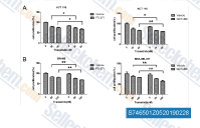
|
|
| S1443 | Zileuton | Zileuton is an orally active inhibitor of 5-lipoxygenase, and thus inhibits leukotrienes (LTB4, LTC4, LTD4, and LTE4) formation, used to decrease the symptoms of asthma. This compound induces apoptosis while inhibits ferroptosis. |
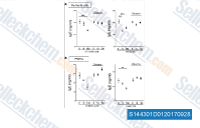
|
|
| S8317 | 3BDO | 3BDO, a butyrolactone derivative, could target FKBP1A and activate the mTOR signaling pathway. It inhibits autophagy in HUVECs. This compound inhibits oxLDL-induced apoptosis. | ||
| S7678 | Sacubitril/valsartan (LCZ696) | Sacubitril/valsartan (LCZ696), consisting of valsartan and sacubitril in a 1:1 molar ratio, is an orally bioavailable, dual-acting angiotensin receptor-neprilysin inhibitor (ARNi) for hypertension and heart failure. Phase 3. |
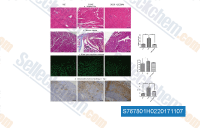
|
|
| S2214 | AZ 960 | AZ 960 is a novel ATP competitive JAK2 inhibitor with IC50 and Ki of <3 nM and 0.45 nM, 3-fold selectivity of this compound for JAK2 over JAK3. This chemical induces apoptosis and growth arrest. |
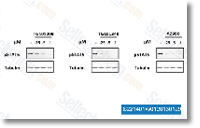
|
|
| S8365 | Apoptozole | Apoptozole (Apoptosis Activator VII) is an inhibitor of heat shock protein 70(HSP70) and Hsc70 with dissociation constants Kd of 0.14 μM and 0.21 μM, respectively. It induces caspase-dependent apoptosis. |
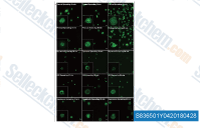
|
|
| S8117 | GMX1778 | GMX1778 is a potent and specific inhibitor of nicotinamide phosphoribosyltransferase (NAMPT) with IC50 and Kd of < 25 nM and 120 nM, respectively. This compound induces programmed cell death with apoptotic features. Phase 1. |
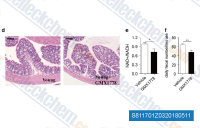
|
|
| S8591 | FX1 | FX1 is a selective BCL6 BTB inhibitor with an IC50 value of 35 μM in reporter assays. This compound shows great selectivity against a panel of 50 different kinases. 10 μM of this chemical fails to significantly inhibit of any of these kinases. It induces apoptosis. | ||
| S7255 | Onvansertib (NMS-1286937, NMS-P937) | Onvansertib (NMS-1286937, NMS-P937) is an orally available, selective Polo-like Kinase 1 (PLK1) inhibitor with IC50 of 2 nM, 5000-fold selectivity over PLK2/PLK3. This compound potently causes a mitotic cell-cycle arrest followed by apoptosis in cancer cell lines and inhibits tumor growth. Phase 1. | ||
| S1132 | 3-Aminobenzamide | 3-Aminobenzamide (3-ABA , 3-Amino Benzamide, 3-AB) is a potent inhibitor of Poly(ADP-ribose)polymerase (PARP) and inhibits cell apoptosis after SCI (Spinal Cord Injury) in caspase-independent way. |
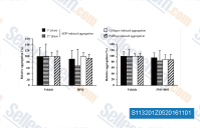
|
|
| S7106 | AZD3463 | AZD3463 is a novel orally bioavailable ALK inhibitor with Ki of 0.75 nM, which also inhibits IGF1R with equivalent potency. This compound suppresses cell viability by inducing both cell apoptosis and autophagy. |
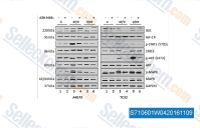
|
|
| S8058 | Riviciclib hydrochloride (P276-00) | Riviciclib hydrochloride (P276-00) is a novel CDK1, CDK4 and CDK9 inhibitor with IC50 of 79 nM, 63 nM and 20 nM, respectively. This compound induces apoptosis. Phase 2/3. |
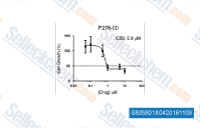
|
|
| S8760 | Iberdomide (CC-220) | Iberdomide (CC-220) is a novel oral immunomodulatory compound that targets cereblon, part of the CRL4CRBN E3 ubiquitin ligase complex, with an IC50 of 60 nM in a competitive TR-FRET assay. Iberdomide (CC-220) induces apoptosis with antitumor and immunostimulatory activities. | ||
| S7421 | CGP 57380 | CGP 57380 is a potent MNK1 inhibitor with IC50 of 2.2 μM, exhibiting no inhibitory activity on p38, JNK1, ERK1 and -2, PKC, or c-Src-like kinases. This compound upregulates β-catenin and potentiates radiation-induced apoptosis. |
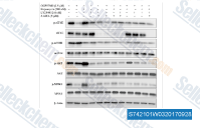
|
|
| S9141 | Berbamine | Berbamine (BA), a traditional Chinese medicine extracted from Berberis amurensis (xiaoboan), is a novel inhibitor of bcr/abl fusion gene with potent anti-leukemia activity and also an inhibitor of NF-κB. This compound induces apoptosis in human myeloma cells and inhibits the growth of cancer cells by targeting Ca²⁺/calmodulin-dependent protein kinase II (CaMKII). | ||
| S4484 | Trametinib DMSO solvate | Trametinib DMSO solvate is a highly specific and potent MEK1/2 inhibitor with IC50 of 0.92 nM/1.8 nM in cell-free assay. Trametinib activates autophagy and induces apoptosis. | ||
| S8663 | Takinib (EDHS-206) | Takinib is a potent and selective TAK1 inhibitor with an IC50 of 9.5 nM, more than 1.5 log more potent than the second and third ranked targets, IRAK4 (120 nM) and IRAK1 (390 nM), respectively. Takinib induces apoptosis. | ||
| S6871 | Sodium oxamate | Sodium oxamate (SO, Aminooxoacetic acid, Oxamic acid) is an inhibitor of lactate dehydrogenase (LDH) that specificly inhibits LDH‑A. This compound induces G2/M cell cycle arrest via downregulation of the CDK1/cyclin B1 pathway and promotes apoptosis through enhancement of mitochondrial ROS generation. | ||
| S8405 | RRx-001 | RRx-001 is a novel epigenetic modulator with potential radiosensitizing activity. It inhibits glucose 6-phosphate dehydrogenase(G6PD) in human tumor cells, binds hemoglobin and drives RBC-mediated redox reactions under hypoxia. This compound triggers apoptosis and exhibits anticancer activity. It is also a downregulator of the CD47- SIRPα checkpoint pathway. | ||
| S7648 | OTS964 | OTS964 is a potent TOPK inhibitor with high affinity and selectivity and IC50 value is 28 nM. This compound is also a potent inhibitor of the cyclin-dependent kinase CDK11 with Kd of 40 nM. This chemical treatment activates autophagy in glioma cells and induces apoptosis of human lung cancer cells in mouse xenografts. | ||
| S8156 | ARS-853 | ARS-853 is a selective, covalent KRAS(G12C) inhibitor that inhibits mutant KRAS-driven signaling by binding to the GDP-bound oncoprotein and preventing activation. This compound also induces apoptosis. | ||
| S5109 | S-Adenosyl-L-methionine (Ademetionine) | Ademetionine (AdoMet, S-Adenosylmethionine, SAMe), also known as SAMe, is a specific form of the amino acid methionine known as S-adenosyl-methionine. It is essential for the formation of glutathione, a water-soluble peptide that helps the body fight free radicals. | ||
| S6894 | BCH | BCH (2-Aminobicyclo-(2,2,1)-heptane-2-carboxylic acid, LAT1-IN-1) is a selective and competitive inhibitor of system L amino acid transporter 1 (LAT1). This compound induces apoptosis in cancer cells. | ||
| S8674 | GO-203 TFA | GO-203 is a D-amino acid cell-penetrating peptide inhibitor of MUC1-C dimerization and thereby its oncogenic function. | ||
| S8820 | Unesbulin (PTC596) | Unesbulin (PTC596) is a second-generation BMI-1 inhibitor that accelerates BMI-1 degradation. This compound downregulates MCL-1 and induces p53-independent mitochondrial apoptosis. IC50 values at 72 hours ranged from 68 to 340 nM in mantle cell lymphoma (MCL) cell lines. | ||
| S5144 | Neferine | Neferine ((R)-1,2-Dimethoxyaporphine), a natural component of Nelumbo nucifera, has antitumor efficiency. It induces apoptosis in renal cancer cells. This compound prevents autophagy through activation of Akt/mTOR pathway and Nrf2 in muscle cells. It strongly inhibits NF-κB activation. It possesses a number of therapeutic effects such as anti-diabetic, anti-aging, anti-microbial, anti-thrombotic, anti-arrhythmic, anti-inflammatory and even anti-HIV. | ||
| S6852 | Gossypol | Gossypol (BL 193) is an orally-active polyphenol isolated from cotton seeds and roots. This compound is a potent inhibitor of 5α-reductase 1 and 3α-hydroxysteroid dehydrogenase with IC50 of 3.33 μM and 0.52 μM in cell-free assay, respectively. It also inhibits the binding of BH3 peptide to Bcl protein with IC50 of 0.4 μM and 10 μM for Bcl-XL and Bcl-2, respectively. This chemical induces apoptosis and cell growth inhibition in various cancer cells. | ||
| S8149 | NSC348884 | NSC348884, as a nucleophosmin inhibitor, inhibit cell proliferation and induce apoptosis in various cancer cell lines with IC50 values ranging from 1.4-4 µM. | ||
| S8974 | GSK2795039 | GSK2795039 is an inhibitor of NADPH oxidase 2 (NOX2) with pIC50 of 6.57 for NOX2-mediated activation of HRP/Amplex Red. This compound inhibits reactive oxygen species (ROS) production, NADPH consumption and reduces apoptosis. | ||
| S8148 | PD0166285 | PD0166285 is a potent Wee1 and Chk1 inhibitor with activity at nanomolar concentrations (IC50=24 nM for Wee1 and 72 nM for Myt1). This compound is also a novel G2 checkpoint abrogator. It induces apoptosis. | ||
| S8495 | WT161 | WT161 is a potent, selective, and bioavailable HDAC6 inhibitor with IC50 values of 0.4 nM, 8.35 nM and 15.4 nM for HDAC6, HDAC1 and HDAC2, respectively; shown to have >100-fold selectivity over other HDACs. This compound induces apoptosis. | ||
| S9721 | Farudodstat |
Farudodstat(LAS 186323,ASLAN003) is a potent and orally active inhibitor of DHODH (Dihydroorotate dehydrogenase) with IC50 of 35 nM for human DHODH enzyme activity. ASLAN003 impairs protein synthesis and induces the differentiation and apoptosis transcriptional program in acute myeloid leukemia (AML) cells via activation of AP-1 transcription factors. |
||
| S1733 | Methylprednisolone | Methylprednisolone is a synthetic glucocorticoid receptor agonist, used to achieve prompt suppression of inflammation. This compound activates ACE2 and reduces IL-6 levels, thus improves severe or critical COVID-19. It markedly reduces autophagy and apoptosis. |
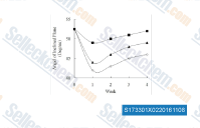
|
|
| S9190 | Oroxin B | Oroxin B (Hypocretin-2), one of flavonoids isolated from traditional Chinese herbal medicine Oroxylum indicum (L.) Vent, selectively induces tumor-suppressive ER stress in malignant lymphoma cells and has antioxidant activity. This compound significantly inhibits proliferation and induce apoptosis, which may be strongly associated with the inhibiting COX-2/VEGF and PTEN/PI3K/AKT signaling pathway in SMMC-7721 cells, it potentially be used as a novel therapeutic agent for liver cancer.COX-2, VEGF, PI3K, and p-AKT expression levels are downregulated, while PTEN is upregulated after this chemical treatment. | ||
| S6877 | EOAI3402143 | EOAI3402143 is a dose-dependent inhibitor of Usp9x, Usp24 and Usp5 that increases tumor cell apoptosis, and fully blocks or regresses myeloma tumors in mice. | ||
| S8432 | Troglitazone (CS-045) | Troglitazone is a potent agonist for the peroxisome proliferator-activated receptor-(PPAR) that is a ligand activated transcription factor regulating cell differentiation and growth. Troglitazone induces autophagy, apoptosis and necroptosis in bladder cancer cells. Troglitazone prevents RSL3-induced ferroptosis and lipid peroxidation in Pfa1 cells. | ||
| S9785 | Fatostatin |
Fatostatin (125B11), a diarylthiazole derivative, is a specific inhibitor of Sterol regulatory element binding proteins (SREBPs) activation. This compound binds to SCAP (SREBP cleavage-activating protein), and inhibits the ER-Golgi translocation of SREBPs. It suppresses growth and enhances apoptosis in cancer cells. |
||
| S0709 | Tubastatin A TFA | Tubastatin A TFA (Tubastatin A trifluoroacetate salt) is a potent and selective HDAC6 inhibitor with IC50 of 15 nM in a cell-free assay. It is selective against all the other isozymes (1000-fold) except HDAC8 (57-fold). Tubastatin A promotes autophagy and increases apoptosis. | ||
| S0278 | SU5614 | SU5614 (Chloro-SU5416, Chloro-Semaxanib) is a small molecule receptor tyrosine kinases (RTK) inhibitor of VEGFR-2, c-kit, and both wild-type and mutant FLT3. This compound reduces cell proliferation and induces apoptosis. | ||
| S3275 | Senkyunolide I | Senkyunolide I (SEI, SENI) is an orally active compound isolated from Ligusticum chuanxiong with analgesic, anti-migraine, neuroprotective, anti-oxidation and anti-apoptosis activities. This compound up-regulates the phosphorylation of Erk1/2 and induces Nrf2 nuclear translocation with enhanced HO-1 and NQO1 expressions. It also promotes the ratio of Bcl-2/Bax and inhibits the expressions of cleaved caspase 3 and caspase 9. | ||
| S9700 | Tapinarof | Tapinarof (GSK2894512, Benvitimod, WBI 1001, DHPS, DMVT 505) is a natural agonist of aryl hydrocarbon receptor (AhR) and induces nuclear translocation of AhR in immortalized keratinocytes (HaCaT) with EC50 of 0.16 nM. This compound induces cellular apoptosis in CD4+ T cells in a dosedependent manner with IC50 of 5.2 μM. | ||
| S8722 | Samuraciclib (ICEC0942) hydrochloride | Samuraciclib (ICEC0942) hydrochloride is a new, orally bioavailable CDK7 inhibitor with an IC50 of 40nM. The IC50 values for CDK1, CDK2, CDK5 and CDK9 were 45-, 15-, 230- and 30-fold higher. ICEC0942 (CT7001) promotes cell cycle arrest and apoptosis. | ||
| S9724 | SZL P1-41 | SZL P1-41 (compound #25) is a specific inhibitor of S-phase kinase-associated protein 2 (Skp2) that indeed binds to Skp2, prevents Skp2-Skp1 interaction and inhibits Skp2 SCF E3 ligase activity, which consequently suppresses survival of cancer cells and cancer stem cells. This compound causes higher apoptosis rates in cancer cells. | ||
| S9668 | PKR-IN-C16 | PKR-IN-C16 (imoxin, C16, Imidazolo-oxindole PKR inhibitor C16) is a specific inhibitor of RNA-dependent protein kinase (PKR, Protein Kinase R, EIF2AK2). This compound prevents apoptosis and IL-1β production in an acute excitotoxic rat model with a neuroinflammatory component. | ||
| S8988 | Rhosin hydrochloride | Rhosin (G04) hydrochloride (HCl) is a potent, specific inhibitor of RhoA subfamily Rho GTPases with Kd of ~ 0.4 uM. Rhosin hydrochloride induces cell apoptosis. | ||
| S6889 | Monomethyl Fumarate | Monomethyl Fumarate (MMF, Monomethylfumarate, Fumaric acid monomethyl ester, Methyl hydrogen fumarate), the active metabolite of the psoriasis drug Fumaderm, is a potent GPR109A agonist. This compound prevents major dysfunctions associated with neurodegenerative diseases: oxidative stress, mitochondrial dysfunction, apoptosis and autophagy. | ||
| S6721 | JG98 | JG-98 is an allosteric inhibitor of Hsp70 that binds tightly to a deep pocket that is conserved in members of the Hsp70 family. JG-98 induces classical apoptosis features, including morphological changes consistent with programmed cell death and positive annexin staining. JG-98 exhibits anticancer activity. | ||
| S6812 | Z-Guggulsterone | Z-Guggulsterone, a constituent of Ayurvedic medicinal plant Commiphora mukul, inhibits angiogenesis in vitro and in vivo. This compound exhibits anti-inflammatory effects in microglia. It induces apoptosis in gastric cancer cells through the intrinsic mitochondria-dependent pathway. | ||
| S3238 | Resibufogenin | Resibufogenin (Bufogenin, Recibufogenin), a component of huachansu with anticancer effect, triggers necroptosis through upregulating receptor-interacting protein kinase 3 (RIP3) and phosphorylating mixed lineage kinase domain-like protein at Ser358. This compound exerts cytotoxic effect by inducing reactive oxygen species (ROS) accumulation. It induces apoptosis and caspase-3 and caspase-8 activity. This chemical increases Bax/Bcl-2 expression, and suppresses cyclin D1, cyclin E, PI3K, p-AKT, p-GSK3β and β-catenin protein expression. | ||
| S3296 | Hispidulin | Hispidulin (Dinatin), an active natrual ingredient in a number of traditional Chinese medicinal herbs, exhibits inhibitory activity against the oncogenic protein kinase Pim-1 with IC50 of 2.71 μM. This compound induces apoptosis through mitochondrial dysfunction and inhibition of P13k/Akt signalling pathway in HepG2 cancer cells. It exerts anti-osteoporotic and bone resorption attenuating effects via activating the AMPK signaling pathway. | ||
| S3300 | Desoxyrhaponticin | Desoxyrhaponticin (DC, DES), a stilbene glycoside from Rheum tanguticum Maxim. ex Balf. (rhubarb) which is a traditional Chinese nutritional food, is a fatty acid synthase (FAS/FASN) inhibitor. This compound is also a competitive inhibitor of glucose uptake with IC50 of 148.3 μM and 30.9 μM in rabbit intestinal membrane vesicles and in rat everted gut sleeves, respectively. It has apoptotic effect on human cancer cells. | ||
| S0817 | SKI-V | SKI V is a noncompetitive and potent inhibitor of non-lipid sphingosine kinase with IC50 of 2 μM for GST-hSK. This compound also inhibits PI3K with IC50 of 6 μM for hPI3k. It decreases formation of the mitogenic second messenger sphingosine-1-phosphate (S1P) and induces apoptosis with antitumor activity. | ||
| S3168 | cis-Resveratrol | cis-Resveratrol (cis-RESV, cRes, (Z)-Resveratrol) is the Cis isomer of Resveratrol. Resveratrol is a natural phenolic compound with anti-oxidant, anti-inflammatory, cardioprotective, and anti-cancer properties. Resveratrol is an inhibitor of pregnane X receptor (PXR) and an activator of Nrf2 and SIRT1 and may induce apoptosis. Resveratrol also inhibits a wide spectrum of targets including 5-lipoxygenase (LOX), cyclooxygenase (COX), IKKβ, DNA polymerases α and δ with IC50 of 2.7 μM, <1 μM, 1 μM, 3.3 μM and 5 μM, respectively. | ||
| E0518 | Polyinosinic acid-polycytidylic acid (Poly(I:C)) | Polyinosinic acid-polycytidylic acid (Polyinosinic-polycytidylic acid; Poly(I:C)), a double-stranded RNA that induces innate immunity in mammals, is a candidate immunopotentiator for pharmaceuticals. Polyinosinic acid-polycytidylic acid is dsRNA formed by the long chain decomposition of muscle poly (I) homopolymer into poly (C) homopolymer. | ||
| S6962 | TPEN |
TPEN (TPEDA) is a specific cell-permeable heavy metal chelator that induces apoptosis in NB4 cells via negatively regulating intracellular NO and Zn2+ signaling. This compound may be a potential therapeutic strategy for APL (acute promyelocytic leukemia). It induces DNA damage and increases intracellular ROS production and also inhibits cell proliferation. |
||
| S8543 | ARN-3236 | ARN-3236 is a potent, orally available and selective inhibitor of salt-inducible kinase 2 (SIK2) with IC50 of <1 nM, 21.63 nM and 6.63 nM for SIK2, SIK1 and SIK3, respectively. This compound induces apoptosis in cancer cells. | ||
| S6963 | APTO-253 |
APTO-253 (LOR-253, LT-253) inhibits c-Myc expression and selectively induces CDKN1A (p21), promotes G0-G1 cell-cycle arrest, and triggers apoptosis in acute myeloid leukemia (AML) cells. This compound is also an inducer of KLF4 (Krüppel-like factor 4). |
||
| S6919 | Brevilin A | Brevilin A (6-O-Angeloylplenolina), a sesquiterpene lactone isolated from Centipeda minima, is a selective inhibitor of STAT3 and attenuates the JAKs activity by blocking the JAKs tyrosine kinase domain JH1. This compound induces apoptosis and autophagy of colon adenocarcinoma cell CT26 via mitochondrial pathway and PI3K/AKT/mTOR inactivation. | ||
| S0149 | C-DIM5 | C-DIM5 (DIM-C-pPhOCH3) is an agonist of Nur77 (Nerve growth factor-induced Bα (NGFI-Bα)/nuclear receptor 4A1 (NR4A1)) which is an orphan nuclear receptor. This compound decreases survival and induces apoptosis in RKO colon cancer cells. | ||
| S0411 | BAM 15 | BAM 15 is a novel mitochondrial protonophore uncoupler capable of protecting mammals from acute renal ischemic-reperfusion injury and cold-induced microtubule damage. This compound is also a potent AMPK activator. It attenuates transportation-induced apoptosis in iPS-differentiated retinal tissue. | ||
| S9634 | Phenoxodiol (Haginin E) | Phenoxodiol (Haginin E, Idronoxil, Dehydroequol, NV 06, PXD) is an isoflavone analog with antineoplastic activity. It activates the caspase system, inhibits XIAP (X-linked inhibitor of apoptosis), and disrupts FLICE inhibitory protein (FLIP) expression, resulting in tumor cell apoptosis. This compound also inhibits DNA topoisomerase II. | ||
| S0444 | Indibulin | Indibulin (ZIO 301, D 24851, Zybulin) is an orally applied inhibitor of tubulin assembly with potent anticancer activity. This compound induces mitotic arrest and apoptosis. | ||
| S1242 | CPTH2 | CPTH2 is a potent histone acetyltransferase (HAT) inhibitor modulating Gcn5p network. This compound induces apoptosis and decreases the invasiveness of a ccRCC cell line through the inhibition of KAT3B. | ||
| S7867 | Oleuropein | Oleuropein is an antioxidant polyphenol isolated from olive leaf. It exerts antioxidant, anti-inflammatory and anti-atherogenic effects and suppresses the adipocyte differentiation in vitro. This compound inhibits PPARγ activity. It exerts anti-adipogenic effect through direct inhibition of PPARγ transcriptional activity. This chemical also inhibits aromatase. It induces apoptosis. Phase 2. | ||
| S3294 | Demethyl-Coclaurine | Demethyl-Coclaurine (Higenamine, Norcoclaurine), the key component of the Chinese herb aconite root, is a beta-2 adrenergic receptor (β2-AR) agonist. This compound stimulates AKT phosphorylation and requires PI3K activation for the anti-apoptotic effect in cardiomyocytes. | ||
| E0212 | Cornuside |
Cornuside is a bisiridoid glucoside compound isolated from the fruit of Cornus officinalis SIEB. et ZUCC. This compound suppresses lipopolysaccharide-induced inflammatory mediators by inhibiting NF-κB activation in RAW 264.7 macrophages. It attenuates apoptosis in rat cortical neurons. |
||
| S3287 | Rosamultin | Rosamultin is a 19 α-hydroxyursane-type triterpenoid isolated from Potentilla anserina L. that inhibits HIV-1 protease. This compound has protective effects on H2O2-induced oxidative damage and apoptosis. | ||
| S6899 | Licochalcone D | Licochalcone D (Lico D, LCD, LD), a flavonoid isolated from a Chinese medicinal plant Glycyrrhiza inflata, has antioxidant, anti-inflammatory and anti-cancer properties. This compound inhibits phosphorylation of NF-κB p65 in LPS signaling pathway. It inhibits JAK2, EGFR and Met (c-Met) activities and induces ROS-dependent apoptosis. This chemical also induces caspases activation and poly (ADP-ribose) polymerase (PARP) cleavage. | ||
| E0216 | Hinokiflavone |
Hinokiflavone, isolated from Selaginella P. Beauv, Juniperus phoenicea and Rhus succedanea, possesses excellent pharmacological activities, including anti-inflammatory, antioxidant and antitumor activity. This compound induces apoptosis and inhibits migration of breast cancer cells via EMT signalling pathway. |
||
| S3984 | Nordihydroguaiaretic acid (NDGA) | Nordihydroguaiaretic acid (NDGA) is a phenolic antioxidant found in the leaves and twigs of the evergreen desert shrub, Larrea tridentata (Sesse and Moc. ex DC) Coville (creosote bush). It is a recognized inhibitor of lipoxygenase (LOX) and has antioxidant and free radical scavenging properties. This compound is a cytotoxic insulin-like growth factor-I receptor (IGF-1R)/HER2 inhibitor and induces apoptosis. | ||
| S0918 | Ginkgolic acid C17:1 | Ginkgolic acid C17:1 (GAC 17:1) inhibits constitutive activation of STAT3 through the abrogation of upstream JAK2 and Src. This compound can induce the substantial expression of PTEN and SHP-1. It induces apoptosis of tumor cells. | ||
| S3289 | Daphnoretin | Daphnoretin (Dephnoretin, Thymelol), a biologically active compound isolated from Wikstroemia indica C.A. Mey., is a protein kinase C (PKC) activator. This compound inhibits the proliferation, invasion, and migration of tumor cells and promote its apoptosis by regulating the activity of Akt signal pathway. | ||
| S3224 | Cinobufagin | Cinobufagin (Cinobufagine), an active ingredient of Venenum Bufonis, inhibits tumor development. This compound increases ATM and Chk2 and decreases CDC25C, CDK1, and cyclin B. It inhibits PI3K, AKT and Bcl-2 while increases levels of cleaved caspase-9 and caspase-3. Thus, this chemical induces cell cycle arrest at the G2/M phase and apoptosis. | ||
| S8961 | Alobresib (GS-5829) | Alobresib (GS-5829) is a novel BET inhibitor that represents a highly effective therapeutics agent against recurrent/chemotherapy-resistant USC-overexpressing c-Myc. This compound inhibits CLL cell proliferation and induces leukemia cell apoptosis through deregulation of key signaling pathways, such as BLK, AKT, ERK1/2, and MYC. It also inhibits NF-κB signaling. | ||
| S3236 | Mesaconitine | Mesaconitine, one of the aconite alkaloids in Aconiti tuber, increases the [Ca2+]i level in endothelial cells by influx of Ca2+ from extracellular spaces. | ||
| E7840 | EF24 | EF24, a synthetic analog of curcumin, is a potent antitumor agent that inhibits tumor growth and metastasis by blocking NF-κB-dependent signaling pathways. It also induces cell cycle arrest and apoptosis through a redox-dependent mechanism in MDA-MB-231 human breast cancer cells and DU-145 human prostate cancer cells. | ||
| S3245 | Nodakenetin | Nodakenetin (NANI), a plant-derived coumarin isolated from Angelica decursiva, inhibits α-glucosidase, PTP1B, rat lens aldose reductase (RLAR), AChE, BChE, and β-site amyloid precursor protein cleaving enzyme 1 (BACE1). This compound alters the protein expression of Bax and Bcl-2, and prompts mitochondrial apoptosis. It exhibits anti-tumor activity. | ||
| S5554 | Lanatoside C | Lanatoside C is a cardiac glycoside with antiviral and anti-tumor activity. This compound induces G2/M cell cycle arrest and induces autophagy and apoptosis via attenuating MAPK, Wnt, JAK-STAT, and PI3K/AKT/mTOR signaling pathways. | ||
| S3269 | Acetylcorynoline | Acetylcorynoline, a major alkaloid component derived from Corydalis bungeana which is a traditional Chinese medical herb, shows anti-inflammatory properties. This compound may decrease egl-1 expression to suppress apoptosis pathways and increase rpn5 expression to enhance the activity of proteasomes. | ||
| S0947 | Cafestol | Cafestol is a natural diterpenes extracted from coffee beans. It induces apoptosis and regulates a variety of inflammatory mediators to reduce inflammation. This compound inhibits the PI3K/Akt pathway and can also reduce the production of ROS in the leukemia cell line HL60. | ||
| S0949 | Cucurbitacin IIb | Cucurbitacin IIb (CuIIb, Dihydrocucurbitacin F, 25-deacetyl hemslecin A) inhibits phosphorylation of STAT3, JNK and Erk1/2, enhances the phosphorylation of IκB and NF-κB, blocks nuclear translocation of NF-κB and decreases mRNA levels of IκBα and TNF-α. This compound exhibits anti-inflammatory activity and induces apoptosis. It is isolated from Hemsleya amabilis. | ||
| S0539 | BTZO-1 | BTZO-1 binds to macrophage migration inhibitory factor (MIF) with Kd of 68.6 nM. This compound activats antioxidant response element (ARE)-mediated gene expression and suppresses oxidative stress-induced cardiomyocyte apoptosis in vitro. | ||
| E3091 | Citri Reticulatae Pericarpium Extract | Citri Reticulatae Pericarpium Extract is obtained from Citri Reticulatae Pericarpium, which enriches with polymethoxy flavonoids, has been identified as a prospective therapeutic treatment for metabolic disorders and circulatory system diseases due to the remarkable anti-inflammatory, antioxidant, and anti-apoptotic activity. | ||
| S0056 | (E/Z)-BCI | (E/Z)-BCI (BCI, NSC 150117) is an inhibitor of dual specific phosphatase 1/6 (DUSP1/DUSP6) and mitogen-activated protein kinase with EC50 of 13.3 μM and 8.0 μM for DUSP6 and DUSP1 in cells, respectively. (E)-BCI induces apoptosis via generation of reactive oxygen species (ROS) and activation of intrinsic mitochondrial pathway in H1299 lung cancer cells. | ||
| S0765 | MAZ51 | MAZ51 is a potent and selective inhibitor of vascular endothelial growth factor receptor (VEGFR)-3 (Flt-4) tyrosine kinase. This compound induces cell rounding and G2/M cell cycle arrest in glioma cells through phosphorylation of Akt/GSK3β and activation of RhoA. It inhibits the proliferation and induces the apoptosis of a variety of non-VEGFR-3-expressing tumor cell lines. | ||
| S7895 | Thapsigargin | Thapsigargin is a potent, non-competitive inhibitor of the sarco/endoplasmic reticulum Ca2+ ATPase (SERCA) with IC50 of 0.353 nM or 0.448 nM for the carbachol-evoked [Ca2+]i-transients with or without a KCl-prestimulation. Thapsigargin induces cell apoptosis. Thapsigargin is extracted from a plant, Thapsia garganica. | ||
| S9698 | Ezatiostat | Ezatiostat, a tripeptide analog of glutathione, is a peptidomimetic inhibitor of Glutathione S-transferase P1-1 (GSTP1-1). This compound activates c-Jun NH2 terminal kinase (JNK1) and ERK1/ERK2 and induces apoptosis. | ||
| E0020 | Lupenone | Lupenone (Lup-20(29)-en-3-one, lupeone) is an isolated compound exhibiting anti-oxidative, anti-inflammation, and anti-diabetic activities. This compound can protect SH-SY5y cells against METH-induced neuronal apoptosis through the PI3K/Akt pathway. | ||
| S2271 | Berberine chloride | Berberine chloride is a quaternary ammonium salt from the group of isoquinoline alkaloids. This compound activates caspase 3 and caspase 8, cleavage of poly ADP-ribose polymerase (PARP) and the release of cytochrome c. It decreases the expression of c-IAP1, Bcl-2 and Bcl-XL. This chemical induces apoptosis with sustained phosphorylation of JNK and p38 MAPK, as well as generation of the ROS. It is a dual topoisomerase I and II inhibitor. It is also a potential autophagy modulator. | ||
| S2391 | Quercetin (Sophoretin) | Quercetin, a natural flavonoid present in vegetables, fruit and wine, is a stimulator of recombinant SIRT1 and also a PI3K inhibitor with IC50 of 2.4-5.4 μM. Quercetin induces mitophagy, apoptosis and protective autophagy. Phase 4. |
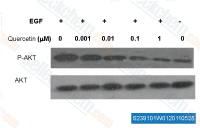
|
|
| S9726 | Rimiducid (AP1903) | Rimiducid (AP1903) is a chemical protein dimerizer that binds tightly to the target FKBP fusion protein while binding minimally to the abundant natural FKBP. This compound elicits potent and dose-dependent apoptosis of cells in culture expressing dimerizer-dependent Fas constructs, with an EC50 of ≈0.1 nM. | ||
| S6615 | ATB 346 | ATB 346, a novel hydrogen sulphide-releasing derivative of naproxen with remarkably reduced toxicity, inhibits COX activity. This compound is an anti-inflammatory agent that induces apoptosis of human melanoma cells. | ||
| S5973 | Methylprednisolone Acetate | Methylprednisolone (NSC-19987, Medrol) acetate is a synthetic glucocorticoid receptor agonist, used to achieve prompt suppression of inflammation. Methylprednisolone activates ACE2 and reduces IL-6 levels, thus improves severe or critical COVID-19. Methylprednisolone markedly reduces autophagy and apoptosis. | ||
| S9631 | Puromycin aminonucleoside | Puromycin aminonucleoside (NSC 3056, PAN, Stylomycin aminonucleoside, ARDMA, SAN), the aminonucleoside portion of the antibiotic puromycin, is a reversible inhibitor of dipeptidyl-peptidase II and cytosol alanyl aminopeptidase that induces apoptosis in mesangial cells (MCs) accompanied by declined cell viability and enhanced inflammatory response.This compound can be used to induce animal models of Kidney Disease. | ||
| S5958 | Metformin | Metformin (1,1-Dimethylbiguanide), a widely used drug for treatment of type 2 diabetes, activates AMP-activated protein kinase (AMPK) in hepatocytes. Metformin promotes mitophagy in mononuclear cells. Metformin induces apoptosis of lung cancer cells through activating JNK/p38 MAPK pathway and GADD153. | ||
| S0103 | ML327 | ML327 is an isoxazole compound that blocks MYC expression and tumor formation in neuroblastoma. This compound also restores E-cadherin expression with In-Cell Western EC50 of 1.0 μM. It induces apoptosis. | ||
| S7409 | Anisomycin (Flagecidin) | Anisomycin (Flagecidin, Wuningmeisu C) is a bacterial antibiotic isolated from Streptomyces griseolus, which inhibits protein synthesis, and also act as a JNK activator. Anisomycin upregulates autophagy and increases apoptosis. |
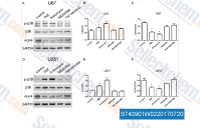
|
|
| S0354 | Alsterpaullone | Alsterpaullone (Alp, 9-Nitropaullone, NSC 705701) is a potent inhibitor of CDK with IC50 of 35 nM, 15 nM, 200 nM and 40 nM for CDK1/cyclin B, CDK2/cyclin A, CDK2/cyclin E and CDK5/p35, respectively. This compound also acts as a potent inhibitor of glycogen synthase kinase-3 (GSK-3) with IC50 of both 4 nM for GSK-3α and GSK-3β. It induces apoptosis by activation of caspase-9. This chemical has antitumor activity and possesses potential for the treatment of neurodegenerative and proliferative disorders. | ||
| S6882 | HI-TOPK-032 | HI-TOPK-032 is a potent and specific inhibitor of TOPK. This compound also reduces ERK-RSK phosphorylation, regulates of the abundance of p53, cleaved caspase-7, and cleaved PARP, and induces apoptosis in cancer cells. | ||
| S4513 | RGD peptide (GRGDNP) | RGD peptide (GRGDNP) is an inhibitor of binding of integrins to the extracellular matrixs. This compound induces apoptosis presumably through direct activation of caspase-3. | ||
| S9054 | Pectolinarin | Pectolinarin is a major compound in Cirsium setidens with anti-inflammatory activity. This compound inhibits secretion of IL-6 and IL-8, as well as the production of PGE2 and NO. It also induces apoptosis via inactivation of the PI3K/Akt pathway. | ||
| S7274 | HLY78 | HLY78 inhibits apoptosis in tumor cells and embryonic cells caused by carbon ion radiation through activation of the Wnt/β-catenin pathway. | ||
| S6885 | Ailanthone | Ailanthone (AIL, Δ13-Dehydrochaparrinone), a natural anti-hepatocellular carcinoma (HCC) component in Ailanthus altissima, induces G0/G1-phase cell cycle arrest by decreasing expression of cyclins and CDKs and increases expression of p21 and p27. This compound triggers DNA damage characterized by activation of the ATM/ATR pathway. It induces apoptosis which is mitochondrion-mediated and involves the PI3K/AKT signaling pathway in Huh7 cells. This chemical is also a potent inhibitor of both full-length Androgen Receptor (AR-FL) and constitutively active truncated AR splice variants (AR-Vs, AR1-651) with IC50 of 69 nM and 309 nM, respectively. | ||
| S3576 | TVB-3166 | TVB-3166 is an orally-available, reversible, potent and selective inhibitor of fatty acid synthase (FASN) with IC50 of 0.042 μM in an in vitro biochemical assay. This compound induces apoptosis, and inhibits in-vivo xenograft tumor growth. | ||
| S8965 | BO-264 | BO-264 is a potent and orally active inhibitor of transforming acidic coiled-coil 3 (TACC3) with IC50 of 188 nM and Kd of 1.5 nM. This compound specifically blocks the function of FGFR3-TACC3 fusion protein. It induces SAC-dependent mitotic arrest, apoptosis and DNA damage with antitumor activities. | ||
| S9665 | Motixafortide (BKT140) | Motixafortide (BL-8040, BKT140, TF 14016, 4-fluorobenzoyl, 4F-benzoyl-TN14003, T140) is an antagonist of CXCR4 with IC50 of ~1 nM. BL-8040 induces the apoptosis of AML blasts by down-regulating ERK, BCL-2, MCL-1 and cyclin-D1 via altered miR-15a/16-1 expression. | ||
| S0407 | XCT790 | XCT-790 (Compound 12) is a potent and selective inverse agonist for estrogen-related receptor α (ERRα) with IC50 of 0.37 μM. XCT-790 (Compound 12) is inactive against ERRγ and the estrogen receptors ERα and ERβ. XCT-790 (Compound 12) significantly inhibits in vivo tumor growth and angiogenesis, and induces apoptosis. | ||
| S8981 | NVP-2 | NVP-2, a potent, selective, non-neurotoxic and ATP-competitive cyclin dependent kinase 9 (CDK9) inhibitor with IC50 of 0.514 nM for CDK9/CycT activity and induces cell apoptosis. | ||
| S2942 | EB-3D | EB-3D is a potent and selective inhibitor of choline kinase α (ChoKα) with IC50 of 1 μM for ChoKα1. This compound induces deregulation of the AMPK-mTOR pathway and apoptosis in leukemia T-cells. | ||
| S9602 | Elraglusib | Elraglusib(9-ING-41) is a potent inhibitor of glycogen synthase kinase-3 (GSK-3) with antitumor activity. 9-ING-41 induces apoptosis and cell cycle arrest at prophase by targeting centrosomes and microtubule-bound GSK3β. | ||
| S9604 | Lixumistat (IM156) | Lixumistat (IM156) is a potent activator of AMPK that increases AMPK phosphorylation. It blocks oxidative phosphorylation (OXPHOS) through the inhibition of complex I and increases apoptosis. This compound ameliorates various types of fibrosis and inhibits tumors. | ||
| S3604 | Triptolide | Triptolide is a diterpene triepoxide, immunosuppresive agent extracted from the Chinese herb Tripterygium wilfordii. It functions as a NF-κB inhibitor with dual actions by disruption of p65/CBP interaction and by reduction of p65 protein. Triptolide (PG490) abrogates the transactivation function of heat shock transcription factor 1 (HSF1). Triptolide inhibits MDM2 and induces apoptosis through a p53-independent pathway. |
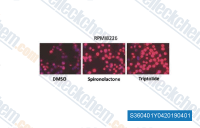
|
|
| S5584 | Citronellol | Citronellol (Dihydrogeraniol, (±)-β-Citronellol), a constituent of rose and geranium oils, is used in perfumes and insect repellents. This compound can cause necrotic apoptosis of NCI-H1299 cells by up-regulating TNF-α, RIP1 / RIP3 activities, and down-regulating caspase-3 / caspase-8 activities. It also results in a biphasic increase in ROS production at 1 h and at 12 h in NCI-H1299 cells. | ||
| S4476 | PCNA-I1 | PCNA-I1 is a selective inhibitor of proliferating cell nuclear antigen (PCNA, a potential anticancer target). This compound selectively binds to PCNA trimers with Kd of ~0.2 to 0.4 μM. It inhibits the growth of tumor cells of various tissue types with IC50 of ~0.2 μM. This chemical induces DNA damage and apoptosis in both LNCaP and PC-3 cells. It also induces autophagy in PC-3 cells. | ||
| S0445 | SC-43 | SC-43, a sorafenib derivative, is an agonist of Src-homology protein tyrosine phosphatase-1 (SHP-1/PTPN6) and reduces liver fibrosis. This compound reduces p-STAT3 and induces apoptosis with anti-tumor activity. | ||
| S0884 | RA-9 | RA-9 is a cell-permeable, potent and selective inhibitor of proteasome-associated deubiquitinating enzymes (DUBs) with favorable toxicity profile and anticancer activity. This compound selectively induces apoptosis in ovarian cancer cell lines. | ||
| S4423 | Emamectin Benzoate | Emamectin Benzoate (EMB, MK-244) activates gamma-amino butyric acid (GABA) transporter. This compound induces of reactive oxygen species (ROS)-mediated DNA damage and apoptosis. | ||
| E0129 | Oxysophocarpine | Oxysophocarpine (OSC) is an alkaloid extracted from Sophora alopecuroides. This compound inhibits the growth and metastasis of oral squamous cell carcinoma (OSCC) by targeting the Nrf2/HO-1 axis. It protects cells against apoptosis and inflammatory responses and compromised miR-155 activity by attenuating MAPK and NF-κB pathways. | ||
| E7797 | Mitoguazone | Mitoguazone (MGBG, Methyl-GAG) is a polyamine analog that disrupts polyamine biosynthesis by inhibiting S-adenosylmethionine decarboxylase (SAMDC). It induces apoptosis and triggers p53-independent programmed cell death in the MCF7 cell line. It also inhibits the integration of HIV DNA into cellular DNA in both monocytes and macrophages. | ||
| S0231 | NSC15364 | NSC 15364 (compound 59) is an inhibitor that directly interacts with VDAC1 and prevents VDAC1 oligomerization, concomitant with an inhibition of apoptosis. | ||
| S1273 | Amarogentin |
Amarogentin (AG), a secoiridoid glycoside mainly extracted from Swertia and Gentiana roots, exhibits anti-oxidative, anti-tumour, and anti-diabetic activities. This compound is an agonist for the bitter taste receptor TAS2R1 and inhibits in LAD-2 cells substance P-induced production of newly synthesized TNF-α. It induces apoptosis in human gastric cancer cells (SNU-16) through G2/M cell cycle arrest and PI3K/Akt signalling pathway. This chemical interacts with the α2 subunit of AMP-activated protein kinase (AMPK) and activates the trimeric kinase with EC50 of 277 pM. |
||
| S3256 | Tectochrysin | Tectochrysin (Techtochrysin, NSC 80687) is one of the major flavonoids of Alpinia oxyphylla Miquel. This compound significantly increases the expression of DR3, DR4 and Fas and inhibits activity of NF-κB. It induces apoptotic cell death. | ||
| S9805 | WM-3835 | WM-3835 is a novel and high-specific small molecule Lysine Acetyltransferase 7 (KAT7, MYST2, HBO1) inhibitor, able to potently suppressed OS cell proliferation and migration, and leads to apoptosis activation. | ||
| E2374 | PI-273 | PI-273, the first reversibly and specific phosphatidylinositol 4-kinase (PI4KIIα) inhibitor with an IC50 of 0.47 μM, can inhibit breast cancer cell proliferation, block the cell cycle and induce cell apoptosis. | ||
| S2412 | Genipin | Genipin((+)-Genipin) is an active aglycone derived from an iridoid glycoside called geniposide, which is found in the fruit of Gardenia jasminoides Ellis. |

|
|
| E2631 | Colcemid | Colcemid (Demecolcine), a derivative of colchicine, is a potent mitotic inhibitor which can incuces cell apoptosis and can be used for cancer research. | ||
| S9562 | Pomolic acid | Pomolic acid is a pentacyclic triterpene isolated from Euscaphis japonica, and is highly effective in inhibiting cell growth and induces apoptosis. | ||
| E3523 | Antrodia cinnamomea Extract | Antrodia Cinnamomea Extract is extracted from Antrodia Cinnamomea, which is a novel anticancer agent in tamoxifen-resistant breast cancer management. | ||
| E1223 | RGX-202 | RGX-202 is an SLC6A8 transporter inhibitor which suppress the colon cancer tumor. In addition to significantly reducing intracellular phosphocreatine and ATP levels and inducing tumour apoptosis, this compound also inhibits creatine import both in vitro and in vivo. | ||
| E3535 | Japanese ardisia Extract | Japanese Ardisia Extract is extracted from Ardisia japonica, which induces apoptosis and inhibits proliferation in human pancreatic cancer cells. | ||
| E3536 | Pleurotus ostreatus Extract | Pleurotus ostreatus Extract is extracted from Pleurotus ostreatus, which decreases the proliferation of leukaemia cells through apoptosis. | ||
| E0808 | BI-6C9 | BI-6C9 is a highly specific BH3 interacting domain (Bid) inhibitor, which prevents mitochondrial outer membrane potential (MOMP) and mitochondrial fission, and protects the cells from mitochondrial apoptosis inducing factor (AIF) release and caspase-independent cell death in neurons. | ||
| S3267 | Nicotiflorin (Kaempferol-3-O-rutinoside) | Nicotiflorin (Kaempferol-3-O-rutinoside), a flavonoid extracted from Carthamus tinctorius, alters the shape and structure of injured neurons, decreases the number of apoptotic cells, down-regulates expression of p-JAK2, p-STAT3, caspase-3, and Bax and decreases Bax immunoredactivity, and increases Bcl-2 protein expression and immunoreactivity. | ||
| E3844 | Polygonatum Odoratum Extract | Polygonatum Odoratum Extract is extracted from Polygonatum odoratum, which inhibits high glucose-induced tubular epithelial cell apoptosis and reduces oxidative stress. | ||
| E3095 | Pyrethrum Extract | Pyrethrum Extract is extracted from Pyrethrum, which can induce apoptosis in HCT cells, and therefore, it can be used as a novel therapeutic for colorectal cancer treatment. | ||
| E3884 | Galium Aparine Extract | Galium Aparine Extract is extracted from Galium aparine, which may have a potential anti-cancer effect against breast cancer cells without impairing normal breast epithelial cells. | ||
| E3266 | Black Carrot Extract | Black Carrot Extract is extrcated from Daucus carota ssp. sativus var. atrorubens, which is a neuroprotective agent. | ||
| E4789 | Bleomycin hydrochloride | Bleomycin hydrochloride is a natural antibiotic, an inhibitor of DNA synthesis. It binds to nuclear DNA, targeting and killing dividing cells in G2 and M phases. It exhibits anticancer activity, showing efficacy against squamous cell carcinoma (SCC) with an IC50 of 4.0 nM in the UT-SCC-19A cell line. | ||
| E3348 | Capsella bursa-pastoris Extract | Capsella Bursa-Pastoris Extract is extracted from Capsella Bursa-Pastoris, which aids in fever, improving eyesight and calming the liver. | ||
| E3376 | Saw palmetto Extract | Saw Palmetto Extract is extrcated from Serenoa repens, which has anti-androgenic, pro-apoptotic, and anti-inflammatory effects. | ||
| E7972 | Isosilybin A | Isosilybin A is a flavonolignan isolated from silymarin that exhibits anti-prostate cancer (PCA) efficacy with an IC50 of 32 μM in DU145 cells. It induces growth inhibition, G1 arrest, and apoptosis in PCA cells by targeting the Akt-NF-κB-AR axis, highlighting its potential as a therapeutic agent in clinical prostate cancer (PCA) management. | ||
| S5045 | Nomilin | Nomilin is a triterpenoid present in common edible citrus fruits with putative anticancer properties. | ||
| E3436 | Liquidambar formosana Extract | Liquidambar Formosana Extract is extracted from the dried and mature fruits of Liquidambar Formosana, which can inhibit sarcoma cancer cells by inducing apoptosis. | ||
| E3148 | Euphorbiae Humifusae Herba Extract | Euphorbiae Humifusae Herba Extract is extracted from Euphorbiae Humifusae, which induces apoptosis in Hep3B hepatocarcinoma cells and can be a treatment for hepatocellular carcinoma. | ||
| E1327 | CWI1-2 hydrochloride | CWI1-2 hydrochloride is an inhibitor of IGF2BP2 that binds IGF2BP2 and inhibits its interaction with m6A-modified target transcripts, induces apoptosis and differentiation, and shows promising anti-leukemic effects. | ||
| E3455 | Puff-ball Extract | Puff-Ball Extract is extracted from Calvatia, which has inhibitory effects on the proliferation of breast cancer cells through apoptosis. | ||
| E7531 | Necrostatin 2 | Necrostatin-2 is a potent inhibitor of necroptosis with an EC50 of 50 nM in FADD-deficient Jurkat T cells treated with TNF-α. | ||
| E1232 | Concanavalin A | Concanavalin A is a potential anti-neoplastic agent targeting apoptosis, autophagy and anti-angiogenesis for cancer therapeutics. | ||
| S8037 | Necrostatin-1 (Nec-1) | Necrostatin-1 (Nec-1) is a specific RIP1 (RIPK1) inhibitor and inhibits TNF-α-induced necroptosis with EC50 of 490 nM in 293T cells. Necrostatin-1 also blocks IDO and suppresses autophagy and apoptosis. |

|
|
| S1077 | SB202190 | SB202190 is a potent p38 MAPK inhibitor targeting p38α/β with IC50 of 50 nM/100 nM in cell-free assays, sometimes used instead of SB 203580 to investigate potential roles for SAPK2a/p38 in vivo. This compound inhibits endothelial cell apoptosis via induction of autophagy and heme oxygenase-1. It significantly suppresses Erastin‐dependent ferroptosis. |

|
|
| S7033 | GSK2656157 | GSK2656157 is an ATP-competitive and highly selective inhibitor of PERK with IC50 of 0.9 nM in a cell-free assay, 500-fold greater against a panel of 300 kinases. This compound decreases apoptosis and inhibits excessive autophagy. |

|
|
| S2872 | GW5074 | GW5074 is a potent and selective c-Raf inhibitor with IC50 of 9 nM, no effect on the activities of JNK1/2/3, MEK1, MKK6/7, CDK1/2, c-Src, p38 MAP, VEGFR2 or c-Fms is noted. This compound inhibits LK-induced apoptosis. |

|
|
| S1386 | Nafamostat mesilate (FUT-175) | Nafamostat mesilate (FUT-175) is a synthetic serine protease inhibitor used as an anticoagulant during hemodialysis. It blocks activation of SARS-CoV-2 and is investigated as a new treatment option for COVID-19. This compound also attenuates inflammation and apoptosis. |

|
|
| S8632 | BML-277 (Chk2 Inhibitor II) | BML-277 (Chk2 Inhibitor II) is an ATP-competitive inhibitor of Chk2 with IC50 of 15 nM, and it is 1000-fold more selective toward Chk2 serine/threonine kinase than for Chk1 and Cdk1/B kinases. This compound dose dependently protects human CD4(+) and CD8(+) T-cells from apoptosis due to ionizing radiation. | ||
| S1132 | 3-Aminobenzamide | 3-Aminobenzamide (3-ABA , 3-Amino Benzamide, 3-AB) is a potent inhibitor of Poly(ADP-ribose)polymerase (PARP) and inhibits cell apoptosis after SCI (Spinal Cord Injury) in caspase-independent way. |

|
|
| S8974 | GSK2795039 | GSK2795039 is an inhibitor of NADPH oxidase 2 (NOX2) with pIC50 of 6.57 for NOX2-mediated activation of HRP/Amplex Red. This compound inhibits reactive oxygen species (ROS) production, NADPH consumption and reduces apoptosis. | ||
| S1733 | Methylprednisolone | Methylprednisolone is a synthetic glucocorticoid receptor agonist, used to achieve prompt suppression of inflammation. This compound activates ACE2 and reduces IL-6 levels, thus improves severe or critical COVID-19. It markedly reduces autophagy and apoptosis. |

|
|
| S3275 | Senkyunolide I | Senkyunolide I (SEI, SENI) is an orally active compound isolated from Ligusticum chuanxiong with analgesic, anti-migraine, neuroprotective, anti-oxidation and anti-apoptosis activities. This compound up-regulates the phosphorylation of Erk1/2 and induces Nrf2 nuclear translocation with enhanced HO-1 and NQO1 expressions. It also promotes the ratio of Bcl-2/Bax and inhibits the expressions of cleaved caspase 3 and caspase 9. | ||
| S9668 | PKR-IN-C16 | PKR-IN-C16 (imoxin, C16, Imidazolo-oxindole PKR inhibitor C16) is a specific inhibitor of RNA-dependent protein kinase (PKR, Protein Kinase R, EIF2AK2). This compound prevents apoptosis and IL-1β production in an acute excitotoxic rat model with a neuroinflammatory component. | ||
| S6812 | Z-Guggulsterone | Z-Guggulsterone, a constituent of Ayurvedic medicinal plant Commiphora mukul, inhibits angiogenesis in vitro and in vivo. This compound exhibits anti-inflammatory effects in microglia. It induces apoptosis in gastric cancer cells through the intrinsic mitochondria-dependent pathway. | ||
| S0411 | BAM 15 | BAM 15 is a novel mitochondrial protonophore uncoupler capable of protecting mammals from acute renal ischemic-reperfusion injury and cold-induced microtubule damage. This compound is also a potent AMPK activator. It attenuates transportation-induced apoptosis in iPS-differentiated retinal tissue. | ||
| S3294 | Demethyl-Coclaurine | Demethyl-Coclaurine (Higenamine, Norcoclaurine), the key component of the Chinese herb aconite root, is a beta-2 adrenergic receptor (β2-AR) agonist. This compound stimulates AKT phosphorylation and requires PI3K activation for the anti-apoptotic effect in cardiomyocytes. | ||
| S3236 | Mesaconitine | Mesaconitine, one of the aconite alkaloids in Aconiti tuber, increases the [Ca2+]i level in endothelial cells by influx of Ca2+ from extracellular spaces. | ||
| S3269 | Acetylcorynoline | Acetylcorynoline, a major alkaloid component derived from Corydalis bungeana which is a traditional Chinese medical herb, shows anti-inflammatory properties. This compound may decrease egl-1 expression to suppress apoptosis pathways and increase rpn5 expression to enhance the activity of proteasomes. | ||
| S0947 | Cafestol | Cafestol is a natural diterpenes extracted from coffee beans. It induces apoptosis and regulates a variety of inflammatory mediators to reduce inflammation. This compound inhibits the PI3K/Akt pathway and can also reduce the production of ROS in the leukemia cell line HL60. | ||
| S0539 | BTZO-1 | BTZO-1 binds to macrophage migration inhibitory factor (MIF) with Kd of 68.6 nM. This compound activats antioxidant response element (ARE)-mediated gene expression and suppresses oxidative stress-induced cardiomyocyte apoptosis in vitro. | ||
| E0020 | Lupenone | Lupenone (Lup-20(29)-en-3-one, lupeone) is an isolated compound exhibiting anti-oxidative, anti-inflammation, and anti-diabetic activities. This compound can protect SH-SY5y cells against METH-induced neuronal apoptosis through the PI3K/Akt pathway. | ||
| S5973 | Methylprednisolone Acetate | Methylprednisolone (NSC-19987, Medrol) acetate is a synthetic glucocorticoid receptor agonist, used to achieve prompt suppression of inflammation. Methylprednisolone activates ACE2 and reduces IL-6 levels, thus improves severe or critical COVID-19. Methylprednisolone markedly reduces autophagy and apoptosis. | ||
| S7274 | HLY78 | HLY78 inhibits apoptosis in tumor cells and embryonic cells caused by carbon ion radiation through activation of the Wnt/β-catenin pathway. | ||
| E0129 | Oxysophocarpine | Oxysophocarpine (OSC) is an alkaloid extracted from Sophora alopecuroides. This compound inhibits the growth and metastasis of oral squamous cell carcinoma (OSCC) by targeting the Nrf2/HO-1 axis. It protects cells against apoptosis and inflammatory responses and compromised miR-155 activity by attenuating MAPK and NF-κB pathways. | ||
| S0231 | NSC15364 | NSC 15364 (compound 59) is an inhibitor that directly interacts with VDAC1 and prevents VDAC1 oligomerization, concomitant with an inhibition of apoptosis. | ||
| S0913 | 4',5,7-Trimethoxyflavone | 4',5,7-Trimethoxyflavone (5,7,4'-Trimethoxyflavone, TMF) is a flavonoid isolated from Kaempferia parviflora (KP) that induces apoptosis. This compound increases sub-G1 phase, DNA fragmentation, annexin-V/PI staining and Bax/Bcl-xL ratio, activates caspase-3 and degrades poly (ADP-ribose) polymerase (PARP) protein. | ||
| S3271 | Caudatin | Caudatin (Cauldatin), one species of C‑21 steroidal from Cynanchum auriculatum (C. auriculatum), effectively inhibits human glioma growth in vitro and in vivo through triggering cell cycle arrest and apoptosis. | ||
| S0931 | Jaceosidin | Jaceosidin, a flavonoid isolated from Artemisia vestita, possesses anti-tumor and anti-proliferative activities in many cancer cells. This compound induces apoptosis, activates Bax and down-regulates Mcl-1 and c-FLIP expression. It also inhibits COX-2 expression and NF-κB activation. | ||
| S3829 | Isoalantolactone | Isoalantolactone, one of the major sesquiterpene lactone compounds, is isolated from the roots of Anula helenium and possesses multiple biological activities including antifungal, anthelmintic, antimicrobial, anti-inflammatory, antitrypanosomal activities and antiproliferative effects on several cancer cell lines, such as colon, melanoma, ovary, prostate, lung, and leukemia. This compound is an apoptosis inducer, which also acts as an alkylating agent. | ||
| S3336 | Heptadecanoic acid | Heptadecanoic acid (C17:0), an odd chain saturated fatty acid, significantly inhibits cell proliferation, and migration, while promoting apoptosis in PC‑9 and PC‑9/GR cells. This compound is associated with several diseases, including the incidence of coronary heart disease, prediabetes and type 2 diabetes as well as multiple sclerosis. |
||
| S6957 | β-Elemene | β-Elemene ((-)-β-Elemene, Levo-β-elemene) is a sesquiterpene compound extracted from the herb Curcuma Rhizoma with antitumor activities. β-elemene can inhibit cell proliferation, arrest the cell cycle, and induce cell apoptosis or autophagy. |
||
| S3357 | Elaidic acid | Elaidic acid is a major trans fatty acid that inhibits cell viability, elevates cell apoptosis by enhancing oxidative stress. This compound can be used as a pharmaceutical solvent. |
||
| S1078 | MK-2206 Dihydrochloride | MK-2206 2HCl is a highly selective inhibitor of Akt1/2/3 with IC50 of 8 nM/12 nM/65 nM in cell-free assays, respectively; no inhibitory activities against 250 other protein kinases observed. This compound induces autophagy and apoptosis in cancer cells. Phase 2. |

|
|
| S1105 | LY294002 | LY294002 (SF 1101, NSC 697286) is the first synthetic molecule known to inhibit PI3Kα/δ/β with IC50 of 0.5 μM/0.57 μM/0.97 μM, respectively; more stable in solution than Wortmannin, and also blocks autophagosome formation. It not only binds to class I PI3Ks and other PI3K-related kinases, but also to novel targets seemingly unrelated to the PI3K family. This compound also inhibits CK2 with IC50 of 98 nM. It is a non-specific DNA-PKcs inhibitor and activates autophagy and apoptosis. |

|
|
| S2673 | Trametinib (GSK1120212) | Trametinib (GSK1120212, JTP-74057) is a highly specific and potent MEK1/2 inhibitor with IC50 of 0.92 nM/1.8 nM in cell-free assays, and it does not inhibit the kinase activities of c-Raf, B-Raf, ERK1/2. This compound activates autophagy and induces apoptosis. |

|
|
| S1460 | SP600125 | SP600125 (Nsc75890) is a broad-spectrum JNK inhibitor for JNK1, JNK2 and JNK3 with IC50 of 40 nM, 40 nM and 90 nM in cell-free assays, respectively; 10-fold greater selectivity against MKK4, 25-fold greater selectivity against MKK3, MKK6, PKB, and PKCα, and 100-fold selectivity against ERK2, p38, Chk1, EGFR etc. This compound is also a broad‐spectrum inhibitor of serine/threonine kinases including Aurora kinase A,FLT3 and TRKA with of IC50 of 60 nM, 90 nM and 70 nM. It inhibits autophagy and activates apoptosis. |

|
|
| S1208 | Doxorubicin (Adriamycin) Hydrochloride | Doxorubicin (DOX) HCl is an antibiotic agent that inhibits human DNA topoisomerase II with IC50 of 2.67 μM. Doxorubicin reduces basal phosphorylation of AMPK. Doxorubicin is used in the concomitant treatment of HIV-infected patients but is found to be at high risk of HBV reactivation.This product may precipitate when dissolved in PBS solution. It is recommended to prepare the stock solution in pure water and dilute with either pure water or saline to obtain the working solution.Doxorubicin (Adriamycin) HCl can be used to induce animal models of kidney disease. |

|
|
| S1120 | Everolimus (RAD001) | Everolimus is an mTOR inhibitor of FKBP12 with IC50 of 1.6-2.4 nM in a cell-free assay. Everolimus induces cell apoptosis and autophagy and inhibits tumor cells proliferation. |

|
|
| S1008 | Selumetinib (AZD6244) | Selumetinib (AZD6244, ARRY-142886) is a potent, highly selective MEK inhibitor with IC50 of 14 nM for MEK1 and Kd value of 530 nM for MEK2. It also inhibits ERK1/2 phosphorylation with IC50 of 10 nM, with no inhibition to p38α, MKK6, EGFR, ErbB2, ERK2, B-Raf, etc. This compound suppresses cell proliferation, migration and trigger apoptosis. Phase 3. |

|
|
| S1025 | Gefitinib (ZD1839) | Gefitinib is an EGFR inhibitor for Tyr1173, Tyr992, Tyr1173 and Tyr992 in the NR6wtEGFR and NR6W cells with IC50 of 37 nM, 37nM, 26 nM and 57 nM, respectively. This compound promotes autophagy and apoptosis of lung cancer cells via blockade of the PI3K/AKT/mTOR pathway. |

|
|
| S1378 | Ruxolitinib (INCB18424) | Ruxolitinib (INCB18424) is the first potent, selective JAK1/2 inhibitor to enter the clinic with IC50 of 3.3 nM/2.8 nM in cell-free assays, >130-fold selectivity for JAK1/2 versus JAK3. This compound kills tumor cells through toxic mitophagy. It induces autophagy and enhances apoptosis. |

|
|
| S1021 | Dasatinib | Dasatinib is a novel, potent and multi-targeted inhibitor that targets Abl, Src and c-Kit, with IC50 of <1 nM, 0.8 nM and 79 nM in cell-free assays, respectively. Dasatinib induces autophagy and apoptosis with anti-tumor activity. |

|
|
| S7397 | Sorafenib (BAY 43-9006) | Sorafenib is a multikinase inhibitor of Raf-1 and B-Raf with IC50 of 6 nM and 22 nM in cell-free assays, respectively. Sorafenib inhibits VEGFR-2, VEGFR-3, PDGFR-β, Flt-3 and c-KIT with IC50 of 90 nM, 20 nM, 57 nM, 59 nM and 68 nM, respectively. Sorafenib induces autophagy and apoptosis and activates ferroptosis with anti-tumor activity. |

|
|
| S1065 | Pictilisib (GDC-0941) | Pictilisib (GDC-0941, RG7321) is a potent inhibitor of PI3Kα/δ with IC50 of 3 nM in cell-free assays, with modest selectivity against p110β (11-fold) and p110γ (25-fold). Pictilisib (GDC-0941) induces autophagy and apoptosis. Phase 2. |

|
|
| S1053 | Entinostat (MS-275) | Entinostat (MS-275, SNDX-275) strongly inhibits HDAC1 and HDAC3 with IC50 of 0.51 μM and 1.7 μM in cell-free assays, compared with HDACs 4, 6, 8, and 10. This compound induces autophagy and apoptosis. Phase 3. |

|
|
| S1413 | Bafilomycin A1 (Baf-A1) | Bafilomycin A1 (Baf-A1) is a vacuolar H+-ATPase inhibitor with IC50 of 0.44 nM, and it is found to inhibit autophagy while inducing apoptosis. |

|
|
| S1030 | Panobinostat (LBH589) | Panobinostat (LBH589, NVP-LBH589) is a novel broad-spectrum HDAC inhibitor with IC50 of 5 nM in a cell-free assay. It induces autophagy and apoptosis, and effectively disrupts HIV latency in vivo. Phase 3. |

|
|
| S2215 | DAPT | DAPT is a novel γ-secretase inhibitor, which inhibits Aβ production with IC50 of 20 nM in HEK 293 cells. DAPT enhances the apoptosis of human tongue carcinoma cells and regulates autophagy. |

|
|
| S1133 | Alisertib (MLN8237) | Alisertib (MLN8237) is a selective Aurora A inhibitor with IC50 of 1.2 nM in a cell-free assay, and it has >200-fold higher selectivity for Aurora A than Aurora B. This compound induces cell cycle arrest, apoptosis and autophagy. Phase 3. |
-S113303W0120130926.gif)
|
|
| S1002 | ABT-737 | ABT-737 is a BH3 mimetic inhibitor of Bcl-xL, Bcl-2 and Bcl-w with EC50 of 78.7 nM, 30.3 nM and 197.8 nM in cell-free assays, respectively; no inhibition observed against Mcl-1, Bcl-B or Bfl-1. ABT-737 induces mitochondrial pathway apoptosis and mitophagy. Phase 2. |

|
|
| S2913 | BAY 11-7082 (BAY 11-7821) | BAY 11-7082 (BAY 11-7821) is a NF-κB inhibitor, inhibits TNFα-induced IκBα phosphorylation with IC50 of 10 μM in tumor cells. BAY 11-7082 inhibits ubiquitin-specific protease USP7 and USP21 with IC50 of 0.19 μM and 0.96 μM, respectively. BAY 11-7082 induces apoptosis and S phase arrest in gastric cancer cells. |

|
|
| S1225 | Etoposide | Etoposide is a semisynthetic derivative of podophyllotoxin, which inhibits DNA synthesis via topoisomerase II inhibition activity which enhances double-strand and single-strand cleavage of DNA and reversibly inhibits repair by topoisomerase II binding. Etoposide induces autophagy, mitophagy and apoptosis. |

|
|
| S1109 | BI 2536 | BI-2536 is a potent Plk1 inhibitor with IC50 of 0.83 nM in a cell-free assay. BI-2536 inhibits Bromodomain 4 (BRD4) with Kd of 37 nM and potently suppresses c-Myc expression. BI-2536 induces apoptosis and attenuates autophagy. Phase 2. |

|
|
| S2247 | Buparlisib (BKM120) | Buparlisib (BKM120, NVP-BKM120) is a selective PI3K inhibitor of p110α/β/δ/γ with IC50 of 52 nM/166 nM/116 nM/262 nM in cell-free assays, respectively. Reduced potency against VPS34, mTOR, DNAPK, with little activity to PI4Kβ. Buparlisib induces apoptosis. Phase 2. |

|
|
| S1040 | Sorafenib tosylate | Sorafenib tosylate is a multikinase inhibitor of Raf-1 and B-Raf with IC50 of 6 nM and 22 nM in cell-free assays, respectively. This compound inhibits VEGFR-2, VEGFR-3, PDGFR-β, Flt-3 and c-KIT with IC50 of 90 nM, 20 nM, 57 nM, 59 nM and 68 nM, respectively. It induces autophagy and apoptosis and activates ferroptosis with anti-tumor activity. |

|
|
| S1555 | AZD8055 | AZD8055 is a novel ATP-competitive mTOR inhibitor with IC50 of 0.8 nM in MDA-MB-468 cells with excellent selectivity (∼1,000-fold) against PI3K isoforms and ATM/DNA-PK. This compound induces caspase-dependent apoptosis and also induces autophagy. Phase 1. |

|
|
| S7024 | Stattic | Stattic, the first nonpeptidic small molecule, potently inhibits STAT3 activation and nuclear translocation with IC50 of 5.1 μM in cell-free assays, highly selectivity over STAT1. Stattic induces apoptosis. |

|
|
| S1714 | Gemcitabine | Gemcitabine, a nucleic acid synthesis inhibitor, is a very potent and specific deoxycytidine analogue, used as chemotherapy. Gemcitabine induces a potent p53-dependent apoptosis. |

|
|
| S1004 | Veliparib (ABT-888) | Veliparib (ABT-888, NSC 737664) is a potent inhibitor of PARP1 and PARP2 with Ki of 5.2 nM and 2.9 nM in cell-free assays, respectively. This compound is inactive to SIRT2 and increases autophagy and apoptosis. Phase 3. |

|
|
| S7781 | Sunitinib (SU-11248) | Sunitinib is a multi-targeted RTK inhibitor targeting VEGFR2 (Flk-1) and PDGFRβ with IC50 of 80 nM and 2 nM, and also inhibits c-Kit. Sunitinib is also a dose-dependent inhibitor of the autophosphorylation activity of IRE1α. Sunitinib induces autophagy and apoptosis. |

|
|
| S1209 | 5-Fluorouracil (5-FU) | 5-FU (5-Fluorouracil) is a DNA/RNA synthesis inhibitor, which interrupts nucleotide synthetic by inhibiting thymidylate synthase (TS) in tumor cells. Fluorouracil induces apoptosis and can be used in the treatment of HIV. |

|
|
| S3020 | Romidepsin (FK228) | Romidepsin (FK228, Depsipeptide, FR 901228, NSC 630176) is a potent HDAC1 and HDAC2 inhibitor with IC50 of 36 nM and 47 nM in cell-free assays, respectively. This compound controls growth and induces apoptosis in neuroblastoma tumor cells. |

|
|
| S2853 | Carfilzomib (PR-171) | Carfilzomib (PR-171) is an irreversible proteasome inhibitor with IC50 of <5 nM in ANBL-6 cells. It displays preferential in vitro inhibitory potency against the ChT-L activity in the β5 subunit, but has little or no effect on the PGPH and T-L activities. This compound activates prosurvival autophagy and induces cell apoptosis. |

|
|
| S1237 | TMZ(Temozolomide) | Temozolomide (TMZ) is a monofunctional SN-1 alkylating agent that can modify nitrogen atoms in the DNA ring and the extracyclic oxygen group, chemically converted to MTIC and degrades to methyldiazonium cation, which transfers methyl groups to DNA at physiologic pH. It is a DNA damage inducer in L-1210 and L-1210/BCNU cells. This compound induces apoptosis and exhibits antitumor activity. |

|
|
| S5243 | Ruxolitinib (INCB18424) Phosphate | Ruxolitinib Phosphate (INCB018424, INC424) is the phosphate salt form of Ruxolitinib. Ruxolitinib is the first potent, selective, JAK1/2 inhibitor to enter the clinic with IC50 of 3.3 nM/2.8 nM in cell-free assays, >130-fold selectivity for JAK1/2 versus JAK3. Ruxolitinib kills tumor cells through toxic mitophagy. Ruxolitinib induces autophagy and enhances apoptosis. | ||
| S2662 | ICG-001 | ICG-001 antagonizes Wnt/β-catenin/TCF-mediated transcription and specifically binds to CREB-binding protein (CBP) with IC50 of 3 μM, but is not the related transcriptional coactivator p300. ICG-001 induces apoptosis. |

|
|
| S1200 | Decitabine (5-Aza-2'-Deoxycytidine) | Decitabine is a DNA methyltransferase inhibitor, incorporating into DNA and resulting in hypomethylation of DNA and intra-S-phase arrest of DNA replication. It is used to treat myelodysplastic syndrome (MDS). This compound induces cell cycle arrest and apoptosis in various cancer cell lines. |

|
|
| S1491 | Fludarabine | Fludarabine is a STAT1 activation inhibitor which causes a specific depletion of STAT1 protein (and mRNA) but not of other STATs. Also a DNA synthesis inhibitor in vascular smooth muscle cells. Fludarabine induces apoptosis. |

|
|
| S1623 | Acetylcysteine (N-Acetylcysteine, NAC) | Acetylcysteine (N-acetyl-l-cysteine, NAC, N-acetylcysteine) is a ROS(reactive oxygen species) inhibitor that antagonizes the activity of proteasome inhibitors. It is also a tumor necrosis factor production inhibitor, suppresses TNF-induced NF-κB activation through inhibition of IκB kinases, induces apoptosis via the mitochondria-dependent pathway, and inhibits ferroptosis and virus replication.Solutions are unstable and should be fresh-prepared. |

|
|
| S2235 | Volasertib (BI6727) | Volasertib is a highly potent Plk1 inhibitor with IC50 of 0.87 nM in a cell-free assay. It shows 6- and 65-fold greater selectivity against Plk2 and Plk3. Volasertib induces cell cycle arrest and apoptosis in various cancer cells. Phase 3. |

|
|
| S1042 | Sunitinib malate | Sunitinib malate is a multi-targeted RTK inhibitor targeting VEGFR2 (Flk-1) and PDGFRβ with IC50 of 80 nM and 2 nM in cell-free assays, and also inhibits c-Kit. Sunitinib Malate effectively inhibits autophosphorylation of Ire1α. Sunitinib Malate increases both death receptor and mitochondrial-dependent apoptosis. |

|
|
| S2789 | Tofacitinib (CP-690550) | Tofacitinib is a novel inhibitor of JAK3 with IC50 of 1 nM in cell-free assays, 20- to 100-fold less potent against JAK2 and JAK1. This compound inhibits the expression of antiapoptotic BCL-A1 and BCL-XL in human plasmacytoid dendritic cells (PDC) and induced PDC apoptosis. |

|
|
| S1029 | Lenalidomide (CC-5013) | Lenalidomide is a TNF-α secretion inhibitor with IC50 of 13 nM in PBMCs. Lenalidomide (CC-5013) is a ligand of ubiquitin E3 ligase cereblon (CRBN), and it causes selective ubiquitination and degradation of two lymphoid transcription factors, IKZF1 and IKZF3, by the CRBN-CRL4 ubiquitin ligase. Lenalidomide promotes cleaved caspase-3 expression and inhibit VEGF expression and induces apoptosis. |

|
|
| S1119 | Cabozantinib (XL184) | A potent VEGFR2 inhibitor with IC50 of 0.035 nM, Cabozantinib (XL184) also inhibits c-Met, Ret, Kit, Flt-1/3/4, Tie2, and AXL with IC50 of 1.3 nM, 4 nM, 4.6 nM, 12 nM/11.3 nM/6 nM, 14.3 nM and 7 nM in cell-free assays, respectively. It induces PUMA-dependent apoptosis in colon cancer cells via AKT/GSK-3β/NF-κB signaling pathway. |

|
|
| S1191 | Fulvestrant (ICI-182780) | Fulvestrant is an estrogen receptor (ER) antagonist with IC50 of 0.94 nM in a cell-free assay. Fulvestrant also induces autophagy and apoptosis and has antitumor activity. |

|
|
| S1526 | Quizartinib (AC220) | Quizartinib (AC220) is a second-generation FLT3 inhibitor for Flt3(ITD/WT) with IC50 of 1.1 nM/4.2 nM in MV4-11 and RS4;11 cells, respectively, 10-fold more selective for Flt3 than KIT, PDGFRα, PDGFRβ, RET, and CSF-1R. Quizartinib (AC220) induces apoptosis of tumor cells. Phase 3. |

|
|
| S7747 | Ro-3306 | RO-3306 is an ATP-competitive, and selective CDK1 inhibitor with Ki of 20 nM, >15-fold selectivity against a diverse panel of human kinases. RO-3306 enhances p53-mediated Bax activation and mitochondrial apoptosis. |

|
|
| S2248 | Silmitasertib (CX-4945) | Silmitasertib (CX-4945) is a potent and selective inhibitor of CK2 (casein kinase 2) with IC50 of 1 nM in a cell-free assay, although it is less potent against Flt3, Pim1 and CDK1 (inactive in cell-based assay). This compound induces autophagy and promotes apoptosis. Phase 1/2. |

|
|
| S1141 | Tanespimycin (17-AAG) | Tanespimycin (17-AAG, CP127374, NSC-330507, KOS 953) is a potent HSP90 inhibitor with IC50 of 5 nM in a cell-free assay, having a 100-fold higher binding affinity for HSP90 derived from tumour cells than HSP90 from normal cells. Tanespimycin (17-AAG) induces apoptosis, necrosis, autophagy and mitophagy. Phase 3. |

|
|
| S1020 | PD184352 (CI-1040) | PD184352 (CI-1040) is an ATP non-competitive MEK1/2 inhibitor with IC50 of 17 nM in cell-based assays, 100-fold more selective for MEK1/2 than MEK5. This compound selectively induces apoptosis. |

|
|
| S1786 | Verteporfin | Verteporfin is a small molecule that inhibits TEAD–YAP association and YAP-induced liver overgrowth. It is also a potent second-generation photosensitizing agent derived from porphyrin. Verteporfin is an autophagy inhibitor. Verteporfin inhibits cell proliferation and induces apoptosis. |

|
|
| S2704 | LY2109761 | LY2109761 is a novel selective TGF-β receptor type I/II (TβRI/II) dual inhibitor with Ki of 38 nM and 300 nM in a cell-free assay, respectively; shown to negatively affect the phosphorylation of Smad2. This compound blocks autophagy and induces apoptosis. |

|
|
| S1264 | PD173074 | PD173074 is a potent FGFR1 inhibitor with IC50 of ~25 nM and also inhibits VEGFR2 with IC50 of 100-200 nM in cell-free assays, ~1000-fold selective for FGFR1 than PDGFR and c-Src. PD173074 reduces proliferation and promotes apoptosis in gastric cancer cells. |

|
|
| S1241 | Vincristine sulfate | Vincristine sulfate is an inhibitor of polymerization of microtubules by binding to tubulin with IC50 of 32 μM in a cell-free assay. Vincristine sulfate induces apoptosis. |

|
|
| S1046 | Vandetanib | Vandetanib is a potent inhibitor of VEGFR2 with IC50 of 40 nM in a cell-free assay. It also inhibits VEGFR3 and EGFR with IC50 of 110 nM and 500 nM, respectively. Not sensitive to PDGFRβ, Flt1, Tie-2 and FGFR1 with IC50 of 1.1-3.6 μM. No activity against MEK, CDK2, c-Kit, erbB2, FAK, PDK1, Akt and IGF-1R with IC50 above 10 μM. This compound increases apoptosis and induces autophagy by increasing the level of reactive oxygen species (ROS). |

|
|
| S2194 | R406 | R406(R406 besylate) is a potent Syk inhibitor with IC50 of 41 nM in cell-free assays, strongly inhibits Syk but not Lyn, 5-fold less potent to Flt3. R406 induces apoptosis. Phase 1. |

|
|
| S1122 | Mocetinostat (MGCD0103) | Mocetinostat (MGCD0103, MG0103) is a potent HDAC inhibitor with most potency for HDAC1 with IC50 of 0.15 μM in a cell-free assay, 2- to 10- fold selectivity against HDAC2, 3, and 11, and no activity to HDAC4, 5, 6, 7, and 8. It induces apoptosis and autophagy, and is in Phase 2. |

|
|
| S1069 | Luminespib (NVP-AUY922) | Luminespib (AUY-922, NVP-AUY922, VER-52296) is a highly potent HSP90 inhibitor for HSP90α/β with IC50 of 13 nM /21 nM in cell-free assays, exhibits weaker potency against the HSP90 family members GRP94 and TRAP-1, and demonstrates the tightest binding of any small-molecule HSP90 ligand. It effectively downregulates and destabilizes the IGF-1Rβ protein, resulting in growth inhibition, autophagy and apoptosis. Phase 2. |

|
|
| S8146 | Mitomycin C | Mitomycin C (Ametycine) is an antineoplastic antibiotic by inhibiting DNA synthesis, used to treat different cancers. Mitomycin C induces apoptosis in a caspases-dependent and Fas/CD95-independent manner.This product is a hazardous chemical (acute toxicity/flammable/skin corrosive). Please use it while wearing a protective face mask, gloves, and clothing. |

|
|
| S1038 | PI-103 | PI-103 is a multi-targeted PI3K inhibitor for p110α/β/δ/γ with IC50 of 2 nM/3 nM/3 nM/15 nM in cell-free assays, less potent to mTOR/DNA-PK with IC50 of 30 nM/23 nM. This compound induces apoptosis in murine T-cell Lymphoma. |

|
|
| S2775 | Nocodazole | Nocodazole is a rapidly-reversible inhibitor of microtubule polymerization, also inhibits Abl, Abl(E255K) and Abl(T315I) with IC50 of 0.21 μM, 0.53 μM and 0.64 μM in cell-free assays, respectively. Nocodazole induces apoptosis. |

|
|
| S1567 | Pomalidomide (CC-4047) | Pomalidomide inhibits LPS-induced TNF-α release with IC50 of 13 nM in PBMCs. Pomalidomide can be utilized in PROTAC as a ligand for targeting E3 ligase and inhibiting the E3 ligase protein cereblon (CRBN). Pomalidomide promotes apoptosis and cell cycle arrest. |

|
|
| S1533 | R406 (free base) | R406 (free base) is a potent Syk inhibitor with IC50 of 41 nM in a cell-free assay, strongly inhibits Syk but not Lyn, 5-fold less potent to Flt3. This compound triggers apoptosis. Phase 1. |

|
|
| S4001 | Cabozantinib malate | Cabozantinib malate (XL184) is the malate of Cabozantinib, a potent VEGFR2 inhibitor with IC50 of 0.035 nM and also inhibits c-Met, Ret (c-Ret), Kit (c-Kit), Flt-1/3/4, Tie2, and AXL with IC50 of 1.3 nM, 4 nM, 4.6 nM, 12 nM/11.3 nM/6 nM, 14.3 nM and 7 nM in cell-free assays, respectively. This compound induces apoptosis. |

|
|
| S1052 | Elesclomol (STA-4783) | Elesclomol (STA-4783) is a novel potent oxidative stress inducer that elicits pro-apoptosis events among tumor cells. Phase 3.Elesclomol specifically binds ferredoxin 1 (FDX1) α2/α3 helices and β5 strand and inhibits FDX1-mediated Fe-S cluster biosynthesis.Elesclomol (STA-4783) is a potent copper ionophore and can be used in the research of copper-dependent cell death (cuproptosis). |

|
|
| S7818 | Pexidartinib (PLX3397) | Pexidartinib (PLX3397) is an oral, potent multi-targeted receptor tyrosine kinase inhibitor of CSF-1R, Kit (c-Kit), and FLT3 with IC50 of 20 nM, 10 nM and 160 nM, respectively. This compound induces apoptosis and necrosis with antitumor activity. Phase 3. |

|
|
| S7153 | 10058-F4 | 10058-F4 is a c-Myc inhibitor that specificallly inhibits the c-Myc-Max interaction and prevents transactivation of c-Myc target gene expression. 10058-F4 promotes a caspase-3-dependent apoptosis and modulates autophagy. |

|
|
| S1044 | Temsirolimus | Temsirolimus is a specific mTOR inhibitor with IC50 of 1.76 μM in a cell-free assay. This compound induces autophagy and apoptosis. |

|
|
| S2218 | Torkinib (PP242) | Torkinib (PP242) is a selective mTOR inhibitor with IC50 of 8 nM in cell-free assays; this compound targets both mTOR complexes with >10- and 100-fold selectivity for mTOR than PI3Kδ or PI3Kα/β/γ, respectively. It induces mitophagy and apoptosis. |

|
|
| S7152 | C646 | C646 is an inhibitor for histone acetyltransferase, and inhibits p300 with a Ki of 400 nM in a cell-free assay. Preferentially selective for p300 versus other acetyltransferases. C646 induces cell cycle arrest, apoptosis and autophagy. |

|
|
| S8041 | Cobimetinib (GDC-0973) | Cobimetinib (GDC-0973, RG7420) is a potent and highly selective MEK1 inhibitor with IC50 of 4.2 nM, showing no significant inhibition when tested against a panel of more than 100 serine-threonine and tyrosine kinases. This compound induces apoptosis. Phase 3. |

|
|
| S8075 | GANT61 | GANT61 (NSC 136476) is an inhibitor for GLI1 as well as GLI2-induced transcription, inhibits hedgehog with IC50 of 5 μM in GLI1 expressing HEK293T cell, displays selectivity over other pathways, such as TNF and glucocorticoid receptor gene transactivation. This compound induces apoptosis and activates protective autophagy in LX-2 cells. |

|
|
| S8049 | Tubastatin A | Tububastatin A is a potent and selective HDAC6 inhibitor with IC50 of 15 nM in a cell-free assay. It is selective against all the other isozymes (1000-fold) except HDAC8 (57-fold). This compound promotes autophagy and increases apoptosis. |

|
|
| S2727 | Dacomitinib | Dacomitinib is a potent, irreversible pan-ErbB inhibitor, mostly to EGFR with IC50 of 6 nM in a cell-free assay. This compound inhibits ERBB2 and ERBB4 with IC50 of 45.7 nM and 73.7 nM, respectively. It is effective against NSCLCs with EGFR or ERBB2 mutations as well as those harboring the EGFR T790M mutation. This chemical inhibits cell growth and induces apoptosis. Phase 2. |

|
|
| S7007 | Binimetinib (MEK162) | Binimetinib (MEK162, ARRY-162, ARRY-438162) is a potent inhibitor of MEK1/2 with IC50 of 12 nM in a cell-free assay. It induces G1 cell cycle arrest and apoptosis in human NSCLC cell lines and also triggers autophagy. Phase 3. |

|
|
| S2783 | Vistusertib (AZD2014) | Vistusertib (AZD2014) is a novel mTOR inhibitor with IC50 of 2.8 nM in a cell-free assay, and is highly selective against multiple PI3K isoforms (α/β/γ/δ). It showed no or weak binding to the majority of kinases when tested at 1 μM. This compound induces proliferation suppression, apoptosis, cell cycle arrest, and autophagy in HCC cells with antitumor activity. |

|
|
| S1108 | TAE684 (NVP-TAE684) | TAE684 (NVP-TAE684) is a potent and selective ALK inhibitor which blocked the growth of ALCL-derived and ALK-dependent cell lines with IC50 values between 2 and 10 nM, 100-fold more sensitive for ALK than InsR. This compound induces cell cycle arrest and apoptosis. |

|
|
| S2626 | Rabusertib (LY2603618) | Rabusertib (LY2603618, IC-83) is a highly selective Chk1 inhibitor with potential anti-tumor activity in a cell-free assay. IC50=7 nM, showing approximately 100-fold more potent against Chk1 than against any of the other protein kinases evaluated. Rabusertib (LY2603618) induces cell cycle arrest, DNA damage response and autophagy in cancer cells. Rabusertib (LY2603618) induces bak-dependent apoptosis in AML cell lines. |

|
|
| S1648 | Cytarabine | Cytarabine is an antimetabolic agent and DNA synthesis inhibitor with IC50 of 16 nM in wild-type CCRF-CEM cells. Cytarabine induces autophagy and apoptosis. |

|
|
| S2736 | Fedratinib (TG101348) | Fedratinib (SAR302503, TG101348) is a selective inhibitor of JAK2 with IC50 of 3 nM in cell-free assays, 35- and 334-fold more selective for JAK2 versus JAK1 and JAK3. Fedratinib also inhibits FMS-like tyrosine kinase 3 (FLT3) and RET (c-RET) with IC50 of 15 nM and 48 nM, respectively. Fedratinib has potential antineoplastic activity. Fedratinib inhibits proliferation and induces apoptosis. Phase 2. |

|
|
| S2013 | PF-573228 | PF-573228 is an ATP-competitive inhibitor of FAK with IC50 of 4 nM in a cell-free assay, ~50- to 250-fold selective for FAK than Pyk2, CDK1/7 and GSK-3β. This compound induces apoptosis. |

|
|
| S1233 | 2-Methoxyestradiol (2-MeOE2) | 2-Methoxyestradiol (2-MeOE2, NSC 659853, 2-ME2) depolymerizes microtubules and blocks HIF-1α nuclear accumulation and HIF-transcriptional activity. This compound also induces both autophagy and apoptosis in various carcinogenic cell lines. |
-S123306W0220150907.gif)
|
|
| S8059 | Nutlin-3a | Nutlin-3a ((-)-Nutlin-3), the active enantiomer of Nutlin-3, inhibits the p53/MDM2 interaction with IC50 of 90 nM in a cell-free assay. Nutlin-3a induces autophagy and apoptosis in a p53-dependent manner. |

|
|
| S2741 | Niraparib (MK-4827) | Niraparib (MK-4827) is a selective inhibitor of PARP1/2 with IC50 of 3.8 nM/2.1 nM, with great activity in cancer cells with mutant BRCA-1 and BRCA-2. It is >330-fold selective against PARP3, V-PARP and Tank1. This compound can form PARP–DNA complexes resulting in DNA damage, apoptosis, and cell death. Phase 3. |

|
|
| S2788 | Capmatinib (INC280) | Capmatinib is a novel, ATP-competitive inhibitor of c-MET with IC50 of 0.13 nM in a cell-free assay, inactive against RONβ, as well as EGFR and HER-3. Capmatinib (INCB28060) inhibits Wnt/β-catenin and EMT signaling pathways and induces apoptosis in diffuse gastric cancer positive for c-MET amplification. Phase 1. |

|
|
| S1145 | SNS-032 (BMS-387032) | SNS-032 (BMS-387032) has firstly been described as a selective inhibitor of CDK2 with IC50 of 48 nM in cell-free assays and is 10- and 20-fold selective over CDK1/CDK4. It is also found to be sensitive to CDK7/9 with IC50 of 62 nM/4 nM, with little effect on CDK6. This compound induces apoptosis. |

|
|
| S7015 | Birinapant (TL32711) | Birinapant is a SMAC mimetic antagonist, mostly to cIAP1 with Kd of <1 nM in a cell-free assay, less potent to XIAP. This compound helps to induce apoptosis in latent HIV-1-infected cells. Phase 2. |

|
|
| S7162 | Mdivi-1 | Mdivi-1 (Mitochondrial division inhibitor 1) is a selective cell-permeable inhibitor of mitochondrial division DRP1 (dynamin-related GTPase) and mitochondrial division Dynamin I (Dnm1) with IC50 of 1-10 μM. Mdivi-1 attenuates mitophagy and enhances apoptosis. |

|
|
| S2796 | WP1066 | WP1066 is a novel inhibitor of JAK2 and STAT3 with IC50 of 2.30 μM and 2.43 μM in HEL cells; shows activity to JAK2, STAT3, STAT5, and ERK1/2 not JAK1 and JAK3. WP1066 induces apoptosis. Phase 1. |

|
|
| S7612 | PX-478 Dihydrochloride | PX-478 2HCl is an orally active, and selective hypoxia-inducible factor-1α (HIF-1α) inhibitor. PX-478 2HCl induces apoptosis and has anti-tumor activity. Phase 1. |

|
|
| S1159 | Ganetespib (STA-9090) | Ganetespib (STA-9090) is an HSP90 inhibitor with IC50 of 4 nM in OSA 8 cells, induces apoptosis of OSA cells while normal osteoblasts are not affected; active metabolite of STA-1474. Phase 3. |

|
|
| S1396 | Resveratrol (trans-Resveratrol) | Resveratrol has a wide spectrum of targets including cyclooxygenases(i.e. COX, IC50=1.1 μM), lipooxygenases(LOX, IC50=2.7 μM), kinases, sirtuins and other proteins. It has anti-cancer, anti-inflammatory, blood-sugar-lowering and other beneficial cardiovascular effects. Resveratrol induces mitophagy/autophagy and autophagy-dependent apoptosis. |

|
|
| S2285 | Cryptotanshinone (Tanshinone C) | Cryptotanshinone (Tanshinone C) is a STAT3 inhibitor with IC50 of 4.6 μM in a cell-free assay, strongly inhibiting phosphorylation of STAT3 Tyr705 with a small effect on STAT3 Ser727, but none against STAT1 nor STAT5. It also induces ROS-dependent autophagy and mitochondria-mediated apoptosis. |

|
|
| S3035 | Daunorubicin HCl | Daunorubicin HCl inhibits both DNA and RNA synthesis and inhibits DNA synthesis with Ki of 0.02 μM in a cell-free assay. Daunorubicin is a topoisomerase II inhibitor that induces apoptosis.Daunorubicin (RP 13057) HCl can be used to induce animal models of Kidney Disease. |

|
|
| S2817 | Torin 2 | Torin 2 is a potent and selective mTOR inhibitor with IC50 of 0.25 nM in p53−/− MEFs cell line; 800-fold greater selectivity for mTOR than PI3K and improved pharmacokinetic properties. This compound inhibits ATM/ATR/DNA-PK with EC50 of 28 nM/35 nM/118 nM,in PC3 cell lines respectively. It decreases cell viability and induces autophagy and apoptosis. |

|
|
| S1792 | Simvastatin | Simvastatin is a competitive inhibitor of HMG-CoA reductase with Ki of 0.1-0.2 nM in cell-free assays. Simvastatin induces ferroptosis, mitophagy, autophagy and apoptosis. |

|
|
| S8001 | Ricolinostat (ACY-1215) | Ricolinostat (ACY-1215, Rocilinostat) is a selective HDAC6 inhibitor with IC50 of 5 nM in a cell-free assay. It is >10-fold more selective for HDAC6 than HDAC1/2/3 (class I HDACs) with slight activity against HDAC8, minimal activity against HDAC4/5/7/9/11, Sirtuin1, and Sirtuin2. Ricolinostat (ACY-1215) suppresses cell proliferation and promotes apoptosis. Phase 2. |

|
|
| S1080 | SU11274 | SU11274 (PKI-SU11274) is a selective Met (c-Met) inhibitor with IC50 of 10 nM in cell-free assays, no effects on PGDFRβ, EGFR or Tie2. This compound induces autophagy, apoptosis and cell cycle arrest. |

|
|
| S7536 | Lorlatinib (PF-6463922) | Lorlatinib (PF-6463922) is a potent, dual ALK/ROS1 inhibitor with Ki of <0.02 nM, <0.07 nM, and 0.7 nM for ROS1, ALK (WT), and ALK (L1196M), respectively. PF-06463922 induces apoptosis. Phase 1. |

|
|
| S2824 | TPCA-1 | TPCA-1 (GW683965) is an inhibitor of IKK-2 with IC50 of 17.9 nM in a cell-free assay, inhibits NF-κB pathway, exhibits 22-fold selectivity over IKK-1. TPCA-1 is also an inhibitor of STAT3 and enhances apoptosis. |

|
|
| S4701 | 2-Deoxy-D-glucose (2-DG) | An analog of glucose, 2-Deoxy-D-glucose (2-DG) is a glycolytic inhibitor with antiviral activity. It induces apoptosis and inhibits Herpes Simplex Virus type-1 (HSV-1) receptor expression. |

|
|
| S2893 | NU7026 | NU7026 (LY293646) is a potent DNA-PK inhibitor with IC50 of 0.23 μM in cell-free assays, 60-fold selective for DNA-PK than PI3K and inactive against both ATM and ATR. This compound enhances G2/M cell arrest and apoptosis. |

|
|
| S1238 | Tamoxifen | Tamoxifen is an orally active, selective estrogen receptor modulator (SERM) which exhibits both estrogenic agonist and antagonist effects. It blocks estrogen action in breast cells and can activate estrogen activity in other cells, such as bone, liver, and uterine cells. Tamoxifen is a potent Hsp90 activator and enhances the Hsp90 molecular chaperone ATPase activity. |

|
|
| S1314 | Zoledronic acid (Zoledronate) | Zoledronic acid (Zoledronate), a potent osteoclast inhibitor, induces apoptosis in osteoclasts by inhibiting enzymes of the mevalonate pathway and preventing the isoprenylation of small GTP-binding proteins such as Ras and Rho. It also induces autophagy. |

|
|
| S1524 | AT7519 | AT7519 is a multi-CDK inhibitor for CDK1, 2, 4, 6 and 9 with IC50 of 10-210 nM. It is less potent to CDK3 and little active to CDK7. This compound also decrease GSK3β phosphorylation. It induces apoptosis. Phase 2. |

|
|
| S2743 | PF-04691502 | PF-04691502 (PF4691502) is an ATP-competitive PI3K(α/β/δ/γ)/mTOR dual inhibitor with Ki of 1.8 nM/2.1 nM/1.6 nM/1.9 nM and 16 nM in cell-free assays, little activity against either Vps34, AKT, PDK1, p70S6K, MEK, ERK, p38, or JNK. This compound induces apoptosis. Phase 2. |

|
|
| S2753 | Tivantinib | Tivantinib is the first non-ATP-competitive c-Met inhibitor with Ki of 0.355 μM in a cell-free assay, little activity to Ron, and no inhibition to EGFR, InsR, PDGFRα or FGFR1/4. This compound induces a G2/M arrest and apoptosis. |

|
|
| S1231 | Topotecan HCl | Topotecan HCl is a topoisomerase I inhibitor for MCF-7 Luc cells and DU-145 Luc cells with IC50 of 13 nM and 2 nM in cell-free assays, respectively. This compound induces autophagy and apoptosis. |

|
|
| S2485 | Mitoxantrone 2HCl | Mitoxantrone 2HCl is a dihydrochloride salt of Mitoxantrone. Mitoxantrone is an inhibitor of type II topoisomerase and protein kinase C (PKC) with IC50 of 8.5 μM for PKC. Mitoxantrone inhibits cell proliferative growth of MCF-7/wt cells with IC50 of 0.42 μM. Mitoxantrone also induces apoptosis. |

|
|
| S2219 | Momelotinib (CYT387) | Momelotinib (CYT387, LM-1149, CYT11387) is an ATP-competitive inhibitor of JAK1/JAK2 with IC50 of 11 nM/18 nM, ~10-fold selectivity versus JAK3. This compound induces apoptosis and autophagy. Phase 3. |

|
|
| S2012 | PCI-34051 | PCI-34051 is a potent and specific HDAC8 inhibitor with IC50 of 10 nM in a cell-free assay. It has greater than 200-fold selectivity over HDAC1 and 6, more than 1000-fold selectivity over HDAC2, 3, and 10. This compound induces caspase-dependent apoptosis. |

|
|
| S1107 | Danusertib (PHA-739358) | Danusertib (PHA-739358) is an Aurora kinase inhibitor for Aurora A/B/C with IC50 of 13 nM/79 nM/61 nM in cell-free assays, modestly potent to Abl, TrkA, c-RET and FGFR1, and less potent to Lck, VEGFR2/3, c-Kit, CDK2, etc. It induces apoptosis, cell cycle arrest, and autophagy. This compound is in Phase 2. |

|
|
| S2198 | SGI-1776 free base | SGI-1776 free base is a novel ATP competitive inhibitor of Pim1 with IC50 of 7 nM in a cell-free assay, 50- and 10-fold selective versus Pim2 and Pim3, also potent to Flt3 and haspin. SGI-1776 induces apoptosis and autophagy. |

|
|
| S2243 | Degrasyn (WP1130) | Degrasyn (WP1130) is a selective deubiquitinase (DUB: USP5, UCH-L1, USP9x, USP14, and UCH37) inhibitor and also suppresses Bcr/Abl, also a JAK2 transducer (without affecting 20S proteasome) and activator of transcription (STAT). This compound induces apoptosis and blocks autophagy. |

|
|
| S1135 | Pemetrexed disodium | Pemetrexed disodium is a novel antifolate and antimetabolite for TS, DHFR and GARFT with Ki of 1.3 nM, 7.2 nM and 65 nM in cell-free assays, respectively. This compound induces autophagy and apoptosis. |

|
|
| S2746 | AZ 628 | AZ628 is a new pan-Raf inhibitor for BRAF, BRAFV600E, and c-Raf-1 with IC50 of 105 nM, 34 nM and 29 nM in cell-free assays, also inhibits VEGFR2, DDR2, Lyn, Flt1, FMS, etc. AZ628 induces apoptosis. |

|
|
| S1848 | Curcumin | Curcumin (Diferuloylmethane, Natural Yellow 3, Turmeric yellow) is the principal curcuminoid of the popular Indian spice turmeric, which is a member of the ginger family (Zingiberaceae). It is an inhibitor of p300 histone acetylatransferase(IC50~25 μM)and Histone deacetylase (HDAC); activates Nrf2 pathway and supresses the activation of NF-κB. This compound induces mitophagy, autophagy, apoptosis, and cell cycle arrest with antitumor activity. It reduces renal damage associated with rhabdomyolysis by decreasing ferroptosis-mediated cell death. This chemical exhibits anti-infective properties against various human pathogens like the influenza virus, hepatitis C virus, HIV and so on. |

|
|
| S1185 | Ritonavir | Ritonavir is a Cytochrome P450 3A and Protease Inhibitor; Also inhibits Cytochrome P450 2D6, P-Glycoprotein and induces Cytochrome P450 2C19, Cytochrome P450 1A2, Cytochrome P450 2C9, Cytochrome P450 2B6 and UDP Glucuronosyltransferases. This compound induces apoptosis. |

|
|
| S8244 | Etomoxir sodium salt | Etomoxir sodium salt ((R)-(+)-Etomoxir sodium salt) is an irreversible inhibitor of carnitine palmitoyltransferase-1 (CPT-1) on the outer face of the inner mitochondrial membrane. Etomoxir enhances palmitate-induced cell apoptosis. |

|
|
| S7888 | Spautin-1 | Spautin-1 is a potent and specific autophagy inhibitor, and inhibits the deubiquitinating activity of USP10 and USP13 with IC50 of ∼0.6-0.7 μM. This compound enhances apoptosis. |

|
|
| S8341 | TAK-243 (MLN7243) | TAK-243 (MLN7243) is a potent, mechanism-based small-molecule inhibitor of the ubiquitin activating enzyme (UAE) with an IC50 of 1 ± 0.2 nM in the UBCH10 E2 thioester assay. It has minimal inhibitory activity in a panel of kinase and receptor assays, as well as on human carbonic anhydrase type I and type II. TAK-243 (MLN7243) induces ER stress, abrogates NFκB pathway activation and promotes apoptosis. | ||
| S4505 | Vinblastine sulfate | Vinblastine sulfate inhibits microtubule formation and suppresses nAChR activity with IC50 of 8.9 μM in a cell-free assay, used to treat certain kinds of cancer. This compound induces autophagy and apoptosis. | ||
| S7653 | VS-4718 (PND-1186) | VS-4718 (PND-1186) is a reversible and selective FAK inhibitor with IC50 of 1.5 nM, which selectively promotes tumor cell apoptosis. Phase 1. |

|
|
| S1680 | Disulfiram (Tetraethylthiuram disulfide) | Disulfiram is a specific inhibitor of aldehyde-dehydrogenase (ALDH) with IC50 of 0.15 μM and 1.45 μM for hALDH1 and hALDH2, respectively. Disulfiram is used for the treatment of chronic alcoholism by producing an acute sensitivity to alcohol. Disulfiram induces apoptosis. Disulfiram is also an inhibitor of pore formation by gasdermin D (GSDMD). |

|
|
| S7625 | Niraparib tosylate | Niraparib tosylate is a selective inhibitor of PARP1/PARP2 with IC50 of 3.8 nM/2.1 nM. Niraparib increases formation of PARP-DNA complexes resulting in DNA damage, apoptosis, and cell death. |

|
|
| S4269 | Vinorelbine ditartrate | Vinorelbine ditartrate is a semi-synthetic vinca alkaloid, and inhibits mitosis through interaction with tubulin. Vinorelbine Tartrate exhibits anti-tumor activities via inducing the mitotic apoptosis, autophagy and inflammation. |

|
|
| S1223 | Epirubicin HCl | Epirubicin HCl, a semisynthetic L-arabino derivative of doxorubicin, is an antineoplastic agent by inhibiting Topoisomerase. Epirubicin induces apoptosis. |

|
|
| S7104 | AZD1208 | AZD1208 is a potent, and orally available Pim kinase inhibitor with IC50 of 0.4 nM, 5 nM, and 1.9 nM for Pim1, Pim2, and Pim3 in cell-free assays, respectively. This compound induces autophagy, cell cycle arrest and apoptosis. Phase 1. |

|
|
| S1451 | TCS7010 (Aurora A Inhibitor I) | TCS7010 (Aurora A Inhibitor I) is a novel, potent, and selective inhibitor of Aurora A with IC50 of 3.4 nM in a cell-free assay. It is 1000-fold more selective for Aurora A than Aurora B, and triggers apoptosis through the ROS-mediated UPR signaling pathway. |

|
|
| S2759 | Fimepinostat (CUDC-907) | Fimepinostat (CUDC-907) is a dual PI3K and HDAC inhibitor targeting PI3Kα and HDAC1/2/3/10 with IC50 values of 19 nM and 1.7 nM/5 nM/1.8 nM/2.8 nM, respectively. This compound induces cell cycle arrest and apoptosis in breast cancer cells. Phase 1. |

|
|
| S7198 | BIO | BIO (GSK-3 Inhibitor IX, 6-bromoindirubin-3-oxime, 6-Bromoindirubin-3'-oxime, MLS 2052) is a specific inhibitor of GSK-3 with IC50 of 5 nM for GSK-3α/β in a cell-free assay, shows >16-fold selectivity over CDK5, also a pan-JAK inhibitor with IC50 of 30 nM for Tyk2. This compound induces apoptosis in human melanoma cells. |

|
|
| S7885 | SBI-0206965 | SBI-0206965 is a highly selective autophagy kinase ULK1 inhibitor with IC50 of 108 nM, about 7-fold selectivity over ULK2. This compound inhibits autophagy and enhances apoptosis in human glioblastoma and lung cancer cells. |

|
|
| S8401 | Erdafitinib (JNJ-42756493) | Erdafitinib is a potent and selective orally bioavailable, pan fibroblast growth factor receptor (FGFR) inhibitor with potential antineoplastic activity. This compound also binds to RET (c-RET), CSF-1R, PDGFR-α/PDGFR-β, FLT4, Kit (c-Kit) and VEGFR-2 and induces cellular apoptosis. |

|
|
| S7785 | Pemetrexed Disodium Hydrate | Pemetrexed Disodium Hydrate (LY-231514) is a novel antifolate and antimetabolite for TS, DHFR and GARFT with Ki of 1.3 nM, 7.2 nM and 65 nM, respectively. This compound stimulates autophagy and apoptosis. |

|
|
| S1362 | Rigosertib (ON-01910) | Rigosertib (ON-01910) is a non-ATP-competitive inhibitor of PLK1 with IC50 of 9 nM in a cell-free assay, showing 30-fold greater selectivity against Plk2 and no activity to Plk3. It inhibits the PI3K/Akt pathway, activates oxidative stress signals, and induces apoptosis in various cancer cells. This compound is in Phase 3. |

|
|
| S2714 | LY411575 | LY411575 is a potent γ-secretase inhibitor with IC50 of 0.078 nM/0.082 nM (membrane/cell-based), also inhibits Notch cleavage with IC50 of 0.39 nM in APP or NΔE expressing HEK293 cells. LY411575 induces apoptosis. |

|
|
| S1003 | Linifanib (ABT-869) | Linifanib (ABT-869, AL39324, RG3635) is a novel, potent ATP-competitive VEGFR/PDGFR inhibitor for KDR, CSF-1R, Flt-1/3 and PDGFRβ with IC50 of 4 nM, 3 nM, 3 nM/4 nM and 66 nM respectively, mostly effective in mutant kinase-dependent cancer cells (i.e. FLT3). This compound induces autophagy and apoptosis, and is in Phase 3. |

|
|
| S2696 | Apitolisib (GDC-0980) | Apitolisib (GDC-0980, RG7422, GNE 390) is a potent, class I PI3K inhibitor for PI3Kα/β/δ/γ with IC50 of 5 nM/27 nM/7 nM/14 nM in cell-free assays, respectively. It also acts as a mTOR inhibitor with Ki of 17 nM in a cell-free assay, and is highly selective versus other PIKK family kinases. This compound activates autophagy and apoptosis simultaneously in pancreatic cancer cells. Phase 2. |

|
|
| S2635 | CCT128930 | CCT128930 is a potent, ATP-competitive and selective inhibitor of Akt2 with IC50 of 6 nM in a cell-free assay, 28-fold greater selectivity for Akt2 than the closely related PKA kinase. This compound induces cell cycle arrest, DNA damage, and autophagy independent of Akt inhibition. High dose of this chemical triggers cell apoptosis in HepG2 cells. |

|
|
| S2310 | Honokiol | Honokiol is the active principle of magnolia extract that inhibits Akt-phosphorylation and promotes ERK1/2 phosphorylation. This compound causes G0/G1 phase arrest, induces apoptosis, and autophagy via the ROS/ERK1/2 signaling pathway. It inhibits hepatitis C virus (HCV) infection. Phase 3. |

|
|
| S7129 | PYR-41 | PYR-41 is the first cell-permeable inhibitor of ubiquitin-activating enzyme E1, with no activity at E2. This compound induces apoptosis. |

|
|
| S7358 | Poziotinib (HM781-36B) | Poziotinib is an irreversible pan-HER inhibitor with IC50 of 3.2 nM, 5.3 nM and 23.5 nM for HER1, HER2, and HER4, respectively. Poziotinib also induces apoptosis and G1 cell cycle arrest. Phase 2. | ||
| S7353 | EPZ004777 | EPZ004777 is a potent, selective DOT1L inhibitor with IC50 of 0.4 nM in a cell-free assay and demonstrates >1,200-fold selectivity for DOT1L over all other tested PMTs. EPZ004777 induces apoptosis. |

|
|
| S8375 | AZD0156 | AZD0156 is a potent and selective inhibitors of ATM kinase, with potential chemo-/radio-sensitizing and antineoplastic activities. AZD0156 prevents DNA damage checkpoint activation, disrupts DNA damage repair, induces tumor cell apoptosis, and leads to cell death of ATM-overexpressing tumor cells. | ||
| S7090 | GSK923295 | GSK923295 is a first-in-class, specific allosteric inhibitor of CENP-E kinesin motor ATPase with Ki of 3.2 nM, and less potent to mutant I182 and T183. This compound induces post-mitotic apoptosis. Phase 1. |

|
|
| S7094 | PF-3758309 | PF-03758309 (PF-03758309) is a potent, ATP-competitive, pyrrolopyrazole inhibitor of PAK4 with Kd of 2.7 nM. This compound is antiproliferative and induces apoptosis in a HCT116 tumor model. |

|
|
| S8078 | Bardoxolone Methyl | Bardoxolone Methyl (RTA 402, TP-155, NSC 713200, CDDO Methyl Ester, CDDO-Me) is an IKK inhibitor, showing potent proapoptotic and anti-inflammatory activities; Also a potent Nrf2 activator and nuclear factor-κB (NF-κB) inhibitor. Bardoxolone Methyl abrogates ferroptosis. Bardoxolone methyl induces apoptosis and autophagy in cancer cells. |

|
|
| S1186 | BIBR 1532 | BIBR 1532 is a potent, selective, non-competitive telomerase inhibitor with IC50 of 100 nM in a cell-free assay. No inhibition of DNA and RNA polymerases, including HIV reverse transcriptase are observed at concentrations vastly exceeding the IC50 for telomerase. This compound induces apoptosis in cancer cells. |

|
|
| S2161 | RAF265 (CHIR-265) | RAF265 (CHIR-265) is a potent selective inhibitor of C-Raf/B-Raf/B-Raf V600E with IC50 of 3-60 nM, and exhibits potent inhibition on VEGFR2 phosphorylation with EC50 of 30 nM in cell-free assays. This compound induces cell cycle arrest and apoptosis. Phase 2. |

|
|
| S1452 | Ispinesib (SB-715992) | Ispinesib (SB-715992, CK0238273) is a potent, specific and reversible inhibitor of kinesin spindle protein (KSP) with Ki app of 1.7 nM in a cell-free assay, showing no inhibition to CENP-E, RabK6, MCAK, MKLP1, KHC or Kif1A. This compound induces mitotic arrest and apoptotic cell death. |

|
|
| S1999 | Sodium butyrate | Sodium butyrate (NaB, Butanoic acid sodium salt), sodium salt of butyric acid, is a histone deacetylase inhibitor and competitively binds to the zinc sites of class I and II histone deacetylases (HDACs). This compound inhibits cell cycle progression, promotes differentiation, and induces apoptosis and autophagy in several types of cancer cells. |

|
|
| S7165 | UNC1999 | UNC1999 is a potent, orally bioavailable and selective inhibitor of EZH2 and EZH1 with IC50 of 2 nM and 45 nM in cell-free assays, respectively, showing >1000-fold selectivity over a broad range of epigenetic and non-epigenetic targets. This compound is a potent autophagy inducer. It specifically suppresses H3K27me3/2 and induces a range of anti-leukemia effects including anti-proliferation, differentiation, and apoptosis. |

|
|
| S7177 | PF-543 hydrochloride | PF-543 hydrochloride, a novel sphingosine-competitive inhibitor of SphK1, inhibits SphK1 with IC50 and Ki of 2.0 nM and 3.6 nM, exhibits >100-fold selectivity over the SphK2 isoform. This compound induces apoptosis, necrosis, and autophagy. |

|
|
| S2290 | DHA (Dihydroartemisinin) | Dihydroartemisinin (DHA), a semi-synthetic derivative of artemisinin, is isolated from the traditional Chinese herb Artemisia annua. It induces autophagy and apoptosis by suppressing NF-κB activation. |

|
|
| S7680 | SP2509 | SP2509 (HCI-2509) is a selective histone demethylase LSD1 inhibitor with IC50 of 13 nM, showing no activity against MAO-A, MAO-B, lactate dehydrogenase and glucose oxidase. This compound induces apoptosis and promotes autophagy. |

|
|
| S2606 | Mifepristone (RU486) | Mifepristone is a remarkably active antagonist of progesterone receptor and glucocorticoid receptor with IC50 of 0.2 nM and 2.6 nM, respectively. Mifepristone promotes cell autophagy and apoptosis, decreases Bcl-2 level and increases Beclin1 level, accompanied by weakened interaction between Bcl-2 and Beclin1.Mifepristone (RU486) can be used to induce animal models of Spontaneous Abortion. |

|
|
| S7396 | Calpeptin | Calpeptin is a potent, cell-permeable calpain inhibitor with ID50 of 52 nM, 34 nM, 138 nM, and 40 nM for Calpain I (porcine erythrocytes), Calpain II (porcine kidney), Papainb, and Calpain I (human platelets), respectively. This compound attenuates apoptosis and intracellular inflammatory changes in muscle cells. |

|
|
| S1515 | Pracinostat (SB939) | Pracinostat (SB939) is a potent pan-HDAC inhibitor with IC50 of 40-140 nM with exception for HDAC6. It has no activity against the class III isoenzyme SIRT I. This compound induces apoptosis in tumor cells. Phase 2. |

|
|
| S1156 | Capecitabine | Capecitabine is a tumor-selective fluoropyrimidine carbamate, which achieves higher intratumoral 5-FU level with lower toxicity than 5-FU. This compound treatment of HCT-15 cells causes condensation of DNA and induces apoptosis. |

|
|
| S2820 | TAE226 (NVP-TAE226) | TAE226 (NVP-TAE226) is a potent FAK inhibitor with IC50 of 5.5 nM and modestly potent to Pyk2, ~10- to 100-fold less potent against InsR, IGF-1R, ALK, and c-Met. This compound induces apoptosis. |

|
|
| S7369 | 4EGI-1 | 4EGI-1 is a competitive eIF4E/eIF4G interaction inhibitor by binding to eIF4E with KD of 25 μM. This compound specifically inhibits the function of mTOR by blocking the activation of 4E-BP1. It induces apoptosis. |

|
|
| S7038 | Epoxomicin (BU-4061T) | Epoxomicin (BU-4061T, Aids010837) is a selective proteasome inhibitor with anti-inflammatory activity, which primarily inhibits the CH-L activity of the 20S proteasome, while T-L and PGPH catalytic activities are also inhibited at 100- and 1000-fold reduced rate. This compound promotes apoptosis and can be used to induce animal models of Parkinson's Disease. |

|
|
| S5971 | Pemetrexed | Pemetrexed (LY231514) is a novel antifolate and antimetabolite for thymidylate synthase (TS), dihydrofolate reductase (DHFR) and glycinamide ribonucleotide formyltransferase (GARFT) with Ki of 1.3 nM, 7.2 nM and 65 nM in cell-free assays, respectively. This compound induces autophagy and apoptosis. | ||
| S8141 | Cl-amidine | Cl-amidine is an irreversible pan-peptidylarginine deiminase (PAD) inhibitor with IC50 values of 5.9 ± 0.3 μM, 0.8 ± 0.3 μM, 6.2 ± 1.0 μM for PAD4, PAD1 and PAD3, respectively. Cl-amidine induces apoptosis. | ||
| S7501 | HO-3867 | HO-3867, an analog of curcumin, is a selective STAT3 inhibitor that inhibits its phosphorylation, transcription, and DNA binding without affecting the expression of other active STATs. This compound induces apoptosis. |

|
|
| S5248 | Apatinib | Apatinib (Rivoceranib, YN968D1) is a potent inhibitor of the VEGF signaling pathway with IC50 values of 1 nM, 13 nM, 429 nM and 530 nM for VEGFR-2, Ret (c-Ret), c-Kit and c-Src, respectively. Apatinib induces both autophagy and apoptosis. | ||
| S7215 | Losmapimod | Losmapimod is a selective, potent, and orally active p38 MAPK inhibitor with pKi of 8.1 and 7.6 for p38α and p38β, respectively. P38 MAPKs are involved in cell differentiation, apoptosis and autophagy. Phase 3. |

|
|
| S7960 | Larotrectinib sulfate | Larotrectinib sulfate is an oral potent and selective ATP-competitive inhibitor of tropomyosin receptor kinases (TRK). Larotrectinib inhibition of TRKs induces cellular apoptosis and G1 cell-cycle arrest. |

|
|
| S2729 | SB415286 | SB415286 is a potent GSK3α inhibitor with IC50/Ki of 78 nM/31 nM with equally effective inhibition of GSK-3β. This compound causes MM cell growth arrest and apoptosis. |

|
|
| S1290 | Celastrol | Celastrol is a potent proteasome inhibitor for the chymotrypsin-like activity of a purified 20S proteasome with IC50 of 2.5 μM. This compound induces apoptosis and autophagy via the ROS/JNK signaling pathway. It inhibits dopaminergic neuronal death of Parkinson's disease through activating mitophagy. |

|
|
| S7776 | Akti-1/2 | Akti-1/2 (Akt Inhibitor VIII) is a highly selective Akt1/Akt2 inhibitor with IC50 of 58 nM/210 nM, respectively, about 36-fold selectivity for Akt1 over Akt3. This compound induces apoptosis. |

|
|
| S1759 | Pitavastatin calcium | Pitavastatin calcium, a novel member of the medication class of statins, is a calcium salt formulation of pitavastatin which is a highly effective HMG-CoA reductase inhibitor. Pitavastatin Calcium attenuates AGEs-induced mitophagy via inhibition of ROS generation. Pitavastatin Calcium induces autophagy and apoptosis. |

|
|
| S1218 | Clofarabine | Clofarabine (Clolar) inhibits the enzymatic activities of ribonucleotide reductase (RNR) (IC50 = 65 nM) and DNA polymerase. This compound induces autophagy and apoptosis. |

|
|
| S2891 | GW441756 | GW441756 is a potent, selective inhibitor of TrkA with IC50 of 2 nM, with very little activity to c-Raf1 and CDK2. This compound produces a relevant increase of caspase-3 that leads to apoptosis. |

|
|
| S7281 | JIB-04 | JIB-04 (NSC 693627) is a pan-selective Jumonji histone demethylase inhibitor with IC50 of 230, 340, 855, 445, 435, 1100, and 290 nM for JARID1A, JMJD2E, JMJD3, JMJD2A, JMJD2B, JMJD2C, and JMJD2D in cell-free assays, respectively. This compound also induces cell apoptosis. |

|
|
| S8018 | Nirogacestat (PF-03084014) | Nirogacestat (PF-03084014, PF-3084014) is a selective gamma-secretase inhibitor with IC50 of 6.2 nM in a cell-free assay, and it induces apoptosis. Phase 2. |

|
|
| S1244 | Amuvatinib (MP-470) | Amuvatinib (MP-470, HPK 56) is a potent and multi-targeted inhibitor of c-Kit, PDGFRα and Flt3 with IC50 of 10 nM, 40 nM and 81 nM, respectively. It suppresses c-MET and c-RET, and is also active as a DNA repair protein Rad51 inhibitor with antineoplastic activity. Phase 2. |

|
|
| S1972 | Tamoxifen Citrate | Tamoxifen Citrate is a selective estrogen receptor modulator (SERM). This compound is also a potent Hsp90 activator and enhances the Hsp90 molecular chaperone ATPase activity. It induces apoptosis and autophagy. |

|
|
| S1312 | Streptozotocin (STZ) | Streptozotocin (STZ) is a glucosamine-nitrosourea compound derived from Streptomyces achromogenes, which is a DNA-methylating, carcinogenic, antibiotic and diabetes inducing agent. It induces autophagy and apoptosis. This compound can be used to induce animal models of diabetes. Solutions are unstable and should be fresh-prepared. |

|
|
| S1692 | Busulfan | Busulfan is a cell cycle non-specific alkylating antineoplastic agent. It causes DNA damage by cross-linking DNAs and DNA and proteins. Busulfan inhibits thioredoxin reductase activity. It also induces apoptosis. It is an immunosuppressive and myeloablative chemotherapeutic agent.Busulfan (NSC-750) can be used to induce animal models of Anemia. | ||
| S7076 | T0901317 | T0901317 is a potent and selective agonist for both LXR and FXR, with EC50 of 20nM for LXRα and 5 μM for FXR, respectively. This compound is a dual inverse agonist of RORα and RORγ with Ki of 132 nM and 51 nM, respectively. It significantly suppresses cell proliferation and induces apoptosis. |

|
|
| S7724 | Eprenetapopt (APR-246) | Eprenetapopt (APR-246, PRIMA-1MET) is a small organic molecule that has been shown to restore tumour-suppressor function primarily to mutant p53 and also to induce cell death in various cancer types. It induces apoptosis and autophagy. | ||
| S8523 | GSK2256098 | GSK2256098 is a potent, selective, reversible, and ATP competitive FAK kinase inhibitor with apparent Ki of 0.4 nM. This compound inhibits cancer cell growth and induces apoptosis. | ||
| S8246 | RK-33 | RK-33 is a first-in-class small molecule inhibitor of DDX3 (a RNA helicase) and causes G1 cell cycle arrest, induces apoptosis, and promotes radiation sensitization in DDX3-overexpressing cells. | ||
| S2812 | (R)-(-)-Gossypol (AT-101) acetic acid | (R)-(-)-Gossypol (AT-101) acetic acid, the R-(-) enantiomer of Gossypol acetic acid, binds with Bcl-2, Bcl-xL and Mcl-1 with Ki of 0.32 μM, 0.48 μM and 0.18 μM in cell-free assays; does not inhibit BIR3 domain and BID. AT-101 simultaneously triggers apoptosis and a cytoprotective type of autophagy. Phase 2. |

|
|
| S7379 | E-64 | E-64 is an irreversible and selective cysteine protease inhibitor, and also inhibits papain, calpain, and cathepsins B and H, but not serine proteases or aspartic proteases. The IC50 for papain is 9 nM. This compound induces oxidative stress and apoptosis in Filarial Parasite. | ||
| S1576 | Sulfasalazine | Sulfasalazine is a sulfa derivative of mesalazine, used as an anti-inflammatory agent to treat bowel disease and rheumatoid arthritis. This compound is a potent and specific inhibitor of nuclear factor kappa B (NF-κB), TGF-β and COX-2. It induces ferroptosis, apoptosis and autophagy. | ||
| S7846 | Dubermatinib(TP-0903) | Dubermatinib (TP-0903) is a potent and selective AXL Inhibitor with IC50 of 27 nM, and it is highly effective in inducing apoptosis. |

|
|
| S7793 | Purvalanol A | Purvalanol A is a potent, and cell-permeable CDK inhibitor with IC50 of 4 nM, 70 nM, 35 nM, and 850 nM for cdc2-cyclin B, cdk2-cyclin A, cdk2-cyclin E, and cdk4-cyclin D1, respectively. This compound induces endoplasmic reticulum stress-mediated apoptosis and autophagy. |

|
|
| S7985 | PIM447 (LGH447) Hydrochloride | PIM447 (LGH447) Hydrochloride is a novel pan-PIM kinase inhibitor with Ki values of 6 pM, 18 pM, 9 pM for PIM1, PIM2, PIM3 respectively. It also inhibits GSK3β, PKN1, and PKCτ, but at a significantly lower potency with IC50 between 1 and 5 μM (>105-fold differential relative to the Ki on PIMs). PIM447 induces apoptosis. |

|
|
| S1807 | Acyclovir (Aciclovir) | Acyclovir (Aciclovir) is a synthetic nucleoside analogue active against herpesviruses, and it induces cell cycle perturbation and apoptosis in Jurkat leukemia cells. |

|
|
| S1497 | Pralatrexate | Pralatrexate is an antifolate, and structurally a folate analog. Its IC50 is < 300 nM in some cell lines. This compound induces tumor cell apoptosis. |

|
|
| S7362 | AZD5582 | AZD5582, a novel small-molecule IAP inhibitor, binds potently to the BIR3 domains of cIAP1, cIAP2, and XIAP with IC50 values of 15, 21, and 15 | ||
| S1629 | Orlistat | Orlistat is a general lipase inhibitor with IC50 of 122 ng/ml for PL from human duodenal juice. This compound treatment reduces proliferation, induces apoptosis and arrests cell cycle. | ||
| S8024 | Tyrphostin AG 1296 | Tyrphostin AG 1296 is an inhibitor of PDGFR with IC50 of 0.3-0.5 μM, no activity to EGFR. Tyrphostin AG1296 inhibits FGFR and c-Kit with IC50 of 12.3 μM and 1.8 μM in Swiss 3T3 cells. Tyrphostin AG1296 induces dramatic apoptosis in A375R cells. |

|
|
| S7006 | BAY 61-3606 dihydrochloride | BAY 61-3606 dihydrochloride is a potent and selective inhibitor of Syk kinase (Ki = 7.5 nM). BAY-61-3606 induces cell cycle arrest and apoptosis. | ||
| S1487 | PHA-793887 | PHA-793887 is a novel and potent inhibitor of CDK2, CDK5 and CDK7 with IC50 of 8 nM, 5 nM and 10 nM. It is greater than 6-fold more selective for CDK2, 5, and 7 than CDK1, 4, and 9. This compound induces cell-cycle arrest and apoptosis. Phase 1. |

|
|
| S7204 | Fosbretabulin (Combretastatin A4 Phosphate) Disodium | Fosbretabulin (Combretastatin A4 Phosphate) Disodium is the water-soluble prodrug of Combretastatin A4 (CA4), which is a microtubule-targeting agent that binds β-tubulin with Kd of 0.4 μM in a cell-free assay. Fosbretabulin Disodium inhibits the polymerization of tubulin with IC50 of 2.4 μM, and also disrupts tumor vasculature. Fosbretabulin disodium induces mitotic arrest and apoptosis in endothelial cells. Phase 3. |

|
|
| S7276 | SGI-1027 | SGI-1027 (DNA Methyltransferase Inhibitor II) is a DNMT inhibitor with IC50 of 6, 8, 7.5 μM for DNMT1, DNMT3A, and DNMT3B in cell-free assays, respectively. This compound induces apoptosis. |

|
|
| S8402 | KRIBB11 | KRIBB11 abolishes the heat shock-induced luciferase activity with an IC50 of 1.2 μM. It is an inhibitor of the transcription factor Heat Shock Factor 1 (HSF1). This compound induces growth arrest and apoptosis. | ||
| S1118 | XL147 analogue | XL147 analogue (SAR245408) is a selective and reversible class I PI3K inhibitor for PI3Kα/δ/γ with IC50 of 39 nM/36 nM/23 nM in cell-free assays, less potent to PI3Kβ. This compound induces apoptosis. Phase 1/2. |

|
|
| S8808 | DC661 | DC661 is capable of deacidifying the lysosome and inhibiting autophagy significantly better than HCQ. This compound induces apoptosis. | ||
| S8615 | Sodium Dichloroacetate (DCA) | DCA (Sodium dichloroacetate), a specific inhibitor of pyruvate dehydrogenase kinase (PDK) with IC50 values of 183 and 80 μM for PDK2 and PDK4 respectively, has been shown to derepress Na+-K+-2Cl- cotransporter and a mitochondrial potassium-ion channel axis. This compound increases reactive oxygen species (ROS) generation, triggers apoptosis in cancer cells, and inhibits tumor growth. | ||
| S1501 | Mycophenolate mofetil | Mycophenolate mofetil is a non-competitive, selective and reversible inhibitor of inosine monophosphate dehydrogenase I/II with IC50 of 39 nM and 27 nM, respectively. This compound induces caspase-dependent apoptosis and cell cycle inhibition in multiple myeloma cells. |

|
|
| S1299 | Floxuridine (FUDR) | Floxuridine (FUDR), a prodrug that is rapidly catabolized to 5-fluorouracil in vivo, is used to treat various cancers, particularly metastases to the liver. It inhibits Poly(ADP-Ribose) polymerase and induces DNA damage and apoptosis. This compound also has antiviral effects against HSV and CMV. | ||
| S7652 | OTS514 hydrochloride | OTS514 is a highly potent TOPK(T-LAK cell-originated protein kinase) inhibitor with an IC50 value of 2.6 nM. OTS514 induces cell cycle arrest and apoptosis. | ||
| S8400 | Mivebresib (ABBV-075) | Mivebresib (ABBV-075) is a novel BET family bromodomain inhibitor. It binds bromodomains of BRD2/4/T with similar affinities (Ki of 1-2.2 nM) and highly selective for 18 bromodomain proteins tested (Kd > 1 μM; more than 600-fold selectivity vs. BRD4), but exhibits roughly 10-fold weaker potency towards BRD3 (Ki of 12.2 nM) and has moderate activity towards CREBBP (Kd = 87 μM; 54-fold selectivity vs. BRD4). Mivebresib(ABBV-075) efficiently triggers apoptosis in various tumor cell. | ||
| S7097 | HSP990 (NVP-HSP990) | HSP990 (NVP-HSP990) is a novel, potent and selective HSP90 inhibitor for HSP90α/β with IC50 of 0.6 nM/0.8 nM, and it induces cell cycle arrest and apoptosis. |

|
|
| S1181 | ENMD-2076 | ENMD-2076 has selective activity against Aurora A and Flt3 with IC50 of 14 nM and 1.86 nM, 25-fold selective for Aurora A than over Aurora B and less potent to RET, SRC, NTRK1/TRKA, CSF1R/FMS, VEGFR2/KDR, FGFR and PDGFRα. This compound inhibits the growth of a wide range of human solid tumor and hematopoietic cancer cell lines with IC50 from 0.025 to 0.7 μM, which induces apoptosis and G2/M phase arrest. Phase 2. |

|
|
| S2077 | Atorvastatin Calcium (CI-981) | Atorvastatin Calcium is an inhibitor of HMG-CoA reductase used as a cholesterol-lowering medication that blocks the production of cholesterol. Atorvastatin Calcium induces apoptosis and autophagy. |

|
|
| S8762 | dBET6 | dBET6 is a highly cell-permeable PROTAC degrader of BET bromodomains with an IC50 of 14 nM for BRD4 binding. dBET6 also induces c-MYC downregulation and apoptosis. | ||
| S7889 | Xanthohumol | Xanthohumol, a prenylated chalcone from hop, inhibits COX-1 and COX-2 activity and shows chemopreventive effects. This compound inhibits diacylglycerol acyltransferase 1 (DGAT1) and DGAT2 with both IC50 of 40 μM. It is also a potent antiviral agent against a series of DNA and RNA viruses. This chemical induces growth inhibition and apoptosis in cancer cells. Phase 1. | ||
| S7465 | FTI 277 HCl | FTI 277 HCl is a potent and selective farnesyltransferase (FTase) inhibitor with IC50 of 500 pM, about 100-fold selectivity over the closely related GGTase I. This compound inhibits cell growth and induces apoptosis. This chemical is effective in clearing HDV viremia. |

|
|
| S1443 | Zileuton | Zileuton is an orally active inhibitor of 5-lipoxygenase, and thus inhibits leukotrienes (LTB4, LTC4, LTD4, and LTE4) formation, used to decrease the symptoms of asthma. This compound induces apoptosis while inhibits ferroptosis. |

|
|
| S8317 | 3BDO | 3BDO, a butyrolactone derivative, could target FKBP1A and activate the mTOR signaling pathway. It inhibits autophagy in HUVECs. This compound inhibits oxLDL-induced apoptosis. | ||
| S7678 | Sacubitril/valsartan (LCZ696) | Sacubitril/valsartan (LCZ696), consisting of valsartan and sacubitril in a 1:1 molar ratio, is an orally bioavailable, dual-acting angiotensin receptor-neprilysin inhibitor (ARNi) for hypertension and heart failure. Phase 3. |

|
|
| S2214 | AZ 960 | AZ 960 is a novel ATP competitive JAK2 inhibitor with IC50 and Ki of <3 nM and 0.45 nM, 3-fold selectivity of this compound for JAK2 over JAK3. This chemical induces apoptosis and growth arrest. |

|
|
| S8365 | Apoptozole | Apoptozole (Apoptosis Activator VII) is an inhibitor of heat shock protein 70(HSP70) and Hsc70 with dissociation constants Kd of 0.14 μM and 0.21 μM, respectively. It induces caspase-dependent apoptosis. |

|
|
| S8117 | GMX1778 | GMX1778 is a potent and specific inhibitor of nicotinamide phosphoribosyltransferase (NAMPT) with IC50 and Kd of < 25 nM and 120 nM, respectively. This compound induces programmed cell death with apoptotic features. Phase 1. |

|
|
| S8591 | FX1 | FX1 is a selective BCL6 BTB inhibitor with an IC50 value of 35 μM in reporter assays. This compound shows great selectivity against a panel of 50 different kinases. 10 μM of this chemical fails to significantly inhibit of any of these kinases. It induces apoptosis. | ||
| S7255 | Onvansertib (NMS-1286937, NMS-P937) | Onvansertib (NMS-1286937, NMS-P937) is an orally available, selective Polo-like Kinase 1 (PLK1) inhibitor with IC50 of 2 nM, 5000-fold selectivity over PLK2/PLK3. This compound potently causes a mitotic cell-cycle arrest followed by apoptosis in cancer cell lines and inhibits tumor growth. Phase 1. | ||
| S7106 | AZD3463 | AZD3463 is a novel orally bioavailable ALK inhibitor with Ki of 0.75 nM, which also inhibits IGF1R with equivalent potency. This compound suppresses cell viability by inducing both cell apoptosis and autophagy. |

|
|
| S8058 | Riviciclib hydrochloride (P276-00) | Riviciclib hydrochloride (P276-00) is a novel CDK1, CDK4 and CDK9 inhibitor with IC50 of 79 nM, 63 nM and 20 nM, respectively. This compound induces apoptosis. Phase 2/3. |

|
|
| S7421 | CGP 57380 | CGP 57380 is a potent MNK1 inhibitor with IC50 of 2.2 μM, exhibiting no inhibitory activity on p38, JNK1, ERK1 and -2, PKC, or c-Src-like kinases. This compound upregulates β-catenin and potentiates radiation-induced apoptosis. |

|
|
| S9141 | Berbamine | Berbamine (BA), a traditional Chinese medicine extracted from Berberis amurensis (xiaoboan), is a novel inhibitor of bcr/abl fusion gene with potent anti-leukemia activity and also an inhibitor of NF-κB. This compound induces apoptosis in human myeloma cells and inhibits the growth of cancer cells by targeting Ca²⁺/calmodulin-dependent protein kinase II (CaMKII). | ||
| S4484 | Trametinib DMSO solvate | Trametinib DMSO solvate is a highly specific and potent MEK1/2 inhibitor with IC50 of 0.92 nM/1.8 nM in cell-free assay. Trametinib activates autophagy and induces apoptosis. | ||
| S8663 | Takinib (EDHS-206) | Takinib is a potent and selective TAK1 inhibitor with an IC50 of 9.5 nM, more than 1.5 log more potent than the second and third ranked targets, IRAK4 (120 nM) and IRAK1 (390 nM), respectively. Takinib induces apoptosis. | ||
| S6871 | Sodium oxamate | Sodium oxamate (SO, Aminooxoacetic acid, Oxamic acid) is an inhibitor of lactate dehydrogenase (LDH) that specificly inhibits LDH‑A. This compound induces G2/M cell cycle arrest via downregulation of the CDK1/cyclin B1 pathway and promotes apoptosis through enhancement of mitochondrial ROS generation. | ||
| S8405 | RRx-001 | RRx-001 is a novel epigenetic modulator with potential radiosensitizing activity. It inhibits glucose 6-phosphate dehydrogenase(G6PD) in human tumor cells, binds hemoglobin and drives RBC-mediated redox reactions under hypoxia. This compound triggers apoptosis and exhibits anticancer activity. It is also a downregulator of the CD47- SIRPα checkpoint pathway. | ||
| S7648 | OTS964 | OTS964 is a potent TOPK inhibitor with high affinity and selectivity and IC50 value is 28 nM. This compound is also a potent inhibitor of the cyclin-dependent kinase CDK11 with Kd of 40 nM. This chemical treatment activates autophagy in glioma cells and induces apoptosis of human lung cancer cells in mouse xenografts. | ||
| S8156 | ARS-853 | ARS-853 is a selective, covalent KRAS(G12C) inhibitor that inhibits mutant KRAS-driven signaling by binding to the GDP-bound oncoprotein and preventing activation. This compound also induces apoptosis. | ||
| S6894 | BCH | BCH (2-Aminobicyclo-(2,2,1)-heptane-2-carboxylic acid, LAT1-IN-1) is a selective and competitive inhibitor of system L amino acid transporter 1 (LAT1). This compound induces apoptosis in cancer cells. | ||
| S8820 | Unesbulin (PTC596) | Unesbulin (PTC596) is a second-generation BMI-1 inhibitor that accelerates BMI-1 degradation. This compound downregulates MCL-1 and induces p53-independent mitochondrial apoptosis. IC50 values at 72 hours ranged from 68 to 340 nM in mantle cell lymphoma (MCL) cell lines. | ||
| S5144 | Neferine | Neferine ((R)-1,2-Dimethoxyaporphine), a natural component of Nelumbo nucifera, has antitumor efficiency. It induces apoptosis in renal cancer cells. This compound prevents autophagy through activation of Akt/mTOR pathway and Nrf2 in muscle cells. It strongly inhibits NF-κB activation. It possesses a number of therapeutic effects such as anti-diabetic, anti-aging, anti-microbial, anti-thrombotic, anti-arrhythmic, anti-inflammatory and even anti-HIV. | ||
| S6852 | Gossypol | Gossypol (BL 193) is an orally-active polyphenol isolated from cotton seeds and roots. This compound is a potent inhibitor of 5α-reductase 1 and 3α-hydroxysteroid dehydrogenase with IC50 of 3.33 μM and 0.52 μM in cell-free assay, respectively. It also inhibits the binding of BH3 peptide to Bcl protein with IC50 of 0.4 μM and 10 μM for Bcl-XL and Bcl-2, respectively. This chemical induces apoptosis and cell growth inhibition in various cancer cells. | ||
| S8149 | NSC348884 | NSC348884, as a nucleophosmin inhibitor, inhibit cell proliferation and induce apoptosis in various cancer cell lines with IC50 values ranging from 1.4-4 µM. | ||
| S8148 | PD0166285 | PD0166285 is a potent Wee1 and Chk1 inhibitor with activity at nanomolar concentrations (IC50=24 nM for Wee1 and 72 nM for Myt1). This compound is also a novel G2 checkpoint abrogator. It induces apoptosis. | ||
| S8495 | WT161 | WT161 is a potent, selective, and bioavailable HDAC6 inhibitor with IC50 values of 0.4 nM, 8.35 nM and 15.4 nM for HDAC6, HDAC1 and HDAC2, respectively; shown to have >100-fold selectivity over other HDACs. This compound induces apoptosis. | ||
| S9721 | Farudodstat | Farudodstat(LAS 186323,ASLAN003) is a potent and orally active inhibitor of DHODH (Dihydroorotate dehydrogenase) with IC50 of 35 nM for human DHODH enzyme activity. ASLAN003 impairs protein synthesis and induces the differentiation and apoptosis transcriptional program in acute myeloid leukemia (AML) cells via activation of AP-1 transcription factors. |
||
| S9190 | Oroxin B | Oroxin B (Hypocretin-2), one of flavonoids isolated from traditional Chinese herbal medicine Oroxylum indicum (L.) Vent, selectively induces tumor-suppressive ER stress in malignant lymphoma cells and has antioxidant activity. This compound significantly inhibits proliferation and induce apoptosis, which may be strongly associated with the inhibiting COX-2/VEGF and PTEN/PI3K/AKT signaling pathway in SMMC-7721 cells, it potentially be used as a novel therapeutic agent for liver cancer.COX-2, VEGF, PI3K, and p-AKT expression levels are downregulated, while PTEN is upregulated after this chemical treatment. | ||
| S6877 | EOAI3402143 | EOAI3402143 is a dose-dependent inhibitor of Usp9x, Usp24 and Usp5 that increases tumor cell apoptosis, and fully blocks or regresses myeloma tumors in mice. | ||
| S8432 | Troglitazone (CS-045) | Troglitazone is a potent agonist for the peroxisome proliferator-activated receptor-(PPAR) that is a ligand activated transcription factor regulating cell differentiation and growth. Troglitazone induces autophagy, apoptosis and necroptosis in bladder cancer cells. Troglitazone prevents RSL3-induced ferroptosis and lipid peroxidation in Pfa1 cells. | ||
| S9785 | Fatostatin | Fatostatin (125B11), a diarylthiazole derivative, is a specific inhibitor of Sterol regulatory element binding proteins (SREBPs) activation. This compound binds to SCAP (SREBP cleavage-activating protein), and inhibits the ER-Golgi translocation of SREBPs. It suppresses growth and enhances apoptosis in cancer cells. |
||
| S0709 | Tubastatin A TFA | Tubastatin A TFA (Tubastatin A trifluoroacetate salt) is a potent and selective HDAC6 inhibitor with IC50 of 15 nM in a cell-free assay. It is selective against all the other isozymes (1000-fold) except HDAC8 (57-fold). Tubastatin A promotes autophagy and increases apoptosis. | ||
| S0278 | SU5614 | SU5614 (Chloro-SU5416, Chloro-Semaxanib) is a small molecule receptor tyrosine kinases (RTK) inhibitor of VEGFR-2, c-kit, and both wild-type and mutant FLT3. This compound reduces cell proliferation and induces apoptosis. | ||
| S9700 | Tapinarof | Tapinarof (GSK2894512, Benvitimod, WBI 1001, DHPS, DMVT 505) is a natural agonist of aryl hydrocarbon receptor (AhR) and induces nuclear translocation of AhR in immortalized keratinocytes (HaCaT) with EC50 of 0.16 nM. This compound induces cellular apoptosis in CD4+ T cells in a dosedependent manner with IC50 of 5.2 μM. | ||
| S8722 | Samuraciclib (ICEC0942) hydrochloride | Samuraciclib (ICEC0942) hydrochloride is a new, orally bioavailable CDK7 inhibitor with an IC50 of 40nM. The IC50 values for CDK1, CDK2, CDK5 and CDK9 were 45-, 15-, 230- and 30-fold higher. ICEC0942 (CT7001) promotes cell cycle arrest and apoptosis. | ||
| S9724 | SZL P1-41 | SZL P1-41 (compound #25) is a specific inhibitor of S-phase kinase-associated protein 2 (Skp2) that indeed binds to Skp2, prevents Skp2-Skp1 interaction and inhibits Skp2 SCF E3 ligase activity, which consequently suppresses survival of cancer cells and cancer stem cells. This compound causes higher apoptosis rates in cancer cells. | ||
| S8988 | Rhosin hydrochloride | Rhosin (G04) hydrochloride (HCl) is a potent, specific inhibitor of RhoA subfamily Rho GTPases with Kd of ~ 0.4 uM. Rhosin hydrochloride induces cell apoptosis. | ||
| S6721 | JG98 | JG-98 is an allosteric inhibitor of Hsp70 that binds tightly to a deep pocket that is conserved in members of the Hsp70 family. JG-98 induces classical apoptosis features, including morphological changes consistent with programmed cell death and positive annexin staining. JG-98 exhibits anticancer activity. | ||
| S3238 | Resibufogenin | Resibufogenin (Bufogenin, Recibufogenin), a component of huachansu with anticancer effect, triggers necroptosis through upregulating receptor-interacting protein kinase 3 (RIP3) and phosphorylating mixed lineage kinase domain-like protein at Ser358. This compound exerts cytotoxic effect by inducing reactive oxygen species (ROS) accumulation. It induces apoptosis and caspase-3 and caspase-8 activity. This chemical increases Bax/Bcl-2 expression, and suppresses cyclin D1, cyclin E, PI3K, p-AKT, p-GSK3β and β-catenin protein expression. | ||
| S3296 | Hispidulin | Hispidulin (Dinatin), an active natrual ingredient in a number of traditional Chinese medicinal herbs, exhibits inhibitory activity against the oncogenic protein kinase Pim-1 with IC50 of 2.71 μM. This compound induces apoptosis through mitochondrial dysfunction and inhibition of P13k/Akt signalling pathway in HepG2 cancer cells. It exerts anti-osteoporotic and bone resorption attenuating effects via activating the AMPK signaling pathway. | ||
| S3300 | Desoxyrhaponticin | Desoxyrhaponticin (DC, DES), a stilbene glycoside from Rheum tanguticum Maxim. ex Balf. (rhubarb) which is a traditional Chinese nutritional food, is a fatty acid synthase (FAS/FASN) inhibitor. This compound is also a competitive inhibitor of glucose uptake with IC50 of 148.3 μM and 30.9 μM in rabbit intestinal membrane vesicles and in rat everted gut sleeves, respectively. It has apoptotic effect on human cancer cells. | ||
| S0817 | SKI-V | SKI V is a noncompetitive and potent inhibitor of non-lipid sphingosine kinase with IC50 of 2 μM for GST-hSK. This compound also inhibits PI3K with IC50 of 6 μM for hPI3k. It decreases formation of the mitogenic second messenger sphingosine-1-phosphate (S1P) and induces apoptosis with antitumor activity. | ||
| S3168 | cis-Resveratrol | cis-Resveratrol (cis-RESV, cRes, (Z)-Resveratrol) is the Cis isomer of Resveratrol. Resveratrol is a natural phenolic compound with anti-oxidant, anti-inflammatory, cardioprotective, and anti-cancer properties. Resveratrol is an inhibitor of pregnane X receptor (PXR) and an activator of Nrf2 and SIRT1 and may induce apoptosis. Resveratrol also inhibits a wide spectrum of targets including 5-lipoxygenase (LOX), cyclooxygenase (COX), IKKβ, DNA polymerases α and δ with IC50 of 2.7 μM, <1 μM, 1 μM, 3.3 μM and 5 μM, respectively. | ||
| S6962 | TPEN | TPEN (TPEDA) is a specific cell-permeable heavy metal chelator that induces apoptosis in NB4 cells via negatively regulating intracellular NO and Zn2+ signaling. This compound may be a potential therapeutic strategy for APL (acute promyelocytic leukemia). It induces DNA damage and increases intracellular ROS production and also inhibits cell proliferation. |
||
| S8543 | ARN-3236 | ARN-3236 is a potent, orally available and selective inhibitor of salt-inducible kinase 2 (SIK2) with IC50 of <1 nM, 21.63 nM and 6.63 nM for SIK2, SIK1 and SIK3, respectively. This compound induces apoptosis in cancer cells. | ||
| S6963 | APTO-253 | APTO-253 (LOR-253, LT-253) inhibits c-Myc expression and selectively induces CDKN1A (p21), promotes G0-G1 cell-cycle arrest, and triggers apoptosis in acute myeloid leukemia (AML) cells. This compound is also an inducer of KLF4 (Krüppel-like factor 4). |
||
| S6919 | Brevilin A | Brevilin A (6-O-Angeloylplenolina), a sesquiterpene lactone isolated from Centipeda minima, is a selective inhibitor of STAT3 and attenuates the JAKs activity by blocking the JAKs tyrosine kinase domain JH1. This compound induces apoptosis and autophagy of colon adenocarcinoma cell CT26 via mitochondrial pathway and PI3K/AKT/mTOR inactivation. | ||
| S0149 | C-DIM5 | C-DIM5 (DIM-C-pPhOCH3) is an agonist of Nur77 (Nerve growth factor-induced Bα (NGFI-Bα)/nuclear receptor 4A1 (NR4A1)) which is an orphan nuclear receptor. This compound decreases survival and induces apoptosis in RKO colon cancer cells. | ||
| S9634 | Phenoxodiol (Haginin E) | Phenoxodiol (Haginin E, Idronoxil, Dehydroequol, NV 06, PXD) is an isoflavone analog with antineoplastic activity. It activates the caspase system, inhibits XIAP (X-linked inhibitor of apoptosis), and disrupts FLICE inhibitory protein (FLIP) expression, resulting in tumor cell apoptosis. This compound also inhibits DNA topoisomerase II. | ||
| S0444 | Indibulin | Indibulin (ZIO 301, D 24851, Zybulin) is an orally applied inhibitor of tubulin assembly with potent anticancer activity. This compound induces mitotic arrest and apoptosis. | ||
| S1242 | CPTH2 | CPTH2 is a potent histone acetyltransferase (HAT) inhibitor modulating Gcn5p network. This compound induces apoptosis and decreases the invasiveness of a ccRCC cell line through the inhibition of KAT3B. | ||
| S7867 | Oleuropein | Oleuropein is an antioxidant polyphenol isolated from olive leaf. It exerts antioxidant, anti-inflammatory and anti-atherogenic effects and suppresses the adipocyte differentiation in vitro. This compound inhibits PPARγ activity. It exerts anti-adipogenic effect through direct inhibition of PPARγ transcriptional activity. This chemical also inhibits aromatase. It induces apoptosis. Phase 2. | ||
| S3287 | Rosamultin | Rosamultin is a 19 α-hydroxyursane-type triterpenoid isolated from Potentilla anserina L. that inhibits HIV-1 protease. This compound has protective effects on H2O2-induced oxidative damage and apoptosis. | ||
| S6899 | Licochalcone D | Licochalcone D (Lico D, LCD, LD), a flavonoid isolated from a Chinese medicinal plant Glycyrrhiza inflata, has antioxidant, anti-inflammatory and anti-cancer properties. This compound inhibits phosphorylation of NF-κB p65 in LPS signaling pathway. It inhibits JAK2, EGFR and Met (c-Met) activities and induces ROS-dependent apoptosis. This chemical also induces caspases activation and poly (ADP-ribose) polymerase (PARP) cleavage. | ||
| S3984 | Nordihydroguaiaretic acid (NDGA) | Nordihydroguaiaretic acid (NDGA) is a phenolic antioxidant found in the leaves and twigs of the evergreen desert shrub, Larrea tridentata (Sesse and Moc. ex DC) Coville (creosote bush). It is a recognized inhibitor of lipoxygenase (LOX) and has antioxidant and free radical scavenging properties. This compound is a cytotoxic insulin-like growth factor-I receptor (IGF-1R)/HER2 inhibitor and induces apoptosis. | ||
| S0918 | Ginkgolic acid C17:1 | Ginkgolic acid C17:1 (GAC 17:1) inhibits constitutive activation of STAT3 through the abrogation of upstream JAK2 and Src. This compound can induce the substantial expression of PTEN and SHP-1. It induces apoptosis of tumor cells. | ||
| S3289 | Daphnoretin | Daphnoretin (Dephnoretin, Thymelol), a biologically active compound isolated from Wikstroemia indica C.A. Mey., is a protein kinase C (PKC) activator. This compound inhibits the proliferation, invasion, and migration of tumor cells and promote its apoptosis by regulating the activity of Akt signal pathway. | ||
| S3224 | Cinobufagin | Cinobufagin (Cinobufagine), an active ingredient of Venenum Bufonis, inhibits tumor development. This compound increases ATM and Chk2 and decreases CDC25C, CDK1, and cyclin B. It inhibits PI3K, AKT and Bcl-2 while increases levels of cleaved caspase-9 and caspase-3. Thus, this chemical induces cell cycle arrest at the G2/M phase and apoptosis. | ||
| S8961 | Alobresib (GS-5829) | Alobresib (GS-5829) is a novel BET inhibitor that represents a highly effective therapeutics agent against recurrent/chemotherapy-resistant USC-overexpressing c-Myc. This compound inhibits CLL cell proliferation and induces leukemia cell apoptosis through deregulation of key signaling pathways, such as BLK, AKT, ERK1/2, and MYC. It also inhibits NF-κB signaling. | ||
| S3245 | Nodakenetin | Nodakenetin (NANI), a plant-derived coumarin isolated from Angelica decursiva, inhibits α-glucosidase, PTP1B, rat lens aldose reductase (RLAR), AChE, BChE, and β-site amyloid precursor protein cleaving enzyme 1 (BACE1). This compound alters the protein expression of Bax and Bcl-2, and prompts mitochondrial apoptosis. It exhibits anti-tumor activity. | ||
| S5554 | Lanatoside C | Lanatoside C is a cardiac glycoside with antiviral and anti-tumor activity. This compound induces G2/M cell cycle arrest and induces autophagy and apoptosis via attenuating MAPK, Wnt, JAK-STAT, and PI3K/AKT/mTOR signaling pathways. | ||
| S0949 | Cucurbitacin IIb | Cucurbitacin IIb (CuIIb, Dihydrocucurbitacin F, 25-deacetyl hemslecin A) inhibits phosphorylation of STAT3, JNK and Erk1/2, enhances the phosphorylation of IκB and NF-κB, blocks nuclear translocation of NF-κB and decreases mRNA levels of IκBα and TNF-α. This compound exhibits anti-inflammatory activity and induces apoptosis. It is isolated from Hemsleya amabilis. | ||
| S0056 | (E/Z)-BCI | (E/Z)-BCI (BCI, NSC 150117) is an inhibitor of dual specific phosphatase 1/6 (DUSP1/DUSP6) and mitogen-activated protein kinase with EC50 of 13.3 μM and 8.0 μM for DUSP6 and DUSP1 in cells, respectively. (E)-BCI induces apoptosis via generation of reactive oxygen species (ROS) and activation of intrinsic mitochondrial pathway in H1299 lung cancer cells. | ||
| S0765 | MAZ51 | MAZ51 is a potent and selective inhibitor of vascular endothelial growth factor receptor (VEGFR)-3 (Flt-4) tyrosine kinase. This compound induces cell rounding and G2/M cell cycle arrest in glioma cells through phosphorylation of Akt/GSK3β and activation of RhoA. It inhibits the proliferation and induces the apoptosis of a variety of non-VEGFR-3-expressing tumor cell lines. | ||
| S7895 | Thapsigargin | Thapsigargin is a potent, non-competitive inhibitor of the sarco/endoplasmic reticulum Ca2+ ATPase (SERCA) with IC50 of 0.353 nM or 0.448 nM for the carbachol-evoked [Ca2+]i-transients with or without a KCl-prestimulation. Thapsigargin induces cell apoptosis. Thapsigargin is extracted from a plant, Thapsia garganica. | ||
| S9698 | Ezatiostat | Ezatiostat, a tripeptide analog of glutathione, is a peptidomimetic inhibitor of Glutathione S-transferase P1-1 (GSTP1-1). This compound activates c-Jun NH2 terminal kinase (JNK1) and ERK1/ERK2 and induces apoptosis. | ||
| S2271 | Berberine chloride | Berberine chloride is a quaternary ammonium salt from the group of isoquinoline alkaloids. This compound activates caspase 3 and caspase 8, cleavage of poly ADP-ribose polymerase (PARP) and the release of cytochrome c. It decreases the expression of c-IAP1, Bcl-2 and Bcl-XL. This chemical induces apoptosis with sustained phosphorylation of JNK and p38 MAPK, as well as generation of the ROS. It is a dual topoisomerase I and II inhibitor. It is also a potential autophagy modulator. | ||
| S2391 | Quercetin (Sophoretin) | Quercetin, a natural flavonoid present in vegetables, fruit and wine, is a stimulator of recombinant SIRT1 and also a PI3K inhibitor with IC50 of 2.4-5.4 μM. Quercetin induces mitophagy, apoptosis and protective autophagy. Phase 4. |

|
|
| S6615 | ATB 346 | ATB 346, a novel hydrogen sulphide-releasing derivative of naproxen with remarkably reduced toxicity, inhibits COX activity. This compound is an anti-inflammatory agent that induces apoptosis of human melanoma cells. | ||
| S9631 | Puromycin aminonucleoside | Puromycin aminonucleoside (NSC 3056, PAN, Stylomycin aminonucleoside, ARDMA, SAN), the aminonucleoside portion of the antibiotic puromycin, is a reversible inhibitor of dipeptidyl-peptidase II and cytosol alanyl aminopeptidase that induces apoptosis in mesangial cells (MCs) accompanied by declined cell viability and enhanced inflammatory response.This compound can be used to induce animal models of Kidney Disease. | ||
| S5958 | Metformin | Metformin (1,1-Dimethylbiguanide), a widely used drug for treatment of type 2 diabetes, activates AMP-activated protein kinase (AMPK) in hepatocytes. Metformin promotes mitophagy in mononuclear cells. Metformin induces apoptosis of lung cancer cells through activating JNK/p38 MAPK pathway and GADD153. | ||
| S0103 | ML327 | ML327 is an isoxazole compound that blocks MYC expression and tumor formation in neuroblastoma. This compound also restores E-cadherin expression with In-Cell Western EC50 of 1.0 μM. It induces apoptosis. | ||
| S0354 | Alsterpaullone | Alsterpaullone (Alp, 9-Nitropaullone, NSC 705701) is a potent inhibitor of CDK with IC50 of 35 nM, 15 nM, 200 nM and 40 nM for CDK1/cyclin B, CDK2/cyclin A, CDK2/cyclin E and CDK5/p35, respectively. This compound also acts as a potent inhibitor of glycogen synthase kinase-3 (GSK-3) with IC50 of both 4 nM for GSK-3α and GSK-3β. It induces apoptosis by activation of caspase-9. This chemical has antitumor activity and possesses potential for the treatment of neurodegenerative and proliferative disorders. | ||
| S6882 | HI-TOPK-032 | HI-TOPK-032 is a potent and specific inhibitor of TOPK. This compound also reduces ERK-RSK phosphorylation, regulates of the abundance of p53, cleaved caspase-7, and cleaved PARP, and induces apoptosis in cancer cells. | ||
| S4513 | RGD peptide (GRGDNP) | RGD peptide (GRGDNP) is an inhibitor of binding of integrins to the extracellular matrixs. This compound induces apoptosis presumably through direct activation of caspase-3. | ||
| S9054 | Pectolinarin | Pectolinarin is a major compound in Cirsium setidens with anti-inflammatory activity. This compound inhibits secretion of IL-6 and IL-8, as well as the production of PGE2 and NO. It also induces apoptosis via inactivation of the PI3K/Akt pathway. | ||
| S6885 | Ailanthone | Ailanthone (AIL, Δ13-Dehydrochaparrinone), a natural anti-hepatocellular carcinoma (HCC) component in Ailanthus altissima, induces G0/G1-phase cell cycle arrest by decreasing expression of cyclins and CDKs and increases expression of p21 and p27. This compound triggers DNA damage characterized by activation of the ATM/ATR pathway. It induces apoptosis which is mitochondrion-mediated and involves the PI3K/AKT signaling pathway in Huh7 cells. This chemical is also a potent inhibitor of both full-length Androgen Receptor (AR-FL) and constitutively active truncated AR splice variants (AR-Vs, AR1-651) with IC50 of 69 nM and 309 nM, respectively. | ||
| S3576 | TVB-3166 | TVB-3166 is an orally-available, reversible, potent and selective inhibitor of fatty acid synthase (FASN) with IC50 of 0.042 μM in an in vitro biochemical assay. This compound induces apoptosis, and inhibits in-vivo xenograft tumor growth. | ||
| S8965 | BO-264 | BO-264 is a potent and orally active inhibitor of transforming acidic coiled-coil 3 (TACC3) with IC50 of 188 nM and Kd of 1.5 nM. This compound specifically blocks the function of FGFR3-TACC3 fusion protein. It induces SAC-dependent mitotic arrest, apoptosis and DNA damage with antitumor activities. | ||
| S9665 | Motixafortide (BKT140) | Motixafortide (BL-8040, BKT140, TF 14016, 4-fluorobenzoyl, 4F-benzoyl-TN14003, T140) is an antagonist of CXCR4 with IC50 of ~1 nM. BL-8040 induces the apoptosis of AML blasts by down-regulating ERK, BCL-2, MCL-1 and cyclin-D1 via altered miR-15a/16-1 expression. | ||
| S0407 | XCT790 | XCT-790 (Compound 12) is a potent and selective inverse agonist for estrogen-related receptor α (ERRα) with IC50 of 0.37 μM. XCT-790 (Compound 12) is inactive against ERRγ and the estrogen receptors ERα and ERβ. XCT-790 (Compound 12) significantly inhibits in vivo tumor growth and angiogenesis, and induces apoptosis. | ||
| S8981 | NVP-2 | NVP-2, a potent, selective, non-neurotoxic and ATP-competitive cyclin dependent kinase 9 (CDK9) inhibitor with IC50 of 0.514 nM for CDK9/CycT activity and induces cell apoptosis. | ||
| S2942 | EB-3D | EB-3D is a potent and selective inhibitor of choline kinase α (ChoKα) with IC50 of 1 μM for ChoKα1. This compound induces deregulation of the AMPK-mTOR pathway and apoptosis in leukemia T-cells. | ||
| S9602 | Elraglusib | Elraglusib(9-ING-41) is a potent inhibitor of glycogen synthase kinase-3 (GSK-3) with antitumor activity. 9-ING-41 induces apoptosis and cell cycle arrest at prophase by targeting centrosomes and microtubule-bound GSK3β. | ||
| S9604 | Lixumistat (IM156) | Lixumistat (IM156) is a potent activator of AMPK that increases AMPK phosphorylation. It blocks oxidative phosphorylation (OXPHOS) through the inhibition of complex I and increases apoptosis. This compound ameliorates various types of fibrosis and inhibits tumors. | ||
| S3604 | Triptolide | Triptolide is a diterpene triepoxide, immunosuppresive agent extracted from the Chinese herb Tripterygium wilfordii. It functions as a NF-κB inhibitor with dual actions by disruption of p65/CBP interaction and by reduction of p65 protein. Triptolide (PG490) abrogates the transactivation function of heat shock transcription factor 1 (HSF1). Triptolide inhibits MDM2 and induces apoptosis through a p53-independent pathway. |

|
|
| S5584 | Citronellol | Citronellol (Dihydrogeraniol, (±)-β-Citronellol), a constituent of rose and geranium oils, is used in perfumes and insect repellents. This compound can cause necrotic apoptosis of NCI-H1299 cells by up-regulating TNF-α, RIP1 / RIP3 activities, and down-regulating caspase-3 / caspase-8 activities. It also results in a biphasic increase in ROS production at 1 h and at 12 h in NCI-H1299 cells. | ||
| S4476 | PCNA-I1 | PCNA-I1 is a selective inhibitor of proliferating cell nuclear antigen (PCNA, a potential anticancer target). This compound selectively binds to PCNA trimers with Kd of ~0.2 to 0.4 μM. It inhibits the growth of tumor cells of various tissue types with IC50 of ~0.2 μM. This chemical induces DNA damage and apoptosis in both LNCaP and PC-3 cells. It also induces autophagy in PC-3 cells. | ||
| S0445 | SC-43 | SC-43, a sorafenib derivative, is an agonist of Src-homology protein tyrosine phosphatase-1 (SHP-1/PTPN6) and reduces liver fibrosis. This compound reduces p-STAT3 and induces apoptosis with anti-tumor activity. | ||
| S0884 | RA-9 | RA-9 is a cell-permeable, potent and selective inhibitor of proteasome-associated deubiquitinating enzymes (DUBs) with favorable toxicity profile and anticancer activity. This compound selectively induces apoptosis in ovarian cancer cell lines. | ||
| S4423 | Emamectin Benzoate | Emamectin Benzoate (EMB, MK-244) activates gamma-amino butyric acid (GABA) transporter. This compound induces of reactive oxygen species (ROS)-mediated DNA damage and apoptosis. | ||
| S1273 | Amarogentin | Amarogentin (AG), a secoiridoid glycoside mainly extracted from Swertia and Gentiana roots, exhibits anti-oxidative, anti-tumour, and anti-diabetic activities. This compound is an agonist for the bitter taste receptor TAS2R1 and inhibits in LAD-2 cells substance P-induced production of newly synthesized TNF-α. It induces apoptosis in human gastric cancer cells (SNU-16) through G2/M cell cycle arrest and PI3K/Akt signalling pathway. This chemical interacts with the α2 subunit of AMP-activated protein kinase (AMPK) and activates the trimeric kinase with EC50 of 277 pM. |
||
| S3256 | Tectochrysin | Tectochrysin (Techtochrysin, NSC 80687) is one of the major flavonoids of Alpinia oxyphylla Miquel. This compound significantly increases the expression of DR3, DR4 and Fas and inhibits activity of NF-κB. It induces apoptotic cell death. | ||
| S9805 | WM-3835 | WM-3835 is a novel and high-specific small molecule Lysine Acetyltransferase 7 (KAT7, MYST2, HBO1) inhibitor, able to potently suppressed OS cell proliferation and migration, and leads to apoptosis activation. | ||
| E3848 | Hypericum Sampsonii Extract | Hypericum Sampsonii Extract is extracted from Hypericum sampsonii, which induces apoptosis of cancer cells by modulating the subcellular localization of RXRalpha. | ||
| E7174 | D-α-Tocopherol Succinate | D-α-tocopherol succinate (Vitamin E succinate) is an antioxidant tocopherol and a salt form of vitamin E that significantly reduces the cisplatin-induced increase of ROS and decreases cellular necrosis and late apoptosis, thereby inhibiting cisplatin-induced cytotoxicity in HEIOC1 cells. It also exhibits an anti-apoptotic effect. | ||
| E3796 | Flaxseed Extract | Flaxseed Extract is drawed from Linum usitatissimum, which can regulate the growth of MCF-7 cells and induce apoptosis. | ||
| S7307 | GSK2606414 | GSK2606414 is an orally available, potent, and selective PERK inhibitor with IC50 of 0.4 nM, displaying at least 100-fold selectivity over the other EIF2AKs assayed. This compound impairs GANT-61 induced autophagy in NB cells with MYCN amplification. It exacerbates ER stress-induced apoptosis in HCT116 cells while reduces the apoptosis in SIL1 KD HeLa cells. |

|
|
| S1204 | Melatonin | Melatonin is a MT receptor agonist, used as a dietary supplement. This compound is a selective ATF-6 inhibitor and downregulates COX-2. It enhances mitophagy and regulates the homeostasis of apoptosis and autophagy. |

|
|
| S7686 | ML141 | ML141 (CID-2950007) is demonstrated to be a potent, selective and reversible non-competitive inhibitor of Cdc42 GTPase suitable for in vitro assays, with IC50 of 200 nM and selectivity against other members of the Rho family of GTPases (Rac1, Rab2, Rab7). This compound is associated with an increase in p38 activation and may induce p38-dependent apoptosis/senescence. It also protects neuroblastoma cells from metformin-induced apoptosis. |

|
|
| S6889 | Monomethyl Fumarate | Monomethyl Fumarate (MMF, Monomethylfumarate, Fumaric acid monomethyl ester, Methyl hydrogen fumarate), the active metabolite of the psoriasis drug Fumaderm, is a potent GPR109A agonist. This compound prevents major dysfunctions associated with neurodegenerative diseases: oxidative stress, mitochondrial dysfunction, apoptosis and autophagy. |






































